Nicola Trezzi: We met many years ago... I was then the US editor of Flash Art International, and you ran Newman Popiashvili with Marisa Newman at the time, a progressive gallery in Chelsea. Tell me, how did you enter the field of contemporary art, and what brought you to New York?
Irena Popiashvili: I wrote my bachelor’s thesis at the University of Łódź in Poland. After returning to Georgia, I met a group of Americans and gave them a tour of the museums in Tbilisi. Someone from the tour mentioned that if I wanted to, I could continue my studies in the United States. At the time, there was a significant information gap surrounding contemporary art in the former USSR, with art history textbooks only referencing Picasso’s blue period. Through that chance encounter, I learned about a scholarship opportunity and successfully completed the required tests. This allowed me to pursue my Master’s degree in the United States.
After earning an M.A. in Art History at the University of Georgia in Athens, I took additional classes at Emory University in Atlanta, where my professor was James Meyer. I wrote my thesis on Andy Warhol’s “Death and Disaster” series, and my primary motivation for coming to the U.S. was to immerse myself in contemporary art. James Meyer encouraged me to move to New York—though I didn’t know anyone there at the time—but he assured me that I could find a job in an art gallery. He even connected me with Andrew Solomon, a friend of his whose book on the Russian avant-garde had just been published.
Following his advice, I moved from Atlanta to New York. Chassie Post Gallery, which I had worked with in Atlanta, opened a space in New York, and I secured a part-time job there. I also interned at various galleries, including Frederieke Taylor and several uptown galleries. Within a year, I became a gallery director at Joyce Goldstein Gallery on Wooster Street, right next to the Drawing Center. That’s how it all began.
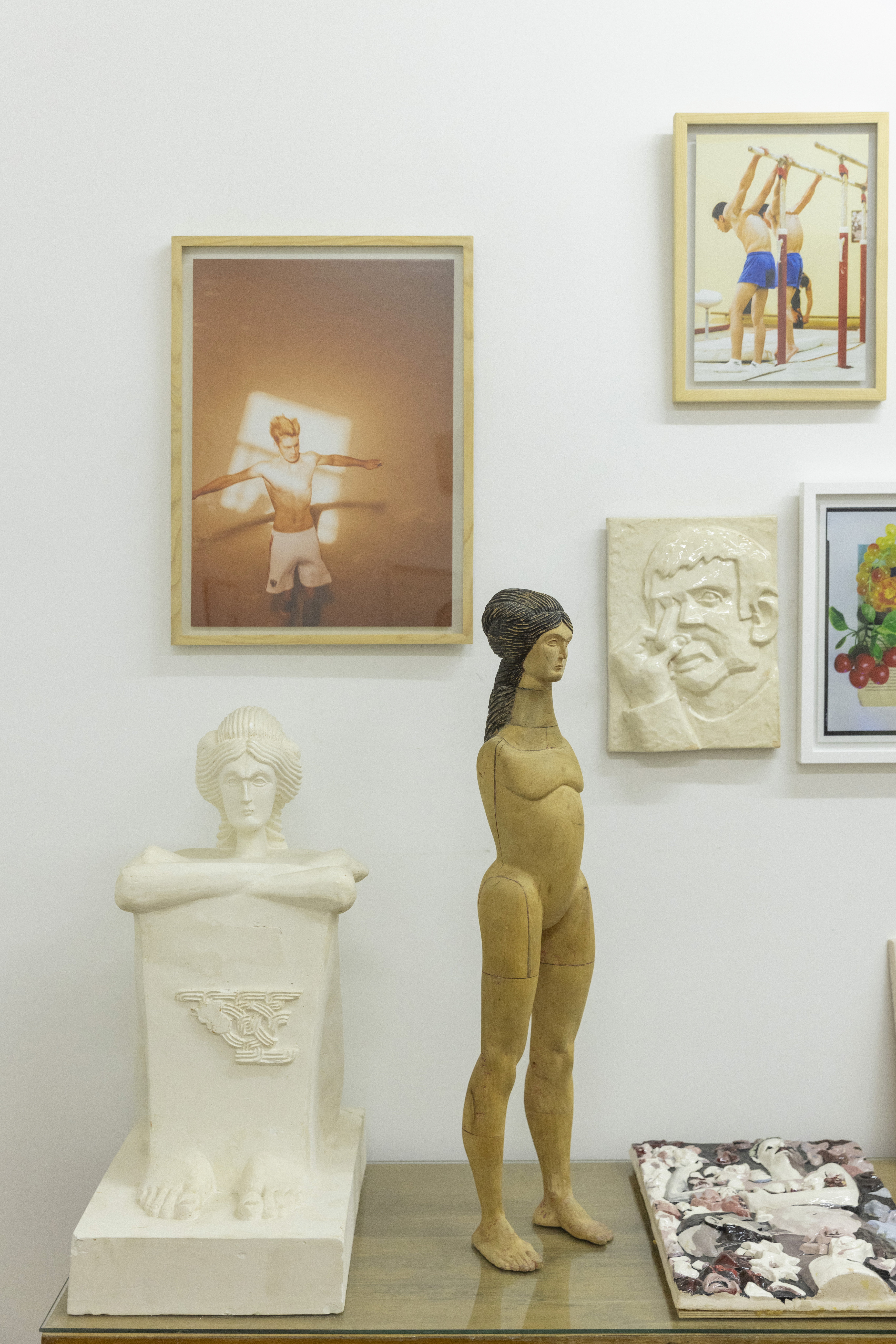
Detail from the Art Collection of Irena Popiashvili, Tbilisi, Georgia, 2025.
Photo credit: Guram Kapanadze.
Photo credit: Guram Kapanadze.
From managing a gallery in New York to spearheading transformative projects in Tbilisi, Irena Popiashvili has cultivated spaces for dialogue, growth, and creative experimentation. Through initiatives like VA[A]DS, the Popiashvili Gvaberidze Window Project, and Kunsthalle Tbilisi, Popiashvili continues to nurture new possibilities and expand the landscape of Georgian contemporary art from grassroots to the global stage. Philanthropy is central to her work, as she supports artists by fostering access to new opportunities and contributing to the creation of more cultural infrastructures. Popiashvili’s path, however, has been shaped not by ease but by a vision and deep belief in the power of art to transcend boundaries and transform communities. In the following conversation with Nicola Trezzi for ZETTAI, she reflects on her experiences—past, present, and still in the making.
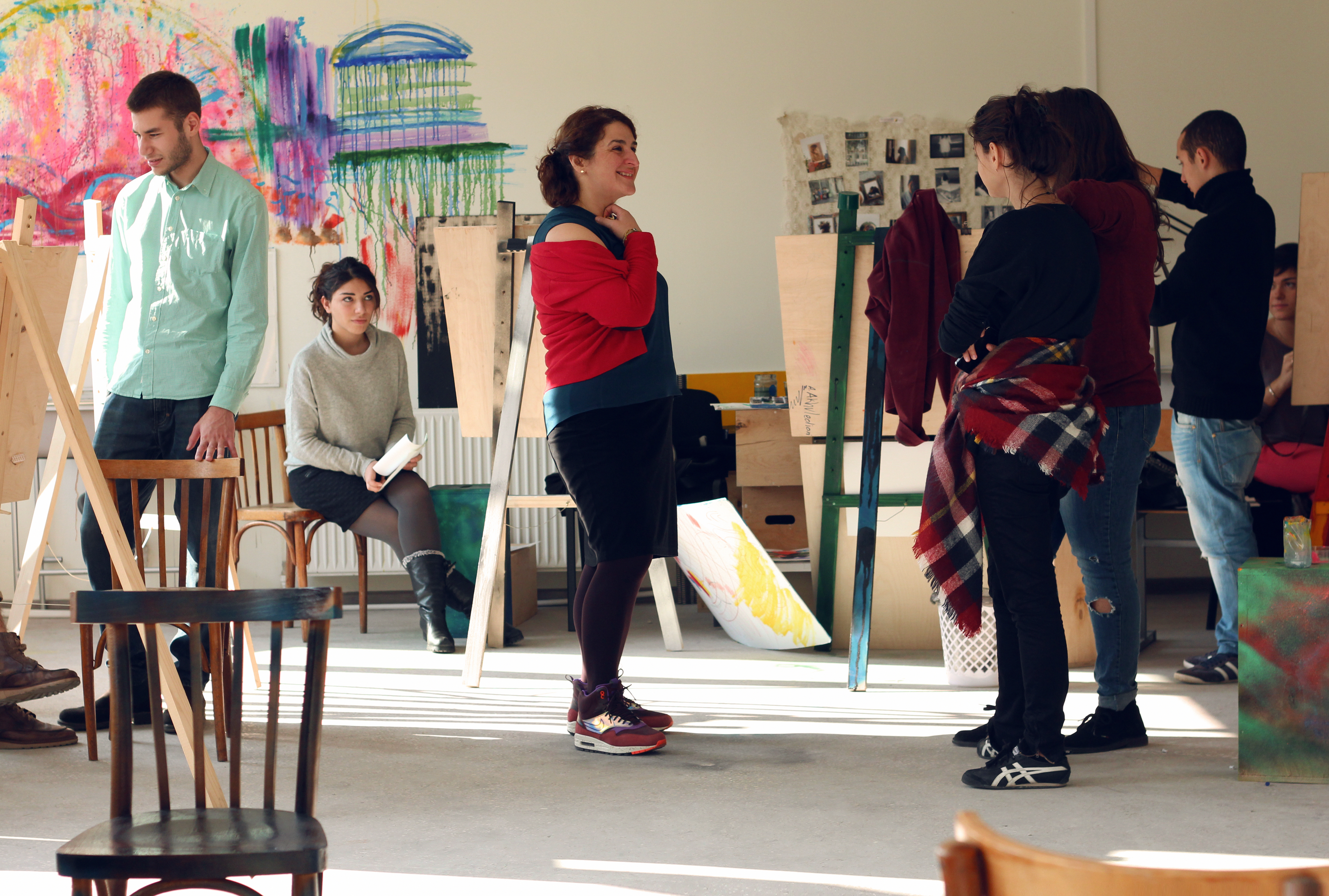
Irena Popiashvili, founder of VA[A]DS (Visual Art, Architecture, and Design School) at the Free University of Tbilisi, Georgia, 2014.
Photo credit: Davit Giorgadze.
Photo credit: Davit Giorgadze.
NT: You were among the first to exhibit the work of Slavs and Tatars, who I also interviewed for ZETTAI. How deeply has their practice influenced your way of looking at art and culture?
IP: I discovered Slavs and Tatars at the New York Print Fair in 2008. They were not known at all back then. The fair was at the old Dia Art Foundation building on 22nd Street, and I was going up the stairs to the fair when I saw a poster, Men are from Murmansk, Women are from Vilnius, hanging on the stairway. The references made to the former USSR cities made me laugh. I was humored, curious, and decidedly went to look for the Slavs and Tatars stand, where I met Payam [Sharifi] and Kasia [Korczak]. I invited them to visit me at the gallery, and we opened their first New York solo exhibition in 2009, “A Thirteenth Month Against Time.”
It was great. MoMA bought their work and offered them a solo exhibition. I collaborated with them again in 2023 for a Kunsthalle Tbilisi exhibition alongside Giorgi Khaniashvili at Atinati’s Cultural Center.
IP: I discovered Slavs and Tatars at the New York Print Fair in 2008. They were not known at all back then. The fair was at the old Dia Art Foundation building on 22nd Street, and I was going up the stairs to the fair when I saw a poster, Men are from Murmansk, Women are from Vilnius, hanging on the stairway. The references made to the former USSR cities made me laugh. I was humored, curious, and decidedly went to look for the Slavs and Tatars stand, where I met Payam [Sharifi] and Kasia [Korczak]. I invited them to visit me at the gallery, and we opened their first New York solo exhibition in 2009, “A Thirteenth Month Against Time.”
It was great. MoMA bought their work and offered them a solo exhibition. I collaborated with them again in 2023 for a Kunsthalle Tbilisi exhibition alongside Giorgi Khaniashvili at Atinati’s Cultural Center.

Koka Ramishvili,
Mtatsminda, 2021,
Digital print, ED 1/4 2 AP,
76 x 100 cm.
Photo credit: Guram Kapanadze.
Digital print, ED 1/4 2 AP,
76 x 100 cm.
Photo credit: Guram Kapanadze.
NT: After spending time in New York, you then returned to Georgia. You transitioned from the commercial sector—although your gallery was very experimental and intellectual—to the academic world. Can you tell us about your adventure in this field?
IP: Marisa Newman and I have organized some great exhibitions that I am very proud of. We presented the first two solo exhibitions of Raul de Nieves, and the first New York solo exhibitions of Basim Magdy, Jorge Peris, and Alberto Tadiello. But, moving back to Georgia in 2012 was a significant change, both culturally and academically. I was appointed rector of the Tbilisi State Academy of Arts, becoming the first woman in the institution’s nearly 100-year history to hold the position, and the second, after the founder, who was not an artist. Although my tenure at the Academy was brief, I had gained valuable insight into navigating that world by the time I was invited by the founder of the Free University of Tbilisi to establish a new art school: VA[A]DS, the Visual Arts and Design School.
IP: Marisa Newman and I have organized some great exhibitions that I am very proud of. We presented the first two solo exhibitions of Raul de Nieves, and the first New York solo exhibitions of Basim Magdy, Jorge Peris, and Alberto Tadiello. But, moving back to Georgia in 2012 was a significant change, both culturally and academically. I was appointed rector of the Tbilisi State Academy of Arts, becoming the first woman in the institution’s nearly 100-year history to hold the position, and the second, after the founder, who was not an artist. Although my tenure at the Academy was brief, I had gained valuable insight into navigating that world by the time I was invited by the founder of the Free University of Tbilisi to establish a new art school: VA[A]DS, the Visual Arts and Design School.

Giorgi Khaniashvili, Family Portrait, 2007,
Mud, glue on cardboard,
120 x 100 cm.
Photo credit: Guram Kapanadze.
NT: I am actually interested in knowing how you navigate the academic field and its restrictions, especially after being independent for so long.
IP: My move was partly due to personal reasons, but driven by a desire to improve the arts education in Georgia. The same year, I was curating an exhibition at the National Gallery in Tbilisi called “Reframing the 80s,” an exhibition on Georgian art from the end of the ’80s to the beginning of the ’90s. While working on the show, I was still living in New York and would travel to Georgia for research and to locate artwork from that period. As much as I wanted the exhibition to have an impact on the public, it became clear to me that education was the only thing capable of creating change in how contemporary art was publicly perceived. However, the education system that I encountered in Georgia was obsolete and completely out of touch with reality.
The VA[A]DS school at the Free University is now nearly ten years old. I collaborated with the university’s administrative team and a talented group of professionals in Tbilisi to design the initial program. Over the years, the curriculum has been continuously adjusted and improved, evolving based on my experiences with students and visiting professors. I am fortunate to have worked with the best artists and designers at the school, and I have had creative freedom from the university regarding the selection of instructors. In a way, I am curating the educators who guide the new generation of Georgian artists and designers. Additionally, the architecture program, created by my colleague Jesse Vogler, who relocated from the U.S. to Georgia, has become a very successful and integral part of the school.
IP: My move was partly due to personal reasons, but driven by a desire to improve the arts education in Georgia. The same year, I was curating an exhibition at the National Gallery in Tbilisi called “Reframing the 80s,” an exhibition on Georgian art from the end of the ’80s to the beginning of the ’90s. While working on the show, I was still living in New York and would travel to Georgia for research and to locate artwork from that period. As much as I wanted the exhibition to have an impact on the public, it became clear to me that education was the only thing capable of creating change in how contemporary art was publicly perceived. However, the education system that I encountered in Georgia was obsolete and completely out of touch with reality.
The VA[A]DS school at the Free University is now nearly ten years old. I collaborated with the university’s administrative team and a talented group of professionals in Tbilisi to design the initial program. Over the years, the curriculum has been continuously adjusted and improved, evolving based on my experiences with students and visiting professors. I am fortunate to have worked with the best artists and designers at the school, and I have had creative freedom from the university regarding the selection of instructors. In a way, I am curating the educators who guide the new generation of Georgian artists and designers. Additionally, the architecture program, created by my colleague Jesse Vogler, who relocated from the U.S. to Georgia, has become a very successful and integral part of the school.

Sabine Hornig; Layout for a Sculpture 2, 2023.
Pigment Print and handprinted Silkscreen on Archival Paper; 56 x 56 cm; Edition of 10 + 3 AP - this is AP 1/10.
© Sabine Hornig and VG Bild-Kunst, Bonn Germany.
NT: In parallel with that, you also established Kunsthalle Tbilisi. Tell us about this nomadic institution, its mission, and its vision.
IP: One of the first things I did after my time at the Academy was open the Popiashvili Gvaberidze Window Project. I was showing art—new art—in the vitrine on Rustaveli Avenue in the center of the city. Inspired by the Wrong Gallery in New York, I began exhibiting young artists in the windows of Tbilisi. At some point, we had five locations in the city, as the owners of empty storefronts would sometimes offer their spaces free of charge. It was an exciting and innovative way to attract a wider audience and spotlight new names and emerging artists. However, after four years of the Window Project, I decided to end my collaboration with Tamuna Gvaberidze and start Kunsthalle Tbilisi.
There is no contemporary art museum in Tbilisi, and there are never-ending discussions about having a museum. This discourse is somehow always about the building of the museum rather than its mission and programming. I was reading about the European Kunsthalle that Nicolaus Schafhausen and Vanessa Joan Müller started from a specific situation—the demolition of the Josef-Haubrich-Forum in the city center of Cologne—and with no permanent space. I liked the idea of having a roving space. There had also been several artistic projects in Tbilisi on a non-existent museum of contemporary art, so I decided to use the name “kunsthalle” instead of museum. The idea was to do two-person exhibitions featuring Georgian and international artists in parallel exhibitions. I felt that this way would be the most beneficial to the Tbilisi art scene—to see the exhibition of international artists while simultaneously contextualizing the work of Georgian artists placed in dialogue with them.
The first project was Nika Kutateladze’s “Watermill on Former Pavlov Street,” held in a first-floor apartment of a Khrushchev-era building. The artist bought a dysfunctional watermill from the mountains of Guria in western Georgia, and installed it inside the apartment with the front of the watermill protruding from the façade of the Khrushchevka. The exhibition parallel to this was Angelica Mesiti’s “Relay League,” presented by Protocinema and hosted by Kunsthalle Tbilisi.
IP: One of the first things I did after my time at the Academy was open the Popiashvili Gvaberidze Window Project. I was showing art—new art—in the vitrine on Rustaveli Avenue in the center of the city. Inspired by the Wrong Gallery in New York, I began exhibiting young artists in the windows of Tbilisi. At some point, we had five locations in the city, as the owners of empty storefronts would sometimes offer their spaces free of charge. It was an exciting and innovative way to attract a wider audience and spotlight new names and emerging artists. However, after four years of the Window Project, I decided to end my collaboration with Tamuna Gvaberidze and start Kunsthalle Tbilisi.
There is no contemporary art museum in Tbilisi, and there are never-ending discussions about having a museum. This discourse is somehow always about the building of the museum rather than its mission and programming. I was reading about the European Kunsthalle that Nicolaus Schafhausen and Vanessa Joan Müller started from a specific situation—the demolition of the Josef-Haubrich-Forum in the city center of Cologne—and with no permanent space. I liked the idea of having a roving space. There had also been several artistic projects in Tbilisi on a non-existent museum of contemporary art, so I decided to use the name “kunsthalle” instead of museum. The idea was to do two-person exhibitions featuring Georgian and international artists in parallel exhibitions. I felt that this way would be the most beneficial to the Tbilisi art scene—to see the exhibition of international artists while simultaneously contextualizing the work of Georgian artists placed in dialogue with them.
The first project was Nika Kutateladze’s “Watermill on Former Pavlov Street,” held in a first-floor apartment of a Khrushchev-era building. The artist bought a dysfunctional watermill from the mountains of Guria in western Georgia, and installed it inside the apartment with the front of the watermill protruding from the façade of the Khrushchevka. The exhibition parallel to this was Angelica Mesiti’s “Relay League,” presented by Protocinema and hosted by Kunsthalle Tbilisi.
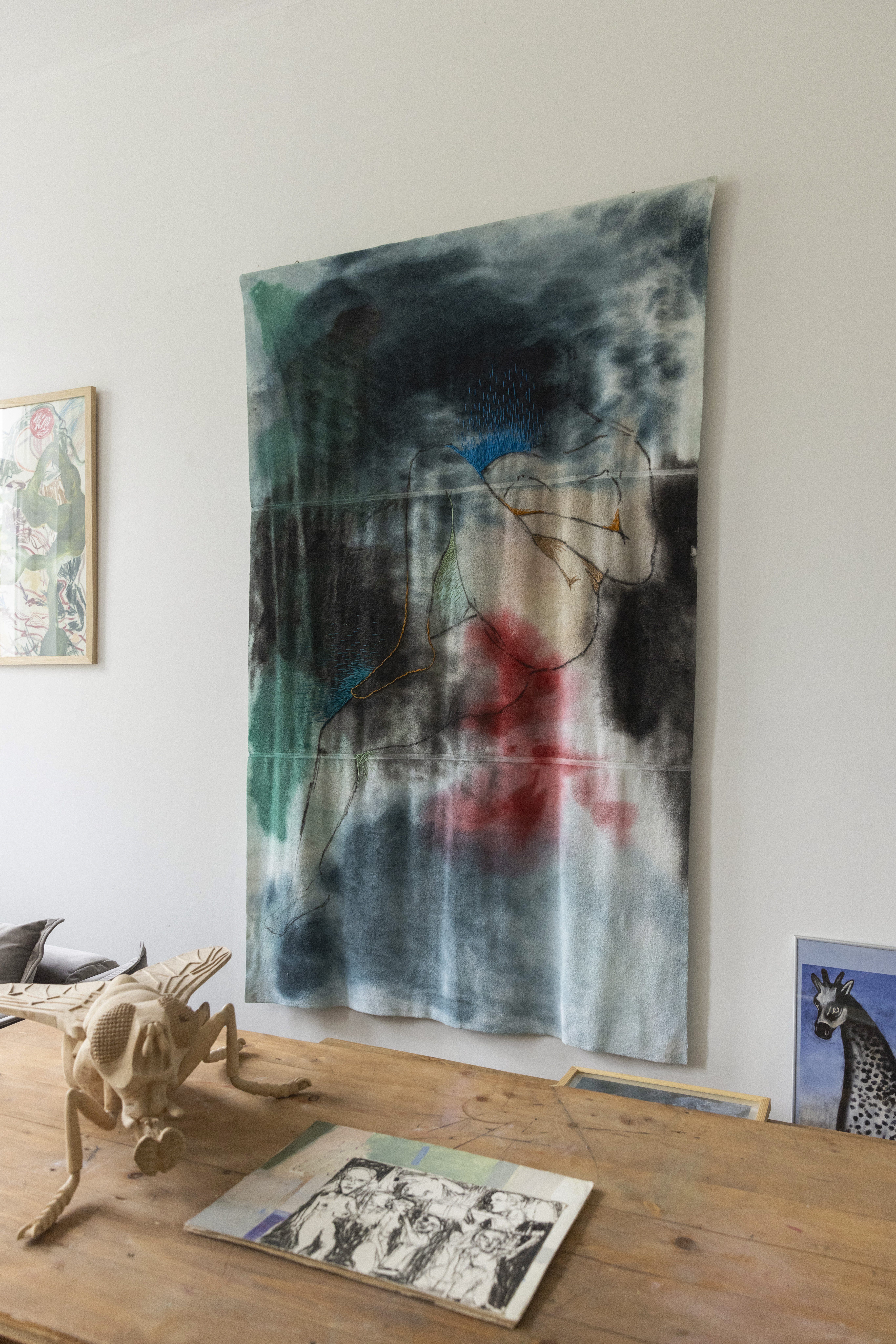
On the table: Giorgi Khaniashvili, Fly, 2016, wood sculpture; Karlo Kacharava, drawings.
Photo credit: Guram Kapanadze.
NT: Despite the current political climate, Tbilisi remains one of the most interesting cities in Europe, and by saying “in Europe,” I am making a political statement. Could you speak about the local Georgian art scene beyond international players like Andro Wekua and Thea Djordjadze?
IP: It’s interesting that you’re underlining “in Europe” as a political statement. Nika Kutateladze’s Watermill project caught the attention of Thomas Delamarre, then curator of the Cartier Foundation, and was invited to participate in the exhibition “Metamorphosis. Art in Europe Now”—but a Georgian artist being part of a European exhibition was questioned by some people; “is Georgia part of Europe?” was their question!
The local scene in Tbilisi has gone through a major transformation since 2012. VA[A]DS played a pivotal role in that change and, of course, the emergence of independent galleries like Gallery Artbeat, Patara Gallery, E.A. Shared Space, Gallery 4710, LC Queisser, and initiatives like the Tbilisi Architecture Biennale, Kurorti, Window Project, and Kunsthalle Tbilisi helped to cultivate a vibrant art scene in the city. I call it a grassroots movement, as it was not assisted or encouraged by government agencies or the country’s cultural policy. When you visit Tbilisi now, you will see thriving, contemporary art exhibitions in a juxtaposed coexistence with the world of Soviet-style artists as promoted by the Ministry of Culture. The National Gallery is under the ministry’s control and requires whoever wishes to do an exhibition there to apply with a proposal. They review the proposals, and the “winners” are given three-four week exhibitions at the museum. That’s why artists like Thea Gvetadze, Vajiko Chachkhiani, Nika Kutateladze, Nina Kintsurashvili, Maia Naveriani, Nino Kvrivishvili, Salome Dumbadze, Lado Lomitashvili, and Qeu Meparishvili, Ana Gzirishvili, Levan Chelidze among others, can be seen only in the galleries or through studio visits.
IP: It’s interesting that you’re underlining “in Europe” as a political statement. Nika Kutateladze’s Watermill project caught the attention of Thomas Delamarre, then curator of the Cartier Foundation, and was invited to participate in the exhibition “Metamorphosis. Art in Europe Now”—but a Georgian artist being part of a European exhibition was questioned by some people; “is Georgia part of Europe?” was their question!
The local scene in Tbilisi has gone through a major transformation since 2012. VA[A]DS played a pivotal role in that change and, of course, the emergence of independent galleries like Gallery Artbeat, Patara Gallery, E.A. Shared Space, Gallery 4710, LC Queisser, and initiatives like the Tbilisi Architecture Biennale, Kurorti, Window Project, and Kunsthalle Tbilisi helped to cultivate a vibrant art scene in the city. I call it a grassroots movement, as it was not assisted or encouraged by government agencies or the country’s cultural policy. When you visit Tbilisi now, you will see thriving, contemporary art exhibitions in a juxtaposed coexistence with the world of Soviet-style artists as promoted by the Ministry of Culture. The National Gallery is under the ministry’s control and requires whoever wishes to do an exhibition there to apply with a proposal. They review the proposals, and the “winners” are given three-four week exhibitions at the museum. That’s why artists like Thea Gvetadze, Vajiko Chachkhiani, Nika Kutateladze, Nina Kintsurashvili, Maia Naveriani, Nino Kvrivishvili, Salome Dumbadze, Lado Lomitashvili, and Qeu Meparishvili, Ana Gzirishvili, Levan Chelidze among others, can be seen only in the galleries or through studio visits.
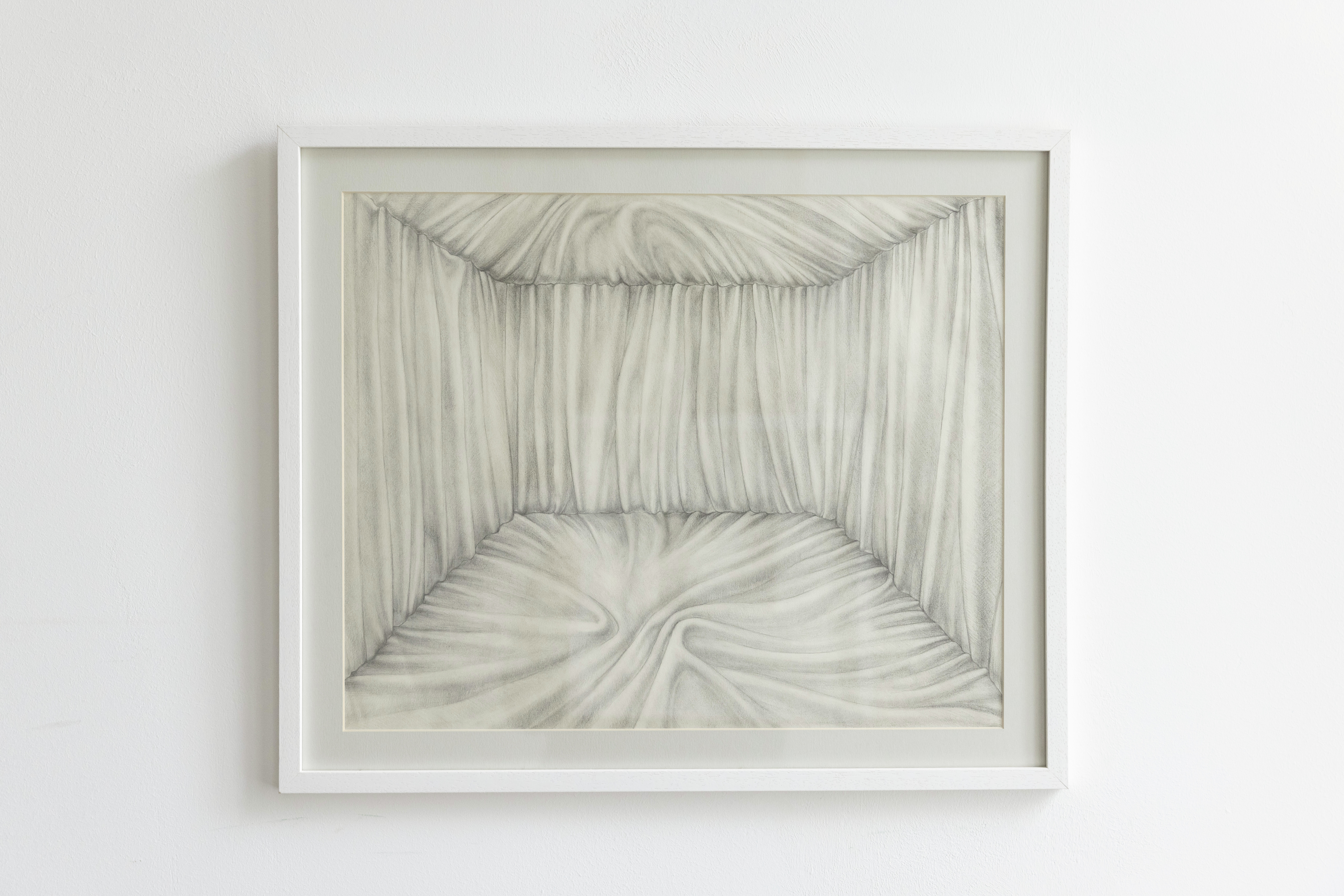
Tamar Nadiradze, Untitled, 2021,
Graphite on paper,
40 x 50 cm.
Photo credit: Guram Kapanadze.
NT: With such a scene, you started to collect works by young artists—something I would describe as a form of patronage that feels especially vital now. Have you always been collecting? Do you think that collecting can be a form of activism?
IP: I remember years ago, I was invited by the Brooklyn Museum to give a talk about a piece from their permanent collection. My criterion for selecting the piece was that it was something I wished to live with and have in my own collection. It was an exercise in “collecting,” as later, having the gallery, there were the artists I worked with—Marcia Hafif and Paul Bloodgood come to mind—whose work I loved and wished I could own but could never afford. I did manage, however, to buy a drawing by Tyson Reeder from Daniel Reich Gallery. In Tbilisi, I started discovering young artists who were invisible to collectors and other gallerists. Buying their work became a way of seeing them, acknowledging them. And yes, I guess you can say that gesture became a form of support-activism. There was one artist who commuted from Gori to Tbilisi when she was studying at the art academy. Her work stood out to me, and I started buying her drawings. They weren’t expensive, and I would buy them even when I didn’t particularly like them because I knew that she needed the money. Meanwhile, she has now become an artist whose work is quite in demand, and I do own a lot of her work today.
IP: I remember years ago, I was invited by the Brooklyn Museum to give a talk about a piece from their permanent collection. My criterion for selecting the piece was that it was something I wished to live with and have in my own collection. It was an exercise in “collecting,” as later, having the gallery, there were the artists I worked with—Marcia Hafif and Paul Bloodgood come to mind—whose work I loved and wished I could own but could never afford. I did manage, however, to buy a drawing by Tyson Reeder from Daniel Reich Gallery. In Tbilisi, I started discovering young artists who were invisible to collectors and other gallerists. Buying their work became a way of seeing them, acknowledging them. And yes, I guess you can say that gesture became a form of support-activism. There was one artist who commuted from Gori to Tbilisi when she was studying at the art academy. Her work stood out to me, and I started buying her drawings. They weren’t expensive, and I would buy them even when I didn’t particularly like them because I knew that she needed the money. Meanwhile, she has now become an artist whose work is quite in demand, and I do own a lot of her work today.
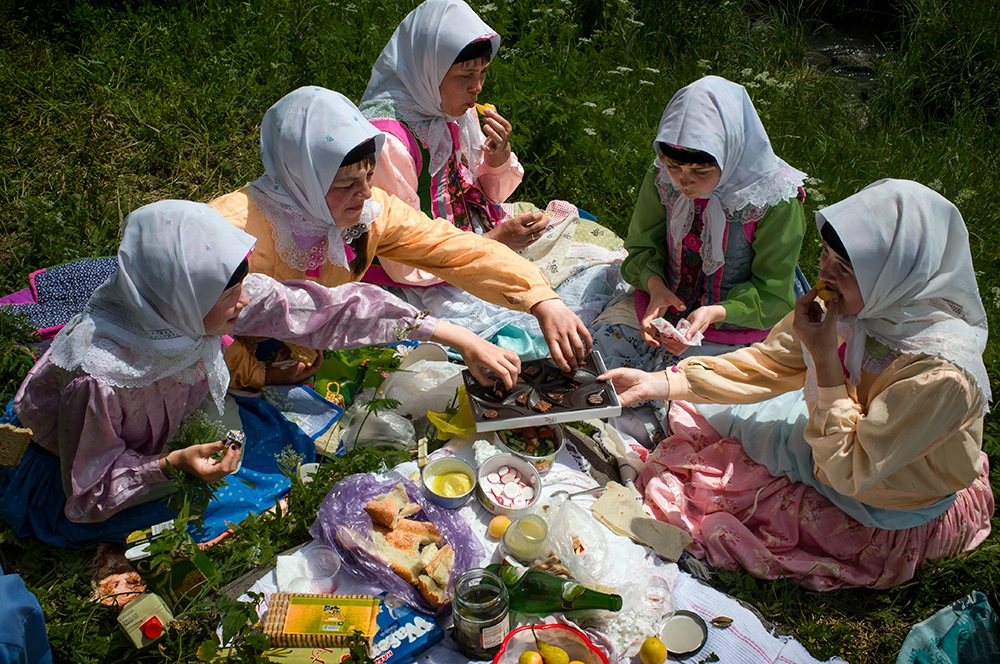
Natela Grigalashvili, The Doukhobors' Land, 2013
Digital print, edition of 1/7.
NT: Again, on collecting: do you have a particular focus? Where do you buy from? What are the parameters that define your actions? Do you feel that the way you collect is different from a more conventional one? And if so, why?
IP: The first artwork I bought in Tbilisi was a painting by Tutu Kiladze that I saw at the Book Corner Café. I never could have imagined that I’d buy art from a café, but the painting was good and caught my eye. I got to meet the artist later on. I don’t think of myself as a collector, but the reality is that I do buy art. When I like the work, it sticks in my mind—I keep thinking about it, and I always go back to buy it.
Your question made me think about the systematization of “my collection.” I have paintings, photographs, sculptures, and design objects. I do not collect thematically or by the artist’s nationality. There is a lot of revision that still needs to be done in Georgian art history of the 20th century. Like everywhere else in the 20th century, it was mostly only male painters who received official recognition, and many artists, such as Emma Zarkhutsi, were ignored or forgotten. In my collection, I have works by artists that I have ‘re-discovered’, young artists that I ‘discovered’, and acclaimed artists or designers whose work I have long coveted.
And of course, collecting is always about the budget, or, essentially, what you can afford to buy. At art fairs, I often play this game—”If the money wasn’t an issue what would I buy?” As far as Georgian collectors go, my collection stands out because I don’t have the usual suspects of the 20th century.
IP: The first artwork I bought in Tbilisi was a painting by Tutu Kiladze that I saw at the Book Corner Café. I never could have imagined that I’d buy art from a café, but the painting was good and caught my eye. I got to meet the artist later on. I don’t think of myself as a collector, but the reality is that I do buy art. When I like the work, it sticks in my mind—I keep thinking about it, and I always go back to buy it.
Your question made me think about the systematization of “my collection.” I have paintings, photographs, sculptures, and design objects. I do not collect thematically or by the artist’s nationality. There is a lot of revision that still needs to be done in Georgian art history of the 20th century. Like everywhere else in the 20th century, it was mostly only male painters who received official recognition, and many artists, such as Emma Zarkhutsi, were ignored or forgotten. In my collection, I have works by artists that I have ‘re-discovered’, young artists that I ‘discovered’, and acclaimed artists or designers whose work I have long coveted.
And of course, collecting is always about the budget, or, essentially, what you can afford to buy. At art fairs, I often play this game—”If the money wasn’t an issue what would I buy?” As far as Georgian collectors go, my collection stands out because I don’t have the usual suspects of the 20th century.
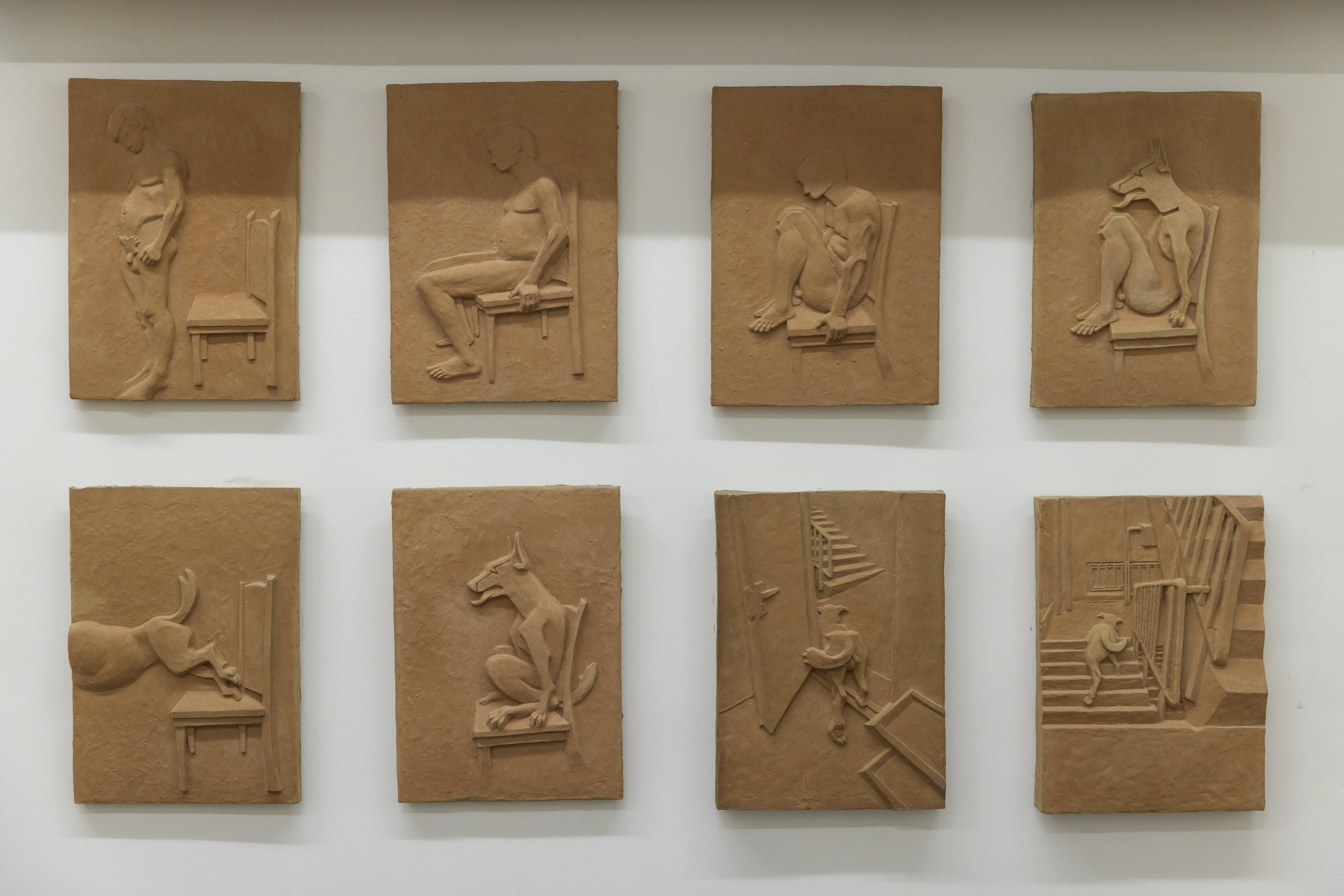
Giorgi Khaniashvili, Transformation, 2017,
8 Clay reliefs, 40 x 30 cm each.
Photo credit: Guram Kapanadze.
NT: Who are the figures in the field of contemporary art that inspire you or with whom you identify? Who are your heroes? You have acted from several points of view thus far: gallerist, curator, educator, and also collector... Which of these roles feels most central to you, if any?
IP: I have numerous role models: Marian Goodman as my ideal gallerist, Elena Filipovic as a curator, Olaf Nicolai as both an artist and educator, and Wilfried Cooreman as a collector.
When I lived in New York, the Newman Popiashvili Gallery represented Michel Auder. Soon after we started collaborating with him, he received an invitation to teach at Yale. He was exceptional with his students, who admired him deeply. I used to often tell him that I wanted to be him when I grew up, and in a way, my wish did come true. I’ve had the privilege of working with many inspiring artists, and reflecting on it, I realize that Marcia Hafif, Paul Bloodgood, and Lynne Golob Gelfman have profoundly influenced me. I consider myself very fortunate for the people I’ve met and the places my life has taken me.
IP: I have numerous role models: Marian Goodman as my ideal gallerist, Elena Filipovic as a curator, Olaf Nicolai as both an artist and educator, and Wilfried Cooreman as a collector.
When I lived in New York, the Newman Popiashvili Gallery represented Michel Auder. Soon after we started collaborating with him, he received an invitation to teach at Yale. He was exceptional with his students, who admired him deeply. I used to often tell him that I wanted to be him when I grew up, and in a way, my wish did come true. I’ve had the privilege of working with many inspiring artists, and reflecting on it, I realize that Marcia Hafif, Paul Bloodgood, and Lynne Golob Gelfman have profoundly influenced me. I consider myself very fortunate for the people I’ve met and the places my life has taken me.

Detail from the Art Collection of Irena Popiashvili, Tbilisi, Georgia, 2025.
Photo credit: Guram Kapanadze.
NT: What makes Georgian contemporary art so special? Can you outline its uniqueness? Do you think Georgia’s historical past or mythical heritage is influencing its artists, and if so, how?
IP: What makes the work of Georgian artists particularly special is the kind of materials they use. It’s often recycled, unpolished objects; there’s less attention concerning the traditional “quality” of materials. Partially, this situation arises from a lack of dedicated art supply stores, framing services, or photo and production labs in Tbilisi. As a result, artists often source their materials from the Eliava Market, a sprawling bazaar that has been a notable landmark in Tbilisi since the mid-1990s. Specializing in inexpensive construction and repair materials, the Eliava Market is often described as a place that "sells the Soviet past," as British journalist Andrew North noted in his series of drawings and sound recordings. I believe the market has significantly influenced the visual language of local contemporary art. The technologies and materials used along with the uniqueness of ideas and concepts, I would argue, are what contribute to the distinctiveness of the Georgian art scene.
IP: What makes the work of Georgian artists particularly special is the kind of materials they use. It’s often recycled, unpolished objects; there’s less attention concerning the traditional “quality” of materials. Partially, this situation arises from a lack of dedicated art supply stores, framing services, or photo and production labs in Tbilisi. As a result, artists often source their materials from the Eliava Market, a sprawling bazaar that has been a notable landmark in Tbilisi since the mid-1990s. Specializing in inexpensive construction and repair materials, the Eliava Market is often described as a place that "sells the Soviet past," as British journalist Andrew North noted in his series of drawings and sound recordings. I believe the market has significantly influenced the visual language of local contemporary art. The technologies and materials used along with the uniqueness of ideas and concepts, I would argue, are what contribute to the distinctiveness of the Georgian art scene.
Archival pigment print on Hahnemühle Baryta paper,
Edition 1/3.
28.5 × 40 cm.
NT: Do you think that young Georgian artists are addressing political issues?
IP: They are not directly addressing political issues, which is what the general public expects—there’s a reason why Pussy Riot hasn’t emerged here. However, the Bouillon Group, a Georgian artist collective, comes closest to tackling these political themes in their performances. Also, the last show at Kunsthalle Tbilisi, “Conspiracy Bar,” was dedicated to the recent and ongoing protests in Georgia. “Conspiracy Bar” is a space that represents the imaginary apartment of a young dweller in Tbilisi. Around the Studio (Tika Shelia and Ano Jishkariani) created a living space filled with objects referencing the recent history of demonstrations in the city. The objects and demonstration furniture designed by the artists, served as visual cues narrating the story of the 2023-2024 protests and the memories of the apartment’s fictional residents. Following the Georgian government’s enactment of a controversial “foreign influence” law, massive protests ensued, followed by a violent crackdown. More recently, Georgia’s parliament passed an anti-LGBTQ propaganda law, imposing severe restrictions on LGBTQ+ freedoms and rights, echoing similar legislation passed in Russia.
IP: They are not directly addressing political issues, which is what the general public expects—there’s a reason why Pussy Riot hasn’t emerged here. However, the Bouillon Group, a Georgian artist collective, comes closest to tackling these political themes in their performances. Also, the last show at Kunsthalle Tbilisi, “Conspiracy Bar,” was dedicated to the recent and ongoing protests in Georgia. “Conspiracy Bar” is a space that represents the imaginary apartment of a young dweller in Tbilisi. Around the Studio (Tika Shelia and Ano Jishkariani) created a living space filled with objects referencing the recent history of demonstrations in the city. The objects and demonstration furniture designed by the artists, served as visual cues narrating the story of the 2023-2024 protests and the memories of the apartment’s fictional residents. Following the Georgian government’s enactment of a controversial “foreign influence” law, massive protests ensued, followed by a violent crackdown. More recently, Georgia’s parliament passed an anti-LGBTQ propaganda law, imposing severe restrictions on LGBTQ+ freedoms and rights, echoing similar legislation passed in Russia.
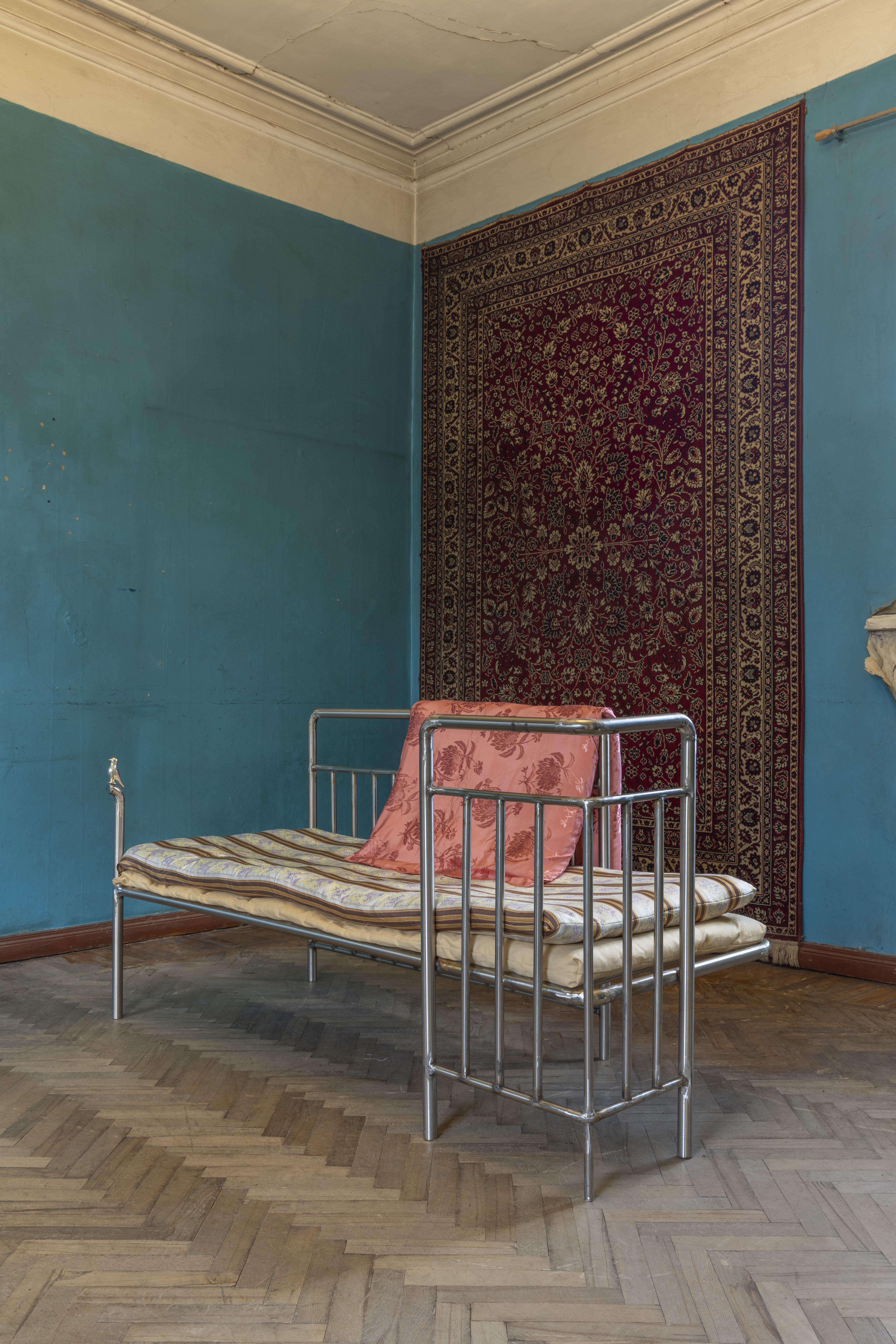
Around the Studio's installation "Conspiracy Bar" at Kunsthalle Tbilisi, 2024.
NT: Could you tell us about a future project you are working on that reflects the future directions you’re currently heading in?
IP: I am interested in post-Soviet art education and its outcomes in the former Soviet republics. I am trying to get to know the art scenes in neighboring countries and to find connections between the younger generation of artists. I curated a show titled “New Beginnings” at the Tbilisi Art Fair, where I included artists from Armenia, Azerbaijan, Kazakhstan, and Belarus. If the political situation allows me to travel more, I would like to continue this research and organize more shows featuring artists from those respective regions. Through this process, I am not only discovering emerging young artists but also learning about unofficial, underground artists from neighboring countries. Among the most notable discoveries for me have been Armenian artists Hamlet Hovsepian and Kima Gyarakyan, a young, emerging artist from Yerevan.
IP: I am interested in post-Soviet art education and its outcomes in the former Soviet republics. I am trying to get to know the art scenes in neighboring countries and to find connections between the younger generation of artists. I curated a show titled “New Beginnings” at the Tbilisi Art Fair, where I included artists from Armenia, Azerbaijan, Kazakhstan, and Belarus. If the political situation allows me to travel more, I would like to continue this research and organize more shows featuring artists from those respective regions. Through this process, I am not only discovering emerging young artists but also learning about unofficial, underground artists from neighboring countries. Among the most notable discoveries for me have been Armenian artists Hamlet Hovsepian and Kima Gyarakyan, a young, emerging artist from Yerevan.
S O U N D
Ghosts, Radio Waves, Spiritualism and Contextualism in the Art
of Aki Onda
Written by Kurt Gottschalk
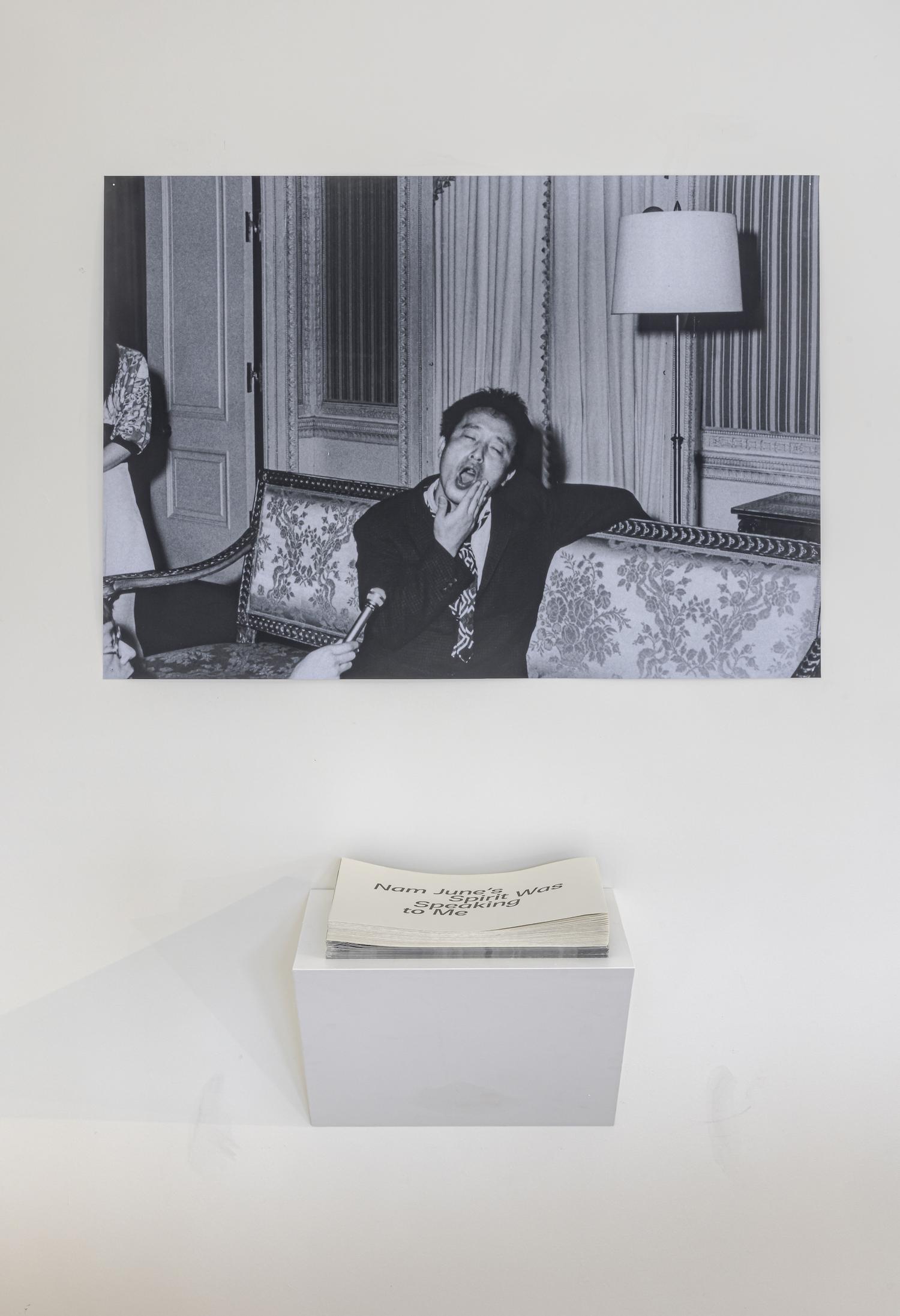
Toronto Biennial of Art,
March 26 ‒ June 5, 2022,
Photograph by Toni Hafkenscheid.
Kurt Gottschalk talks to Aki Onda about channeling the spirit of Nam June Paik, offering a glimpse into an artist whose work defies easy categorization. Part archivist, part composer, part medium, Onda collects and frames sounds, images, and ideas—sometimes received through radio transmissions he associates with Paik—without claiming to be an occultist, yet acknowledging the unlocatable, energetic forces that shape his practice.
Aki Onda is not an occultist. Or at least not a professional one.
He stressed this more than once during a Skype interview in July 2020, just days before moving his home and studio from New York City—where he’s lived for the last 17 years—to Mito in the Japanese prefecture of Ibaraki.
“I’m not into being a cult star. A mystic is fine, but I hate being a cult star,” he said with a laugh—Onda laughs a lot in conversation—but emphatically all the same, “It doesn’t make much money, and it’s connected to being an authority.”
While he’s not a purveyor of the supernatural, Onda is open to such ideas. If he weren’t, he wouldn’t have made—or, rather, wouldn’t have been able to receive—his new album, a collection of messages from the late Korean artist Nam June Paik.
“I always have something that’s hard to explain with language,” he continued. “When I do a performance or when I make something, I always feel like it comes from somewhere else, and I don’t know what it is. It’s something spiritual—but like I said, I don’t like to mystify things. I want to leave it open and share it with other people. I have the system, and I know how it works, but it’s hard to explain.”
He stressed this more than once during a Skype interview in July 2020, just days before moving his home and studio from New York City—where he’s lived for the last 17 years—to Mito in the Japanese prefecture of Ibaraki.
“I’m not into being a cult star. A mystic is fine, but I hate being a cult star,” he said with a laugh—Onda laughs a lot in conversation—but emphatically all the same, “It doesn’t make much money, and it’s connected to being an authority.”
While he’s not a purveyor of the supernatural, Onda is open to such ideas. If he weren’t, he wouldn’t have made—or, rather, wouldn’t have been able to receive—his new album, a collection of messages from the late Korean artist Nam June Paik.
“I always have something that’s hard to explain with language,” he continued. “When I do a performance or when I make something, I always feel like it comes from somewhere else, and I don’t know what it is. It’s something spiritual—but like I said, I don’t like to mystify things. I want to leave it open and share it with other people. I have the system, and I know how it works, but it’s hard to explain.”

Casa del Lago UNAM, México City.
June 1 - August 30, 2023.Photos by Enrique Macías Martínez.
Courtesy of Casa del Lago UNAM.
Onda’s systems aren’t any easier to explain for the observer. His art is as varied as it is unusual, from experimental projects with the likes of avant-garde cinema virtuoso Ken Jacobs and French jazz guitarist Noël Akchoté to atmospheric, improvised recordings with New York guitarist Alan Licht and Canadian sound and filmmaker Michael Snow, to film and photography, installation and performance.
And Onda, too, is an observer, a filmmaker and photographer, a curator, and a freeform documentarian. He deals more in ideas than forms or formats, and ideas come in different shapes and sizes.
Which is where Nam June Paik comes in. Onda had long been an admirer of the multimedia artist Paik, whose work with the New York Fluxus school in the 1960s anticipated installation and video art, and in a sense, presaged Onda’s own, eclectic art.
“His work is always interdisciplinary; he always combines different media,” Onda said of Paik. “The way he used imagination interests me. He was really into TV. He can transport ideas, and he doesn’t really care if the meaning behind them changes. He’s elusive, hard to pin down. He uses pop culture, but sometimes his work is really esoteric.”
And Onda, too, is an observer, a filmmaker and photographer, a curator, and a freeform documentarian. He deals more in ideas than forms or formats, and ideas come in different shapes and sizes.
Which is where Nam June Paik comes in. Onda had long been an admirer of the multimedia artist Paik, whose work with the New York Fluxus school in the 1960s anticipated installation and video art, and in a sense, presaged Onda’s own, eclectic art.
“His work is always interdisciplinary; he always combines different media,” Onda said of Paik. “The way he used imagination interests me. He was really into TV. He can transport ideas, and he doesn’t really care if the meaning behind them changes. He’s elusive, hard to pin down. He uses pop culture, but sometimes his work is really esoteric.”

Aki Onda “Cassette Memories” performance, Sokolowsko, 2018.
Photo Kazimierz Ździebło.
Onda is comfortable with the esoteric. Growing up in Japan, he was introduced to intellectual and avant-garde ideas from around the world. His father was a university field hockey coach, and his mother an artist. Art and literature were always around and took the place of formal schooling for him. A position as a visiting composer in the Electro-Acoustic Music Studio at Dartmouth College in New Hampshire made it possible for him to move to America. In 2003, he relocated to New York City and found Paik’s influence to be strong in the city’s fertile art scene. Through an accidental encounter, Onda even got to know Paik’s assistant and visited a storage space filled with Paik’s old television sets.
He never got the chance to meet the older artist, but in 2010, Onda was invited to do a residency at the Nam June Paik Art Center in Giheung District, Yongin City, South Korea. One night, back in his hotel in Seoul, he dialed into an unusual transmission on his radio. While he didn’t understand what the murmured voice was saying or even the origins of the sounds he was hearing, he had the feeling that a message was being sent to him.
“It was really out of the blue, but somehow I felt the sensation that Nam June Paik was speaking to me,” Onda said. “It’s hard to explain, just intuition, so I made a recording. I always carry a cassette Walkman that has a radio.”
He never got the chance to meet the older artist, but in 2010, Onda was invited to do a residency at the Nam June Paik Art Center in Giheung District, Yongin City, South Korea. One night, back in his hotel in Seoul, he dialed into an unusual transmission on his radio. While he didn’t understand what the murmured voice was saying or even the origins of the sounds he was hearing, he had the feeling that a message was being sent to him.
“It was really out of the blue, but somehow I felt the sensation that Nam June Paik was speaking to me,” Onda said. “It’s hard to explain, just intuition, so I made a recording. I always carry a cassette Walkman that has a radio.”

Video stills from Nam June Paik’s “Good Morning, Mr. Orwell”, 1984.
Courtesy Electronic Arts Intermix (EAI), New York (www.eai.org).
Courtesy Electronic Arts Intermix (EAI), New York (www.eai.org).
Two years later, Onda received another radio message, this time while doing a concert in Koln, Germany—where Paik had lived while studying with the composer Karlheinz Stockhausen, as it happens. The following year, two more were received, always through radio transmissions.
Onda started talking to people who work in radio, learning about mysterious transmissions, coded messages from government broadcasts, and other unusual sounds floating through the radio waves. But nobody could decipher the recordings he’d been collecting.
He elaborated in an email after our conversation.
“I just recalled this... when I was a teenager, I got interested in the 80s NY culture through [author and radio art pioneer] Tetsuo Kogawa’s books. I do not remember if I read about Paik in his books. But those definitely helped me to absorb the new media art scene and find Paik’s art. After receiving the first message from Paik in Seoul in 2010 and immediately recognizing it as a spiritual communication with him, then more messages later, I wasn’t sure why the radio was the medium and how it worked. The first person I consulted was Tetsuo Kogawa. He explained to me there have been numerous “secret broadcasts” on anonymous radio stations around the world, and many of those continued without apparent explanation. He also tried to analyze what the transmissions I received were but couldn’t figure it out—even though he has a vast knowledge of the radio, both historically and scientifically.”
Onda started talking to people who work in radio, learning about mysterious transmissions, coded messages from government broadcasts, and other unusual sounds floating through the radio waves. But nobody could decipher the recordings he’d been collecting.
He elaborated in an email after our conversation.
“I just recalled this... when I was a teenager, I got interested in the 80s NY culture through [author and radio art pioneer] Tetsuo Kogawa’s books. I do not remember if I read about Paik in his books. But those definitely helped me to absorb the new media art scene and find Paik’s art. After receiving the first message from Paik in Seoul in 2010 and immediately recognizing it as a spiritual communication with him, then more messages later, I wasn’t sure why the radio was the medium and how it worked. The first person I consulted was Tetsuo Kogawa. He explained to me there have been numerous “secret broadcasts” on anonymous radio stations around the world, and many of those continued without apparent explanation. He also tried to analyze what the transmissions I received were but couldn’t figure it out—even though he has a vast knowledge of the radio, both historically and scientifically.”
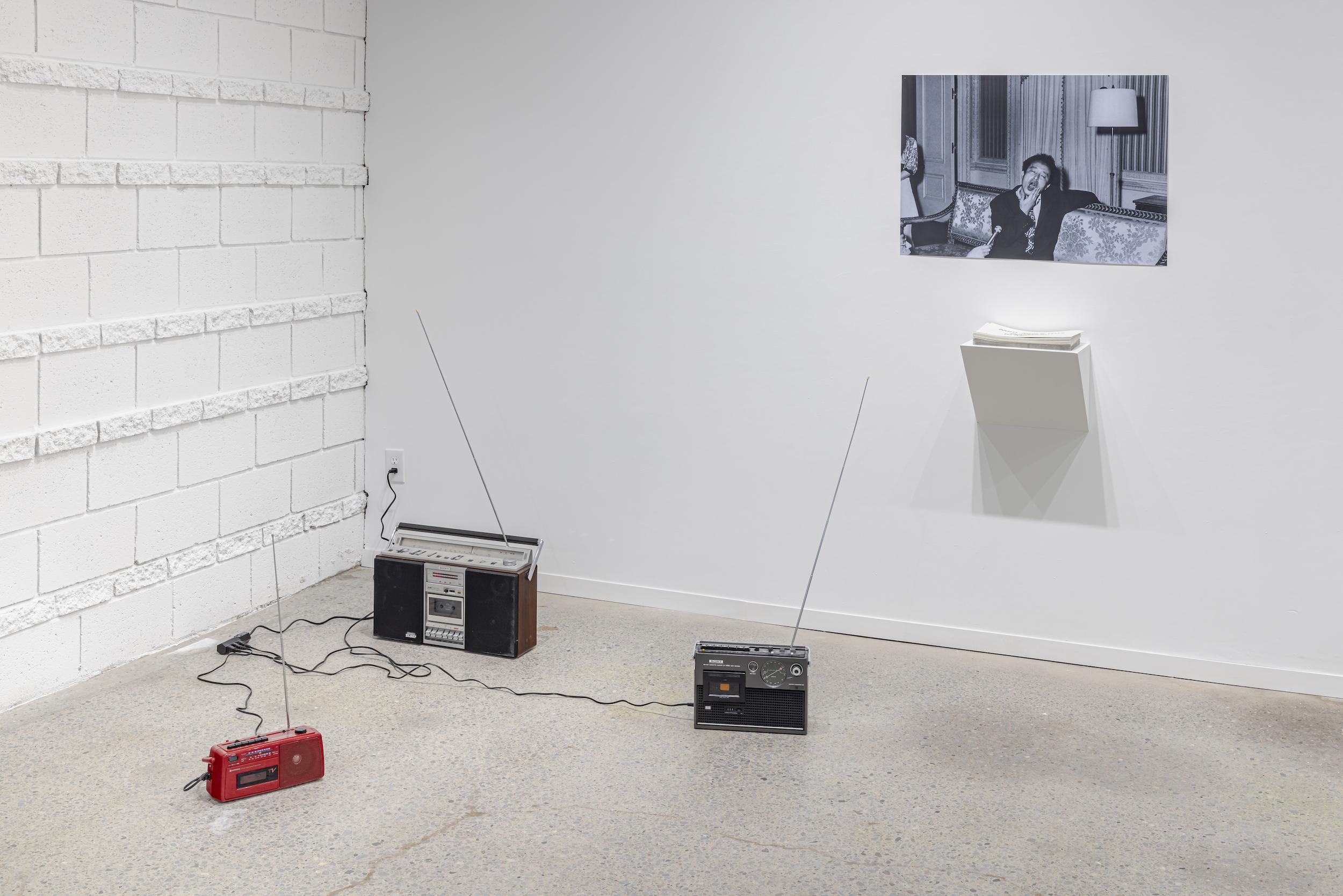
Toronto Biennial of Art,
March 26 ‒ June 5, 2022,
Photograph by Toni Hafkenscheid.
March 26 ‒ June 5, 2022,
Photograph by Toni Hafkenscheid.
By 2013, he had received four messages but wasn’t sure what, if anything, to do with them. Then in 2016 came a commission from documenta, the longstanding German art quinquennial. He performed at the festival the following year with sound artist Akio Suzuki and edited his Paik recordings for a radio broadcast by the festival. The album Nam June’s Spirit Was Speaking to Me (released on vinyl and download by Recital records, and streaming in full on Onda’s Bandcamp) collects those messages and includes a booklet with previously unpublished photos of Paik taken on the set of Michael Snow’s film Rameau’s Nephew… in 1974.
Onda’s records are generally smears of sound with flashes of cultural detritus, and this one follows suit: radio static, unintended rhythms, and disembodied voices make for an unmoored, perhaps unnerving dreamlike experience. It’s more collage than music, with seemingly unrelated sounds butting up against one another, suggesting relationships through juxtaposition. Onda’s own part in the work is a bit nebulous. He didn’t generate the sounds—he received and recorded them. His role was to frame them, to put them in context. There’s something paranormal about the work, or at least in Onda’s beliefs about how the sounds came to him. But the artist offered an explanation that gives at least a nod to science.
“It’s not something that you can say clearly,” he said. “It’s about energy. You can feel it, but it’s hard to translate into language. The energy he was creating through his TV-based work, it’s really transporting something from a long distance, sending energy. It’s traveling around the globe. For me, it was natural that I was receiving his messages from around the globe.”
“It’s about energy,” he reiterated. “That contextualization is based on history and society. Hip hop has really strong energy. Why? Because it has a strong background and history. It has to contextualize in some way. If I pick up a subject such as Nam June Paik, it also connects to what he was doing and the Fluxus movement.
“I tend to find something rather than create something. It’s lots of editing. Technically, I’m like an editor—editing ideas, sounds, visuals, text.”
Onda’s records are generally smears of sound with flashes of cultural detritus, and this one follows suit: radio static, unintended rhythms, and disembodied voices make for an unmoored, perhaps unnerving dreamlike experience. It’s more collage than music, with seemingly unrelated sounds butting up against one another, suggesting relationships through juxtaposition. Onda’s own part in the work is a bit nebulous. He didn’t generate the sounds—he received and recorded them. His role was to frame them, to put them in context. There’s something paranormal about the work, or at least in Onda’s beliefs about how the sounds came to him. But the artist offered an explanation that gives at least a nod to science.
“It’s not something that you can say clearly,” he said. “It’s about energy. You can feel it, but it’s hard to translate into language. The energy he was creating through his TV-based work, it’s really transporting something from a long distance, sending energy. It’s traveling around the globe. For me, it was natural that I was receiving his messages from around the globe.”
“It’s about energy,” he reiterated. “That contextualization is based on history and society. Hip hop has really strong energy. Why? Because it has a strong background and history. It has to contextualize in some way. If I pick up a subject such as Nam June Paik, it also connects to what he was doing and the Fluxus movement.
“I tend to find something rather than create something. It’s lots of editing. Technically, I’m like an editor—editing ideas, sounds, visuals, text.”

Video stills from Nam June Paik’s “Bye Bye Kipling”, 1986.
Courtesy Electronic Arts Intermix (EAI), New York (www.eai.org).
Courtesy Electronic Arts Intermix (EAI), New York (www.eai.org).
His recordings sometimes work as diaries, or sonic photo albums, although always abstract. His ongoing Cassette Memories project is derived from his own field recordings, captured—like the Nam June Paik messages—on a handheld cassette recorder, which he layers and electronically alters in real-time. The effort exists as a sort of performative installation and also on record. The first three volumes of Cassette Memories—comprised of recordings made in New York, New Hampshire, Mexico, Rio de Janeiro, Salvador, Tokyo, Paris, Tangier, Valencia, Lisbon, and London—were reissued digitally by Room40 and can be streamed in full online.
Rupture, released in August 2020 (and the first of three records he’s releasing before the end of the year), pairs his field recordings and cassette manipulations with reeds, mandolin, and percussion in a four-part suite inspired by Italian folk music and legends about the deadly tarantula spider, originally scored for the SU-EN Butoh Company. That will be followed by recordings with Akio Suzuki and another sound artist, Nao Nishihara.
Collaboration is a big part of Onda’s work—but it, too, takes different forms. His long friendship with the New York minimalist guitarist Loren Connors has led to a different sort of collaboration, one of photographer and subject. In 2019, Onda uncovered about one hundred roles of unprocessed films he had shot more than a decade earlier. When the Brooklyn venue ISSUE Project Room approached him to do a piece for its Isolated Field Recordings video series during the coronavirus lockdown, Onda paired the photos with recordings of Connors’ music for a video portrait he titled “Captured in the Air.”
Rupture, released in August 2020 (and the first of three records he’s releasing before the end of the year), pairs his field recordings and cassette manipulations with reeds, mandolin, and percussion in a four-part suite inspired by Italian folk music and legends about the deadly tarantula spider, originally scored for the SU-EN Butoh Company. That will be followed by recordings with Akio Suzuki and another sound artist, Nao Nishihara.
Collaboration is a big part of Onda’s work—but it, too, takes different forms. His long friendship with the New York minimalist guitarist Loren Connors has led to a different sort of collaboration, one of photographer and subject. In 2019, Onda uncovered about one hundred roles of unprocessed films he had shot more than a decade earlier. When the Brooklyn venue ISSUE Project Room approached him to do a piece for its Isolated Field Recordings video series during the coronavirus lockdown, Onda paired the photos with recordings of Connors’ music for a video portrait he titled “Captured in the Air.”
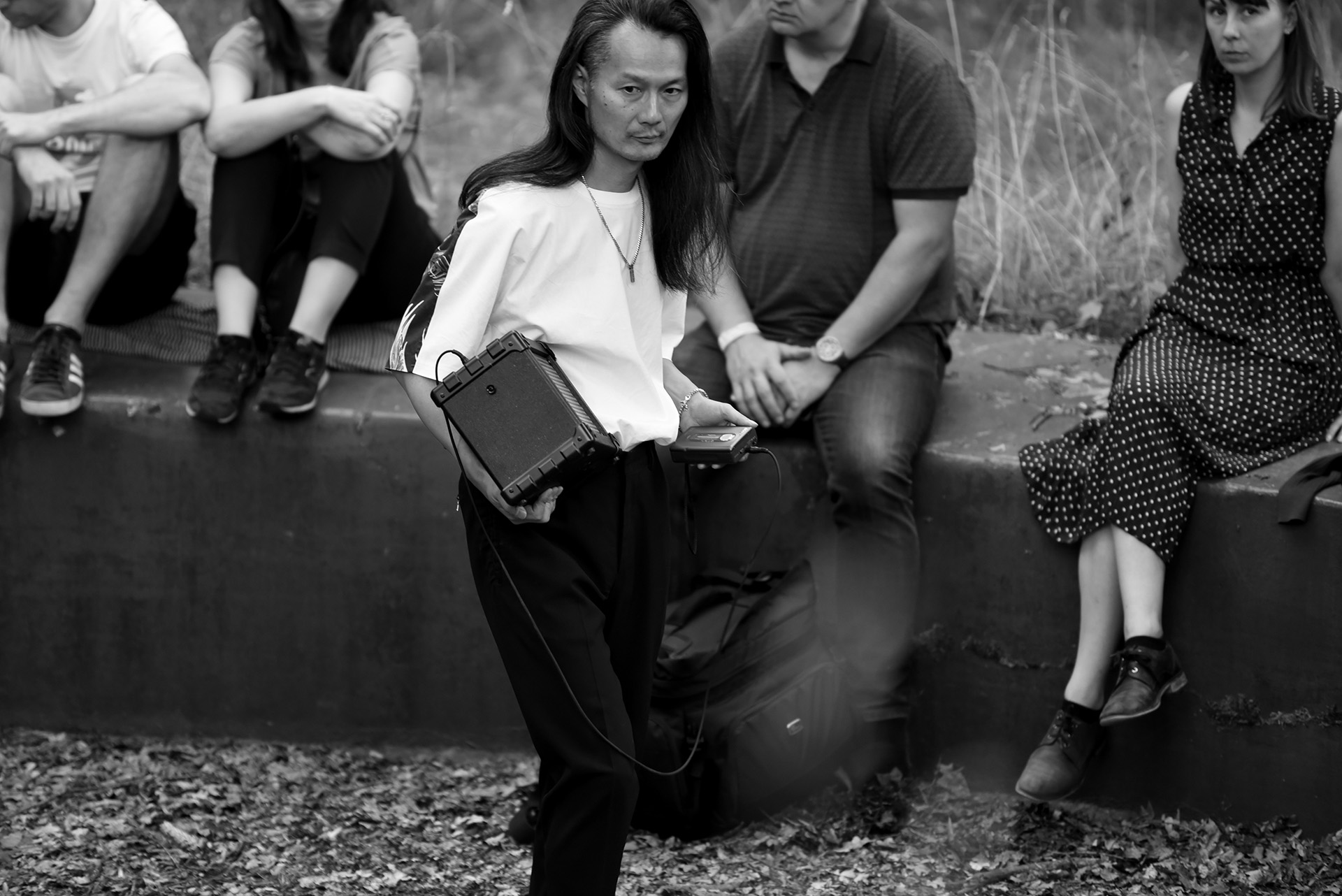
Aki Onda “Cassette Memories” performance, Sokolowsko, 2018.
Photo Kazimierz Ździebło.
Photo Kazimierz Ździebło.
Here again, Onda’s work is that of framing another artist. It was the final installment of ISSUE’s series, and it frames Onda’s own time in New York. The first concert he saw of Connors was his collaboration with the late poet Steve Dalachinsky at the Knitting Factory in the late 90s.
The move to Japan is temporary. Onda and his wife, the artist, and photographer Maki Kaoru, were preparing to move to Brussels when the pandemic struck. While he’s there, he’ll have an installation piece at Arts Maebashi in Maebashi City in an exhibition, Listening: Resonant Worlds, curated by the museum’s Director Fumihiko Sumitomo.
At least for a little while, it is something of a return home for the two (Kaoru is originally from Mito). But even the notion of ‘home’ isn’t simple for Onda. His paternal grandparents moved to Japan from the Southern part of Korea during World War II. As a young field hockey star, Onda’s father was able to gain Japanese citizenship so that he could play on the Japanese team in the 1964 Olympics in Tokyo, adopting his wife’s family name, Onda, to replace his Korean surname. A technicality prevented his father from participating, but he competed in the 1968 Olympics in Mexico City and then coached and managed the team. His mother was born in Japan, the niece of Kazuko Onda, a journalist, and early suffragist. “People thought she was too eccentric in the conservative Japanese society,” he wrote in another follow-up email shortly after arriving in Japan.
“She was a diva-type, and everybody had such a hard time with her. But she deeply loved me, and I only have fond memories of her. She and my father taught me that it’s okay to be my own self and ignore the social norms. My sexuality was ambiguous when I was a child. I wanted to be a girl (I changed my name to Aki, which is a female name in Japan), and I loved wearing girls’ clothes. People thought I was crazy, but I had the strength to fight against their projections. Eventually, I stopped going to school and skipped formal education.”
While he grew up in Japan, Onda doesn’t consider himself to be strictly Japanese.
“I was born in Japan and grew up there but have never identified myself as a Japanese nor Korean, though I’m proud to be Asian. Moreover, as my family extensively traveled around the world, it was easier and more convenient to consider ourselves as ‘nomads.’
The move to Japan is temporary. Onda and his wife, the artist, and photographer Maki Kaoru, were preparing to move to Brussels when the pandemic struck. While he’s there, he’ll have an installation piece at Arts Maebashi in Maebashi City in an exhibition, Listening: Resonant Worlds, curated by the museum’s Director Fumihiko Sumitomo.
At least for a little while, it is something of a return home for the two (Kaoru is originally from Mito). But even the notion of ‘home’ isn’t simple for Onda. His paternal grandparents moved to Japan from the Southern part of Korea during World War II. As a young field hockey star, Onda’s father was able to gain Japanese citizenship so that he could play on the Japanese team in the 1964 Olympics in Tokyo, adopting his wife’s family name, Onda, to replace his Korean surname. A technicality prevented his father from participating, but he competed in the 1968 Olympics in Mexico City and then coached and managed the team. His mother was born in Japan, the niece of Kazuko Onda, a journalist, and early suffragist. “People thought she was too eccentric in the conservative Japanese society,” he wrote in another follow-up email shortly after arriving in Japan.
“She was a diva-type, and everybody had such a hard time with her. But she deeply loved me, and I only have fond memories of her. She and my father taught me that it’s okay to be my own self and ignore the social norms. My sexuality was ambiguous when I was a child. I wanted to be a girl (I changed my name to Aki, which is a female name in Japan), and I loved wearing girls’ clothes. People thought I was crazy, but I had the strength to fight against their projections. Eventually, I stopped going to school and skipped formal education.”
While he grew up in Japan, Onda doesn’t consider himself to be strictly Japanese.
“I was born in Japan and grew up there but have never identified myself as a Japanese nor Korean, though I’m proud to be Asian. Moreover, as my family extensively traveled around the world, it was easier and more convenient to consider ourselves as ‘nomads.’
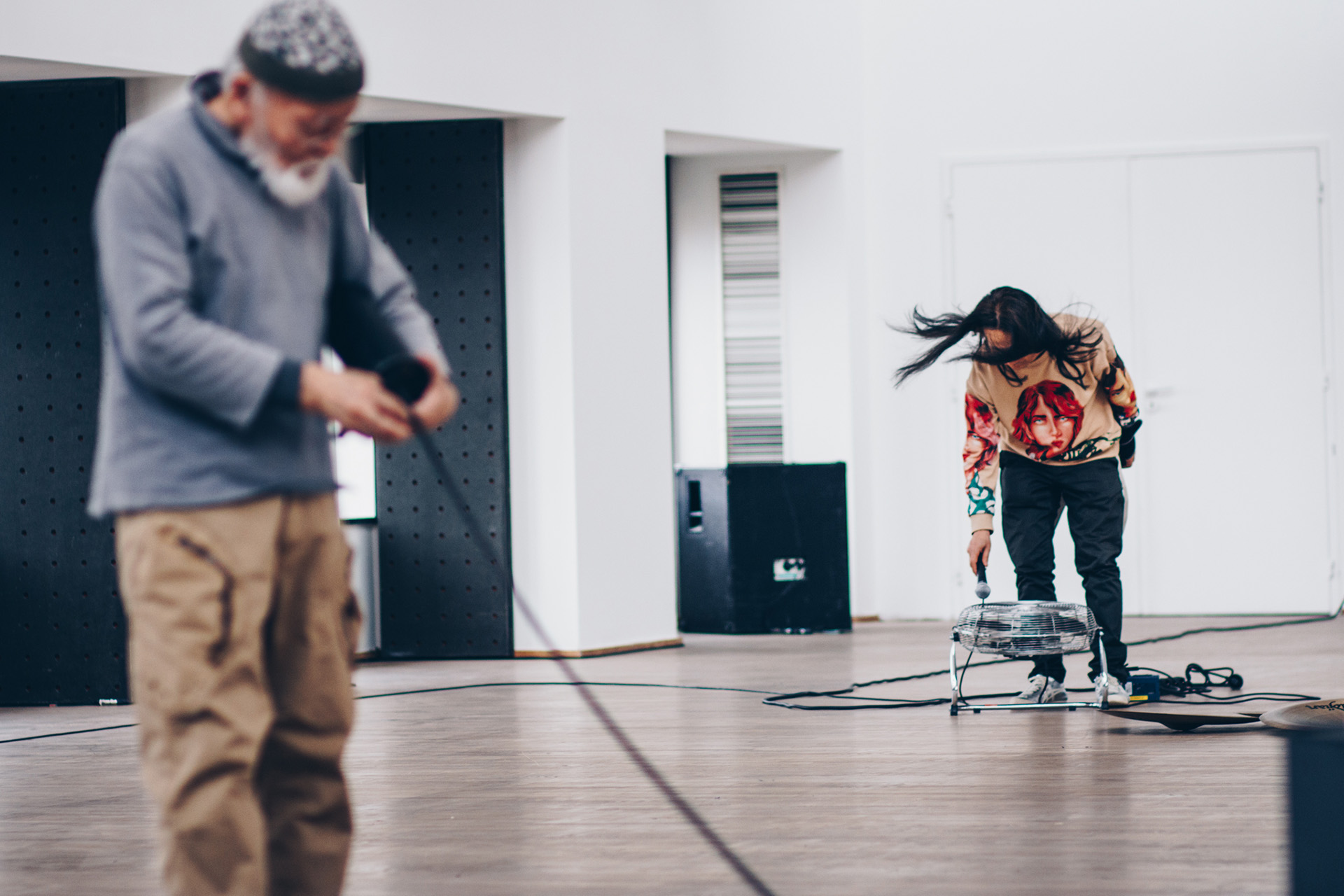
Aki Onda and Akio Suzuki at STUK, Leuven, Belgium, 2019.
Photo credit: Joeri Thiry.
Photo credit: Joeri Thiry.
“Maybe that echoes with Paik’s life. He was born in Korea, but his family had to flee from Seoul during the Korean War. (Korean people hated this, and for decades, Paik’s family had a negative reputation in his country.) Then he studied in Japan and Germany before he settled down in New York. As Yuji Agematsu, a New York-based visual artist testified in an interview. In some fundamental way, he was a nomad from continental Asia, and there was no need for him to stick to just one language (or country).
“This not-belonging-to-anywhere or nomadic nature reflects my art practice and Paik’s—different artistic forms are combined and collaged in a complex way, and something very unusual or hard-to-define reveals itself during the process. I think this album Nam June’s Spirit Was Speaking to Me explains this well.”
“This not-belonging-to-anywhere or nomadic nature reflects my art practice and Paik’s—different artistic forms are combined and collaged in a complex way, and something very unusual or hard-to-define reveals itself during the process. I think this album Nam June’s Spirit Was Speaking to Me explains this well.”
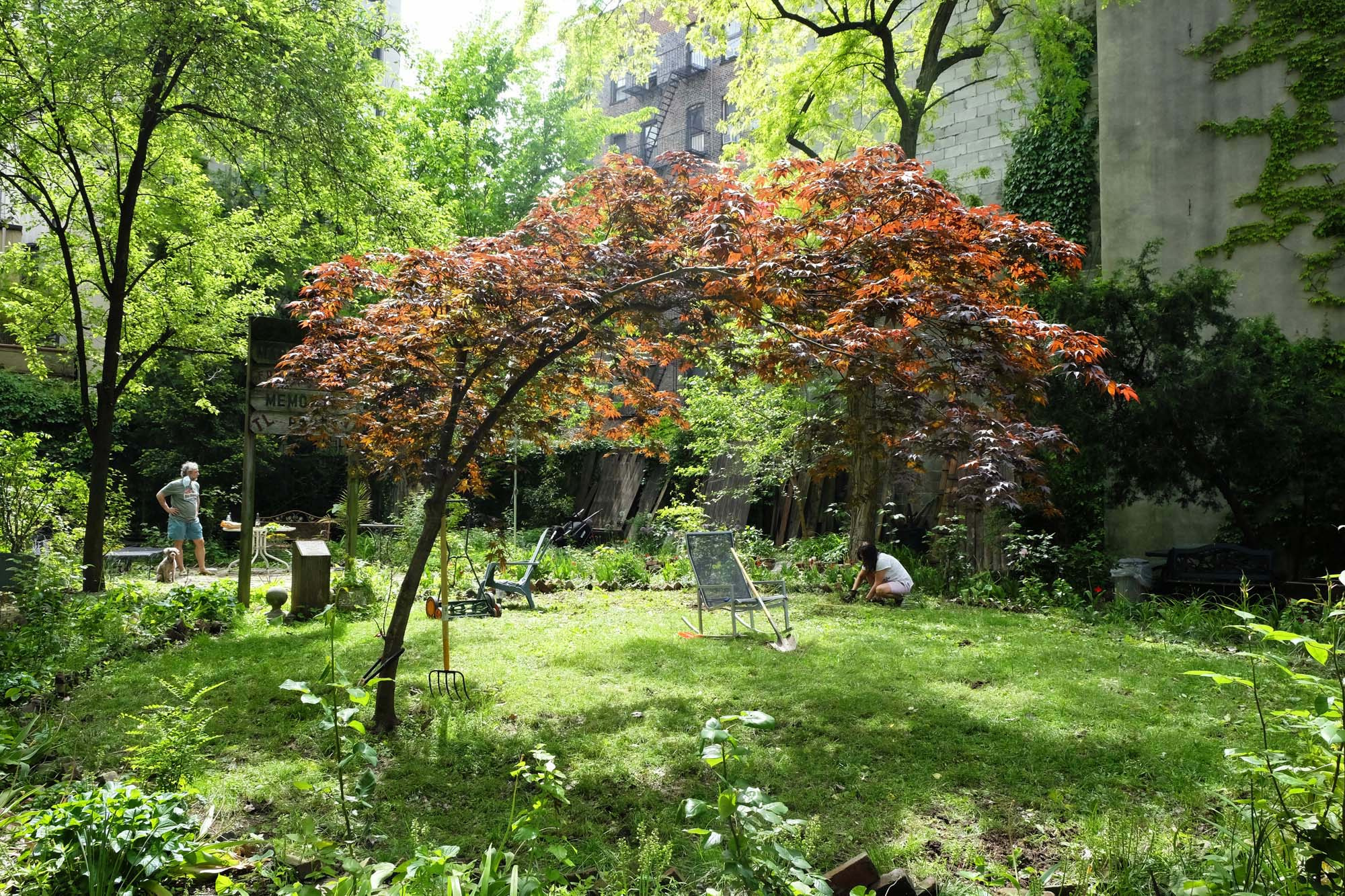
Silence Prevails: Lower East Side Community Gardens During the Pandemic (2020).
field recordings, videos, text, map, and historical photos and documents.
MoMA PS1.
June 2, 2022–January 16, 2023.
As a part of the exhibition Life Between Buildings, organized by Jody Graf.
field recordings, videos, text, map, and historical photos and documents.
MoMA PS1.
June 2, 2022–January 16, 2023.
As a part of the exhibition Life Between Buildings, organized by Jody Graf.
This, perhaps, is how to frame Onda’s art, or at least how he sees it: unidentifiable recordings of unknown origin attributed to another artist, one who died 15 years ago. Onda is serious about his work but remarkably humble. Compliments are met, again, with laughter. He has a particular way of owning his work without taking credit for it. It’s that thing that’s “hard to explain with language,” which “comes from somewhere else,” that’s “something spiritual,” which he doesn’t want to mystify, as mystical as it is. What makes the radio signals into messages from Paik is, perhaps, the belief that that’s what they are, the faith in something outside himself floating through the air.
“Spiritualism, what happens after you die—something remains,” he said during the call. “Some people believe that’s the pure end, but I believe something goes on.”
“Spiritualism, what happens after you die—something remains,” he said during the call. “Some people believe that’s the pure end, but I believe something goes on.”
M I X E D M E D I A
Institutional Negotiations
An Interview with Tercerunquinto
Written by Nicola Trezzi

Tercerunquinto, “Dismantling and Relocation of the National Emblem”, 2008.
Photo documentation of the action on the facade of the Ministry of Foreign Affairs’ former building, Mexico City.
Courtesy of the artists and Proyectos Monclova, Mexico City.
Simultaneously ephemeral and monumental, the work of Tercerunquinto intervenes in both public and private spaces, questioning the limits between the two spheres, and breaking down the components of these systems. Deeply rooted in the context of Mexico and yet inextricably connected to global instances, both in terms of language, issues and positions, the practice of Tercerunquinto could be seen as a perfect mix between a sociological research team, an architectural firm, and a collective of artists. In this interview with Nicola Trezzi, the members of Tercerunquinto openly share their position on how blending art and politics can actually generate a “space for negotiation” that, if it won’t change the world, will definitely change the mindset of those who inhabit it.
Nicola Trezzi: You are based in Mexico City but you originally established Tercerunquinto in Monterrey. Can you share the premises of your collaboration and, considering the urban focus of your work, how much the city of Monterrey influenced the early stage of your practice?
Tercerunquinto: We have always felt that being born and growing up in Monterrey has played a major part in shaping on our ideas about art. The influence of the city is clearly evident when you look at the materials we began to work with. Monterrey is a very important industrial city; cement, concrete and other materials related to construction have been the touchstones of progress and social development and are thus emblematic of Monterrey’s culture. On the other hand, the collective, which we formed when we were still art students, was for us a survival strategy in an environment which was very hostile towards the younger artistic community. Monterrey – its institutions and support system – was not particularly benevolent to artists, unless you were useful to their ideas; and as young people training to become artists we were much more limited in terms of access.
Tercerunquinto: We have always felt that being born and growing up in Monterrey has played a major part in shaping on our ideas about art. The influence of the city is clearly evident when you look at the materials we began to work with. Monterrey is a very important industrial city; cement, concrete and other materials related to construction have been the touchstones of progress and social development and are thus emblematic of Monterrey’s culture. On the other hand, the collective, which we formed when we were still art students, was for us a survival strategy in an environment which was very hostile towards the younger artistic community. Monterrey – its institutions and support system – was not particularly benevolent to artists, unless you were useful to their ideas; and as young people training to become artists we were much more limited in terms of access.

Installation view of the group exhibition "Normal Expectations: Contemporary Art in Mexico", Museo Jumex, Mexico City, Mexico, 2018.
Photo credit: Ramiro Chaves.
Photo credit: Ramiro Chaves.
NT: Tell us about your name, what are the literal and conceptual meanings of the Spanish word Tercerunquinto and how did you come upon such a name? Did the name influence your practice or vice versa? Did your ideas create the name or was it working together in a specific way that brought you to use this word as a signature?
Tercerunquinto: Basically, the name directs one to think of an integer or a whole divided into several parts, although only one of them is named: the 3rd out of 5. For us, the name was a way to recognize ourselves as a collective, as part of a dynamic entity that was never totally complete and in which the involvement of each of its members changed with each work. Even later, when the contributions of other agents outside Tercerunquinto were integrated, we realized that the name had further connotations, since the work was extended and completed with the intervention of other people who are not artists. The name can be seen as a way to define collectivity.
![]()
Installation view of “Staircase”, 2002. From the series Dwelling Houses.
Reinstalled for "Tercerunquinto: Obra Inconclusa", Museo / Fundación Amparo, Puebla, Mexico, 2018.
cur. Cuauhtémoc Medina and Taiyana Pimentel.
Courtesy of the artists and Proyectos Monclova, Mexico City.
Tercerunquinto: Basically, the name directs one to think of an integer or a whole divided into several parts, although only one of them is named: the 3rd out of 5. For us, the name was a way to recognize ourselves as a collective, as part of a dynamic entity that was never totally complete and in which the involvement of each of its members changed with each work. Even later, when the contributions of other agents outside Tercerunquinto were integrated, we realized that the name had further connotations, since the work was extended and completed with the intervention of other people who are not artists. The name can be seen as a way to define collectivity.

Installation view of “Staircase”, 2002. From the series Dwelling Houses.
Reinstalled for "Tercerunquinto: Obra Inconclusa", Museo / Fundación Amparo, Puebla, Mexico, 2018.
cur. Cuauhtémoc Medina and Taiyana Pimentel.
Courtesy of the artists and Proyectos Monclova, Mexico City.
NT: What was your most radical project to date, in terms of scale, ambition, complexity and realization? If you could do it again, what would you change?
Tercerunquinto: It is difficult to answer this question because, although it is true that we have made ambitious and complex works, some of them quite large, none of them has had giant proportions. Another approach is to define the magnitude of these works not necessarily in terms of their physical aspects, but rather through their conceptual scope. The first three works that we produced consisted of a series of modest walls of regular size, arranged in different situations according to the inner space in which they were presented. We later became aware of the fact that these walls projected a direction outwards, towards the public space. Such a realization generated new experiences and ideas in relation to our task as artists. We thought that the expressive capacities of the construction materials (mortar and concrete blocks) always had to be employed through interventions that were trespassing the logical and functional arrangements of various spaces. This was at the beginning, when we wanted to address our context or even try to define it and, to answer your question, at the time those were very ambitious concerns and interests, at least for us.
Public sculpture in the urban periphery of Monterrey (2003-2006) was probably the first work that put us, since we first had the idea, in a very different and much more complex horizon from that of the previous works. This work forced us to review and discuss historical concepts related to art; to produce new work dynamics, such as exploring geographical areas of the city in order to have a map of the type of contexts we were interested in, and to collaborate with powerful agents to obtain the economic resources needed to produce the piece. Subsequently, when our work gain institutional acceptance, the concept of negotiation not only became pivotal, it also moved to a higher level, so to speak, since it often involved authorities and power structures outside the field of art; for instance our contribution to group exhibition Mexico: Sensitive Negotiations curated by Taiyana Pimentel in 2002 required negotiating permission to tear down the walls of an office of the Consulate General of Mexico in Miami – where the exhibition took place – with the Mexican Minister of Foreign Affairs. As to what we would change, it is very difficult to answer to that; perhaps we probably have a fairly healthy relationship with our past, we try not to punish ourselves for our mistakes or whatever we could have done differently.
Tercerunquinto: It is difficult to answer this question because, although it is true that we have made ambitious and complex works, some of them quite large, none of them has had giant proportions. Another approach is to define the magnitude of these works not necessarily in terms of their physical aspects, but rather through their conceptual scope. The first three works that we produced consisted of a series of modest walls of regular size, arranged in different situations according to the inner space in which they were presented. We later became aware of the fact that these walls projected a direction outwards, towards the public space. Such a realization generated new experiences and ideas in relation to our task as artists. We thought that the expressive capacities of the construction materials (mortar and concrete blocks) always had to be employed through interventions that were trespassing the logical and functional arrangements of various spaces. This was at the beginning, when we wanted to address our context or even try to define it and, to answer your question, at the time those were very ambitious concerns and interests, at least for us.
Public sculpture in the urban periphery of Monterrey (2003-2006) was probably the first work that put us, since we first had the idea, in a very different and much more complex horizon from that of the previous works. This work forced us to review and discuss historical concepts related to art; to produce new work dynamics, such as exploring geographical areas of the city in order to have a map of the type of contexts we were interested in, and to collaborate with powerful agents to obtain the economic resources needed to produce the piece. Subsequently, when our work gain institutional acceptance, the concept of negotiation not only became pivotal, it also moved to a higher level, so to speak, since it often involved authorities and power structures outside the field of art; for instance our contribution to group exhibition Mexico: Sensitive Negotiations curated by Taiyana Pimentel in 2002 required negotiating permission to tear down the walls of an office of the Consulate General of Mexico in Miami – where the exhibition took place – with the Mexican Minister of Foreign Affairs. As to what we would change, it is very difficult to answer to that; perhaps we probably have a fairly healthy relationship with our past, we try not to punish ourselves for our mistakes or whatever we could have done differently.
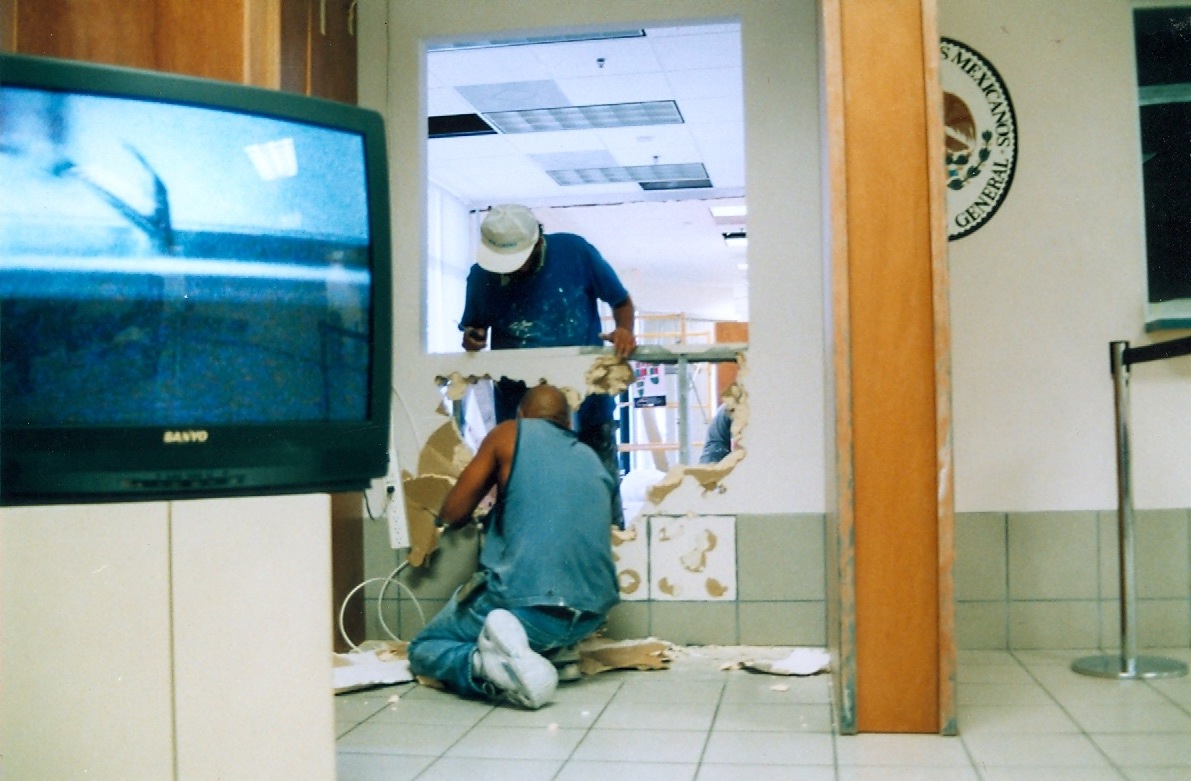
Tercerunquinto, “Integration of the Consulate General of Mexico in Miami to the Exhibition”
MEXICO: SENSITIVE NEGOTIATIONS, 2002.
Photo documentation of the action at the Consulate General of Mexico, Miami.
Courtesy of the artists and Proyectos Monclova, Mexico City.
NT: The physical dimensions of your works can drastically shift, from small gestures to monumental interventions; yet, the metaphysical dimension of your work seems to align, would you agree? Could you talk about two projects diametrically different in terms of physical dimensions but similar in terms of their metaphysical dimension?
Tercerunquinto: Dismantling and Relocation of the National Emblem (2008) possesses a very complex monumentality since, beside its size, this emblem – together with the Mexican national anthem and flag – is jealously guarded by the army. As you can imagine, the negotiations we had to go through to complete this work were huge. However, the fact that we were dealing with the Tlatelolco University Cultural Center – whose building is the former headquarters of the Ministry of Foreign Affairs but now part of UNAM – facilitated our work and made it achievable. Still, to avoid controversies, the official justification for the removal of the six marble slabs that make the emblem was the need for restoration, rather than to create a work of art. We accepted such a compromise in order to succeed in our desire to challenge such a loaded site, one that has strong connection to the massacre of students in 1968.
Tercerunquinto: Dismantling and Relocation of the National Emblem (2008) possesses a very complex monumentality since, beside its size, this emblem – together with the Mexican national anthem and flag – is jealously guarded by the army. As you can imagine, the negotiations we had to go through to complete this work were huge. However, the fact that we were dealing with the Tlatelolco University Cultural Center – whose building is the former headquarters of the Ministry of Foreign Affairs but now part of UNAM – facilitated our work and made it achievable. Still, to avoid controversies, the official justification for the removal of the six marble slabs that make the emblem was the need for restoration, rather than to create a work of art. We accepted such a compromise in order to succeed in our desire to challenge such a loaded site, one that has strong connection to the massacre of students in 1968.
Tercerunquinto, “Dismantling and Relocation of the National Emblem”, 2008.
Photo documentation of the action on the façade of the Ministry of Foreign Affairs’ former building, Mexico City
Courtesy of the artists and Proyectos Monclova, Mexico City.
.
On the other hand, the production of Manual Transcription of the Federal District’s Penal Code of 1967 (2011) required an intimate relationship with a prisoner who, produced a single edition handmade book, which we then decided to donate to the General Archive of the Nation, which is actually located on the site of the former prison of Lecumberri, a place where he had spent the first years of his sentence. In our view, both these projects broach tremendous failings of the Mexican State.
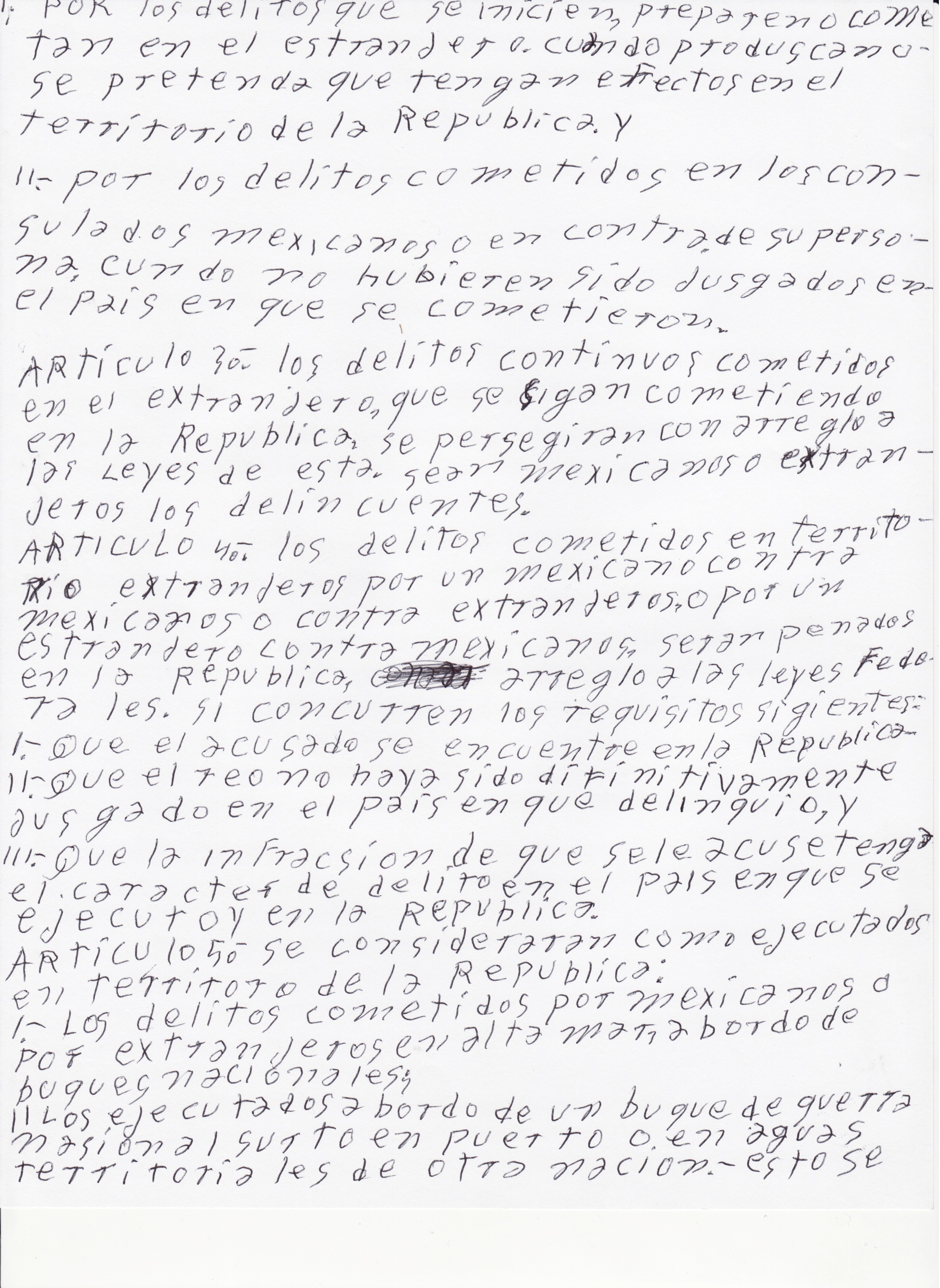
Tercerunquinto, “Manual Transcription of the Federal District’s Penal Code of 1967”, 2011.
Manual transcription made by an inmate in the Santa Martha Acatitla prison, variable dimensions (depends of the space to install every single sheet).
Courtesy of the artists and Proyectos Monclova, Mexico City.

NT: Murals are often associated with Mexican art and its visual culture; your works often employ walls, either as conceptual installations or surfaces for murals, cutouts, etc. Can you elaborate on this connection?
Tercerunquinto: This connection was not there in 2000 when we first discussed the idea of producing Restoration of a Mural Painting (2009-16). At that time, we had not integrated the condition that this work should be done by professional restorers and conservators dealing with artistic heritage; they were a series of street pictorial gestures: we would repaint some political campaign paintings – ‘consigned’ to the public space – which we found on our road trips or in the city itself. At that time there was political and social upheaval, to the extent that we began to seriously think of the likelihood of a change of regime, after having been governed by the same party for seventy years.
The connection you mention took place ten years later. By that time we had already decided that the restoration work should be carried out by a professional restoration team. We had already come up with the idea of confronting the great Mexican artistic legacy of Muralism with the ideas of this project. In addition, when we were asked to produce the project and exhibit it in the old house of David Alfaro Siqueiros, converted at the time into the Sala de Arte Público Siqueiros, we saw very fortunate and pertinent circumstances allowing us to discuss two different conceptions of Muralism. We do not rule out the fact that this was a provocation. All this said, we are interested in walls probably because they are used to insert many desires and failed projects in the public space: those that come from commercial and political advertising as well as the artistic legacy of Muralism. They are documents and themselves constitute an interesting kind of national archive.
Tercerunquinto: This connection was not there in 2000 when we first discussed the idea of producing Restoration of a Mural Painting (2009-16). At that time, we had not integrated the condition that this work should be done by professional restorers and conservators dealing with artistic heritage; they were a series of street pictorial gestures: we would repaint some political campaign paintings – ‘consigned’ to the public space – which we found on our road trips or in the city itself. At that time there was political and social upheaval, to the extent that we began to seriously think of the likelihood of a change of regime, after having been governed by the same party for seventy years.
The connection you mention took place ten years later. By that time we had already decided that the restoration work should be carried out by a professional restoration team. We had already come up with the idea of confronting the great Mexican artistic legacy of Muralism with the ideas of this project. In addition, when we were asked to produce the project and exhibit it in the old house of David Alfaro Siqueiros, converted at the time into the Sala de Arte Público Siqueiros, we saw very fortunate and pertinent circumstances allowing us to discuss two different conceptions of Muralism. We do not rule out the fact that this was a provocation. All this said, we are interested in walls probably because they are used to insert many desires and failed projects in the public space: those that come from commercial and political advertising as well as the artistic legacy of Muralism. They are documents and themselves constitute an interesting kind of national archive.
Tercerunquinto, “Restoration of a Mural Painting”, 2009-2016.
Photo documentation of the action at San Andres Cacaloapan, Puebla (Mexico).
Courtesy of the artists and Proyectos Monclova, Mexico City.
NT: Some of your works, like Public Sculpture in the Urban Periphery of Monterrey, appropriate the language of Land Art, especially how photography has been used to document works, for example with European artists such as Richard Long or Hamish Fulton. Would you agree? Was such a contradiction of terms – Land Art being related to nature, to the outside – a purposeful decision?
Tercerunquinto: It is interesting how from the beginning there were various readings of this work in the light of ideas that came from Minimal and Land Art, or those of Relational Aesthetics. Honestly, although we had always been interested in minimalist sculptural practices, they did not determine our process of work. It was something simpler: taking as a point of departure the basic idea in the “figure-background” drawing, we wanted to move it to the more complex level of “sculpture-context.” Thereby we introduced a fundamental element as a sign of urbanism (and probably of urbanity) such as concrete, in a context that lacked the basic public services such as paved roads, lighting, etc. There, where nobody is concerned about art (why should they be?) we decided to develop our ideas on art, specifically on public sculpture.
Tercerunquinto: It is interesting how from the beginning there were various readings of this work in the light of ideas that came from Minimal and Land Art, or those of Relational Aesthetics. Honestly, although we had always been interested in minimalist sculptural practices, they did not determine our process of work. It was something simpler: taking as a point of departure the basic idea in the “figure-background” drawing, we wanted to move it to the more complex level of “sculpture-context.” Thereby we introduced a fundamental element as a sign of urbanism (and probably of urbanity) such as concrete, in a context that lacked the basic public services such as paved roads, lighting, etc. There, where nobody is concerned about art (why should they be?) we decided to develop our ideas on art, specifically on public sculpture.
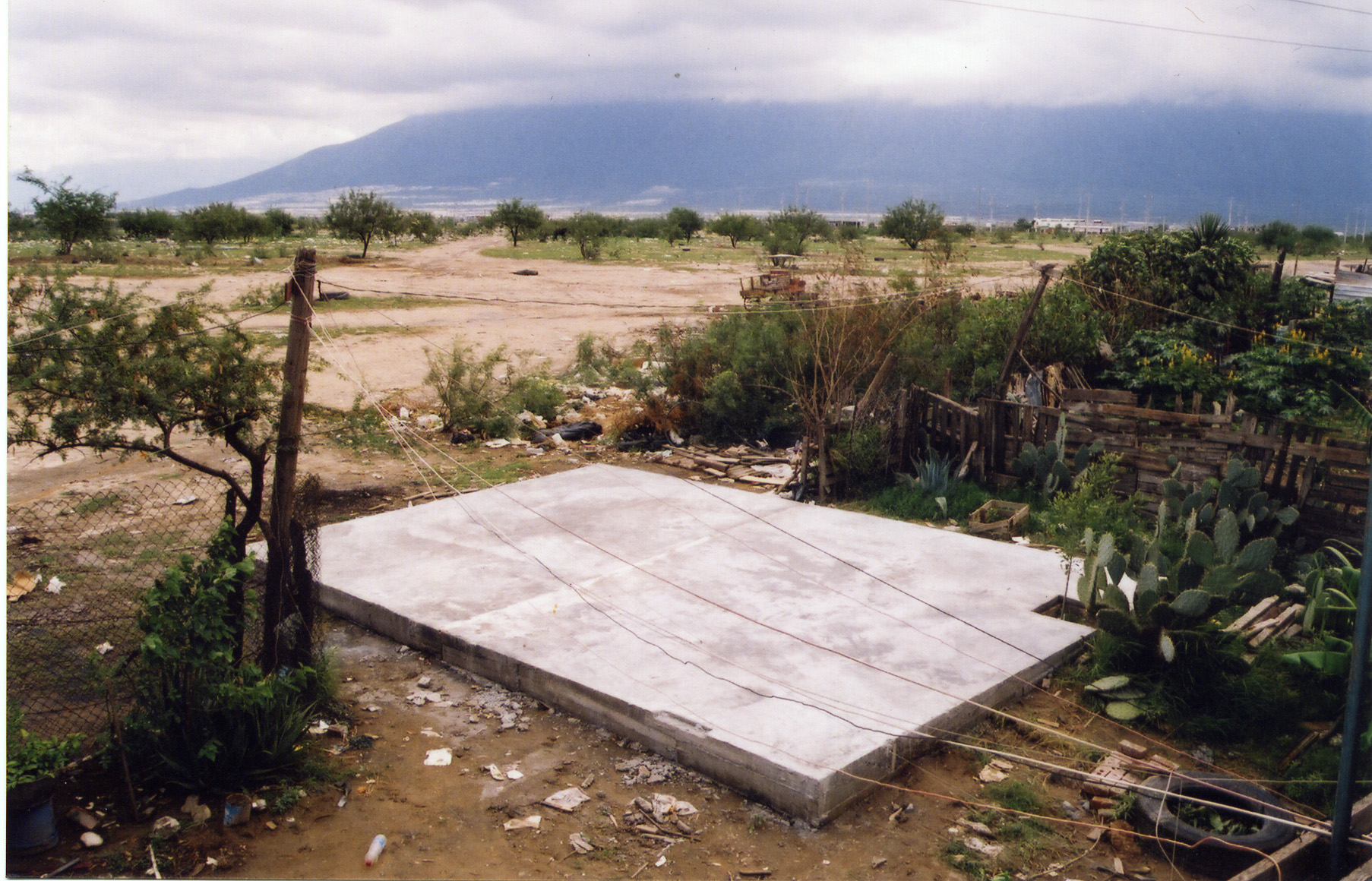
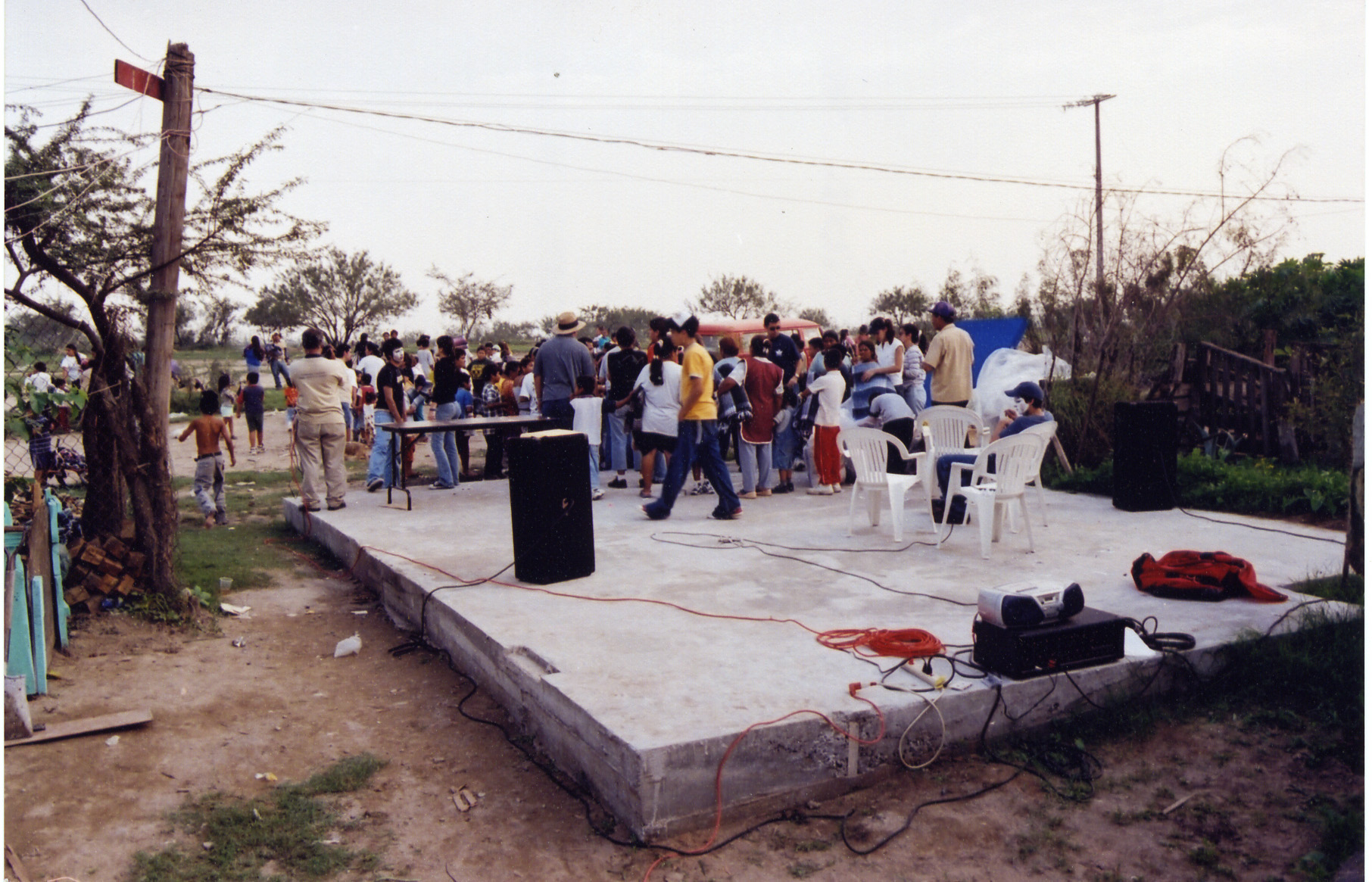

Tercerunquinto, “Public sculpture on the urban periphery of Monterrey”, 2003-2006.
Photo documentation of an intervention in a peripheral neighborhood of Monterrey (Mexico).
Courtesy of the artists and Proyectos Monclova, Mexico City.
NT: Can you speak of your work Vendedor de flores (2014)? Is it connected to the work of Mexican artist and muralist Diego Rivera, who made a painting of a female flower vendor [Vendedora de flores, 1949]?
Tercerunquinto: This is a strange coincidence. We never had Diego Rivera in mind when we were discussing the ideas; in fact we kind of laughed when we became aware of the coincidence! Moreover, and far from wanting to create controversy, we must clarify that the folkloric character in Rivera’s painting could not be further away from the ideas we were working on in our project. Our aim is to illustrate the possible distances that exist between a cultural institution – a museum, a gallery, an art center – the cultural, political and economic power they retain and their respective audience. The activation of these agents (a museum, a collection, and a street flower vendor) in Bochum was meant to generate discussions about how distances can vary depending on the audience. This is what is traditionally referred to as institutional critique, which we adopted and twisted into “institutional negotiation.”
Tercerunquinto: This is a strange coincidence. We never had Diego Rivera in mind when we were discussing the ideas; in fact we kind of laughed when we became aware of the coincidence! Moreover, and far from wanting to create controversy, we must clarify that the folkloric character in Rivera’s painting could not be further away from the ideas we were working on in our project. Our aim is to illustrate the possible distances that exist between a cultural institution – a museum, a gallery, an art center – the cultural, political and economic power they retain and their respective audience. The activation of these agents (a museum, a collection, and a street flower vendor) in Bochum was meant to generate discussions about how distances can vary depending on the audience. This is what is traditionally referred to as institutional critique, which we adopted and twisted into “institutional negotiation.”
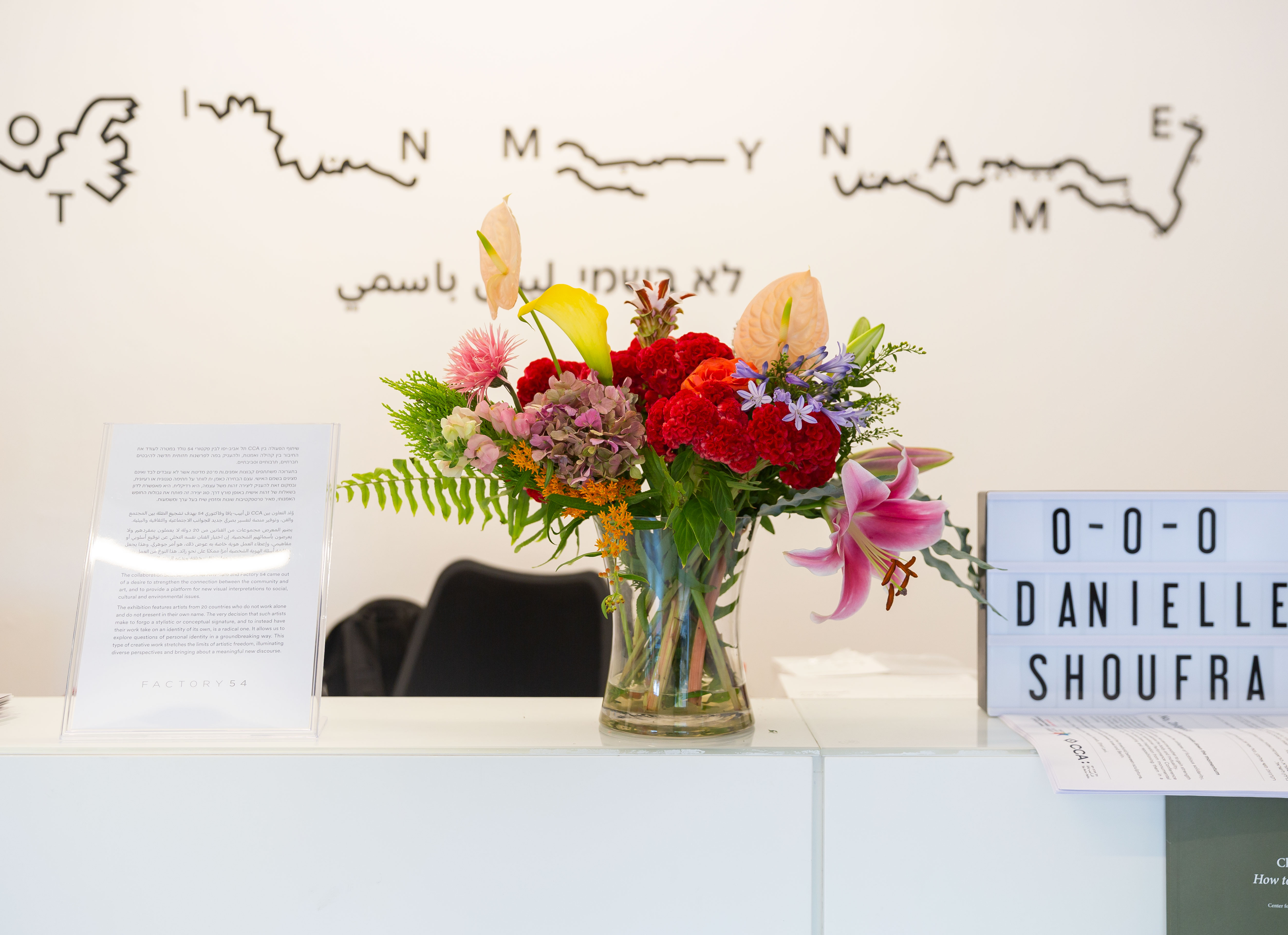
Tercerunquinto, “Vendedor de flores”, 2014.
Photo documentation of the action at Kunstmuseum Bochum (Germany), Museo Amparo, Puebla (Mexico) and CCA Tel Aviv-Yafo.
Courtesy of the artists and Proyectos Monclova, Mexico City.
NT: You are represented by two galleries, one in Mexico City, Proyectos Monclova, and one in Zurich, Galerie Peter Kilchmann. Although Kilchmann is truly connected to Latin America and specifically Mexico, one cannot think of two more different places than Mexico and Switzerland. Have you ever presented the same work in both galleries? What were the respective reactions? More generally speaking, how do you see your work being translated (or misunderstood) according to the culture and language of the place in which it is displayed?
Tercerunquinto: A very interesting and punctual question. It has happened that the same work has been exhibited in both galleries. We have noticed the difference in perspectives especially when we exhibit a work produced in Mexico that contains ideas and reflections from a Mexican context. It is interesting how, after about forty years of globalization, during which art has served as a cutting-edge mechanism to bridge boundaries, one still perceives such different reactions from showing the same work in two contexts as different as you mention. It seems that in reality some of us have globalized more than others! That’s why, considering the fact that globalization has been a profitable project for some, and a devastating one for others, people are already talking about a post-globalization era.
Tercerunquinto: A very interesting and punctual question. It has happened that the same work has been exhibited in both galleries. We have noticed the difference in perspectives especially when we exhibit a work produced in Mexico that contains ideas and reflections from a Mexican context. It is interesting how, after about forty years of globalization, during which art has served as a cutting-edge mechanism to bridge boundaries, one still perceives such different reactions from showing the same work in two contexts as different as you mention. It seems that in reality some of us have globalized more than others! That’s why, considering the fact that globalization has been a profitable project for some, and a devastating one for others, people are already talking about a post-globalization era.

Courtesy of the artists and Proyectos Monclova.
Photo credit: DOS estudio (Rodrigo Viñas / Patrick López Jaimes).

Tercerunquinto, “Historia Breve de la Construcción”, 2022.
Cinder blocks, bricks and clay blocks, installation view at Centro Cultural Juan Beckmann Gallardo, Santiago de Tequila (Mexico).
Courtesy of the artists and Proyectos Monclova, Mexico City.
NT: Can you talk about the role documents play in your practice?
Tercerunquinto: The way we document our work has had several phases. Originally, during our first four or five years, we were basically interested in doing sculptural-architectural interventions on site, in which we actively participated. We would take some photographs, some videos and then this material would go to some boxes of files; sometimes we would print some photos, although without any clear vision. Then, when we started to be invited to exhibit documentation of these early works, this topic became a matter of discussion. The first few times we did it very literally, showing a series of images that seemed more like pieces of evidence, with the aim to register something we had done. Then we realized that this method was leaving out the much richer and more abstract ideas of our work. We therefore moved to a new phase of documentation where it no longer had anything to do with the original site where the work had happened. It had other potentialities and most importantly, it made us realize the difference between “people” and “audience.” When we work on site, outside of the institution, we don’t think about audiences, but about people; an important epistemic difference.
NT: Do you consider exhibition making, as a form and format, an essential aspect of the way you work, beyond sculpture, beyond installation, beyond site-specific intervention? Taking from that, what is the most appropriate site for your practice to materialize?
Tercerunquinto: We love all the complexity that can be built between these concepts that you mention. With the passing of time we have realized that all the tensions with historical concepts of art, conceptual, institutional, contemporary, intellectual, commercial and so on, have helped us to reach clarity, realizing that our work has been precisely to think, exist and survive in the midst of these tensions.
Tercerunquinto: The way we document our work has had several phases. Originally, during our first four or five years, we were basically interested in doing sculptural-architectural interventions on site, in which we actively participated. We would take some photographs, some videos and then this material would go to some boxes of files; sometimes we would print some photos, although without any clear vision. Then, when we started to be invited to exhibit documentation of these early works, this topic became a matter of discussion. The first few times we did it very literally, showing a series of images that seemed more like pieces of evidence, with the aim to register something we had done. Then we realized that this method was leaving out the much richer and more abstract ideas of our work. We therefore moved to a new phase of documentation where it no longer had anything to do with the original site where the work had happened. It had other potentialities and most importantly, it made us realize the difference between “people” and “audience.” When we work on site, outside of the institution, we don’t think about audiences, but about people; an important epistemic difference.
NT: Do you consider exhibition making, as a form and format, an essential aspect of the way you work, beyond sculpture, beyond installation, beyond site-specific intervention? Taking from that, what is the most appropriate site for your practice to materialize?
Tercerunquinto: We love all the complexity that can be built between these concepts that you mention. With the passing of time we have realized that all the tensions with historical concepts of art, conceptual, institutional, contemporary, intellectual, commercial and so on, have helped us to reach clarity, realizing that our work has been precisely to think, exist and survive in the midst of these tensions.
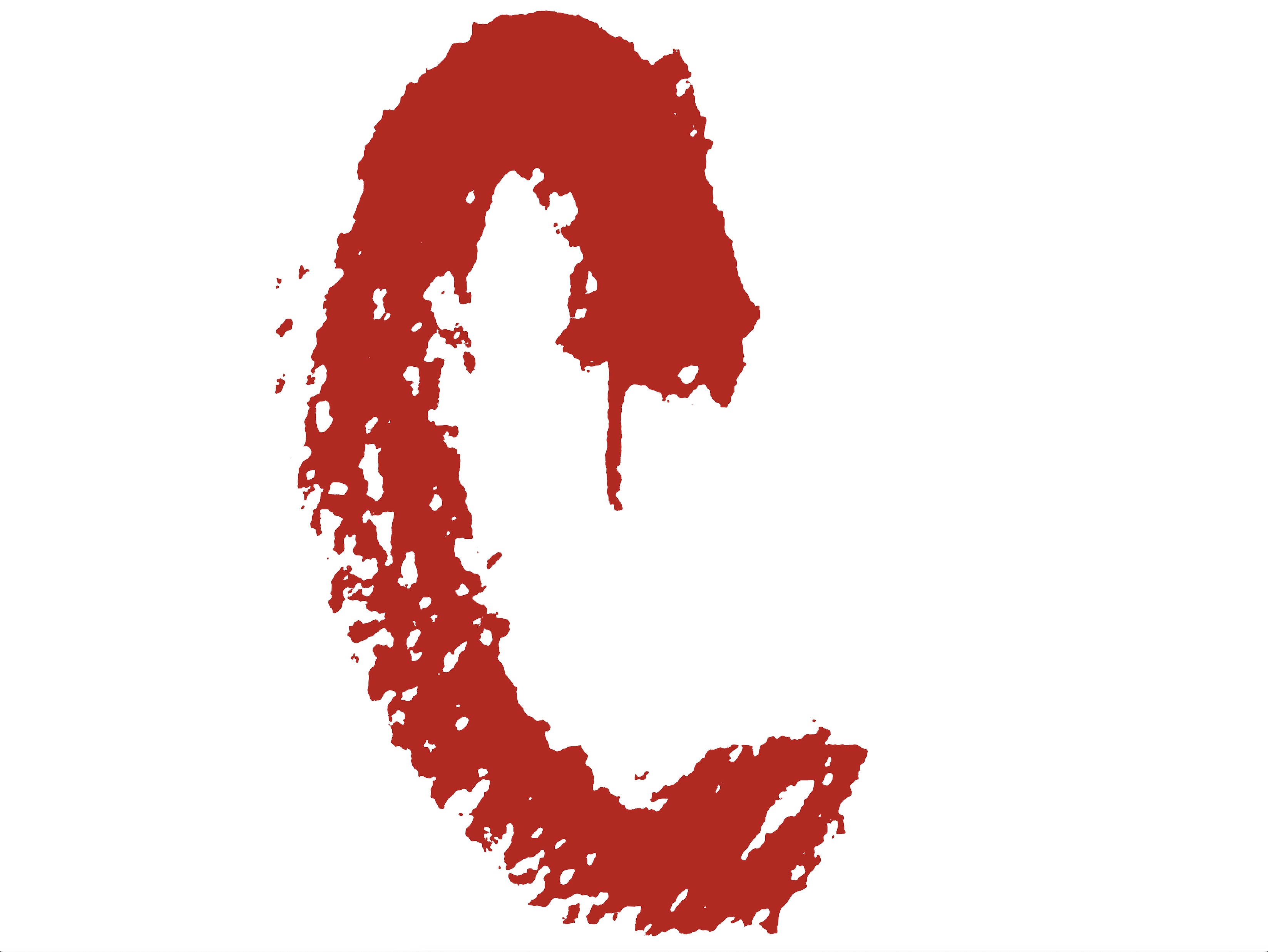
Tercerunquinto, “Alphabet”, 2023.
Digital images, variable dimensions.
Courtesy of the artists and Proyectos Monclova, Mexico City.
NT: Can you share what you have been working on recently, and any future projects?
Tercerunquinto: We are currently working on a series of artworks for an exhibition in Tequila, Jalisco, where we will also present a box design for the Reserva de la Familia 2023 edition of the company José Cuervo. The exhibition, entitled “Landscape: Figure and Abstraction,” has to do with the notion of landscape. While avoiding a romanticized view of Tequila, we are focused on how technological modernity has caused changes in the landscape, and are continuing to use our “materials”: concrete, mortar and other types of building materials.
In addition, we are working on two new series related to the dynamics of public spaces that were lost during the pandemic. We are surveying, through photography, the kind of monuments that have been subjected to political scrutiny in the last few years. This work does not have a title yet. Furthermore, echoing our work Gramática de la tristeza (2017), we are going back to appropriation of graffiti with the idea of creating a new work called Alphabet, a new typeface featuring a collection of letters from text anonymously written on walls. A prototype design is ready, although we are sure that this is not the end, considering the huge amount of material we have.
Tercerunquinto: We are currently working on a series of artworks for an exhibition in Tequila, Jalisco, where we will also present a box design for the Reserva de la Familia 2023 edition of the company José Cuervo. The exhibition, entitled “Landscape: Figure and Abstraction,” has to do with the notion of landscape. While avoiding a romanticized view of Tequila, we are focused on how technological modernity has caused changes in the landscape, and are continuing to use our “materials”: concrete, mortar and other types of building materials.
In addition, we are working on two new series related to the dynamics of public spaces that were lost during the pandemic. We are surveying, through photography, the kind of monuments that have been subjected to political scrutiny in the last few years. This work does not have a title yet. Furthermore, echoing our work Gramática de la tristeza (2017), we are going back to appropriation of graffiti with the idea of creating a new work called Alphabet, a new typeface featuring a collection of letters from text anonymously written on walls. A prototype design is ready, although we are sure that this is not the end, considering the huge amount of material we have.
N E W M E D I A
The Future
and their Future
An Interview with Raqs Media Collective
Written by Nicola Trezzi

Raqs Media Collective, “A Day in the Life of Kiribati”, 2014
Asamayavali/Untimely Calendar, National Gallery of Modern Art (NGMA), New Delhi (2014)
Asamayavali/Untimely Calendar, National Gallery of Modern Art (NGMA), New Delhi (2014)
Multidisciplinary, intellectual, open and yet deeply rooted in complex ways of thinking, acting and responding to the fabric of reality, the practice of Raqs Media Collective represents a unique phenomenon in the field of contemporary visual art, one in which “the visual” becomes an expanded field, encompassing cinema, philosophy and science. Nicola Trezzi interviewed the Collective about their practice, how they categorize it, their connection to India – their place of origin and continued base of operation – and about the future and their future.
Nicola Trezzi: The word “Raqs” defines the state of ecstasy attained by whirling dervishes. It is the same word in Persian, Arabic and Urdu, a fact that generates a lot of intercultural reflections. On the other hand RAQs could also stand for the abbreviation of Rarely Asked Questions, which echoes the Internet and its functional jargon. How did you come up with this name? Which one of these two completely different associations came first?
Raqs Media Collective: The name came to us during a conversation over noodle soup in front of a Chinese food truck next to a petrol pump near the Sufi shrine of Hazrat Nizamuddin in Central Delhi, in the fall of the year 1992. We had just been to the shrine, and watched an old man, whirl, like a dervish, in its courtyard. His kinetic intensity, and energy, was riveting, as was the tranquility of his countenance. That state of kinetic fullness experienced in the entirety of the turning body is called raqs in Arabic. Even the earth performs its ‘raqs’ on its axis. We spent some time talking to each other about the relationship between restlessness and contemplation, and it seemed to resonate with the state of mind we found ourselves in while we stayed in and out of conversation with each other, and with the world. That state of restlessness, its energy, and the contemplative ecstasy it can bring to mind hasn’t left us. The name came distilled with many associations: a comfort with restlessness, a curiosity to see what happens when that restlessness takes on a collective dimension, when you have three body-minds spinning, colliding, drifting, and then being wound up again. A name is also needed when you make a collective bank account! Some years later, when we were beginning to get interested in the argot of computer speak, a friend told us how RAQS (rarely asked questions), the opposite of FAQS (frequently asked questions), were sometimes tagged on to software usage manuals. The idea of being a “RAQS depository” was appealing. We have an instruction-based performance work titled The Bureau of Raqs & Faqs in which the Bureau of Faqs is always ‘out to lunch’ while at the Bureau of Raqs you get to invent questions for already given answers.
Raqs Media Collective: The name came to us during a conversation over noodle soup in front of a Chinese food truck next to a petrol pump near the Sufi shrine of Hazrat Nizamuddin in Central Delhi, in the fall of the year 1992. We had just been to the shrine, and watched an old man, whirl, like a dervish, in its courtyard. His kinetic intensity, and energy, was riveting, as was the tranquility of his countenance. That state of kinetic fullness experienced in the entirety of the turning body is called raqs in Arabic. Even the earth performs its ‘raqs’ on its axis. We spent some time talking to each other about the relationship between restlessness and contemplation, and it seemed to resonate with the state of mind we found ourselves in while we stayed in and out of conversation with each other, and with the world. That state of restlessness, its energy, and the contemplative ecstasy it can bring to mind hasn’t left us. The name came distilled with many associations: a comfort with restlessness, a curiosity to see what happens when that restlessness takes on a collective dimension, when you have three body-minds spinning, colliding, drifting, and then being wound up again. A name is also needed when you make a collective bank account! Some years later, when we were beginning to get interested in the argot of computer speak, a friend told us how RAQS (rarely asked questions), the opposite of FAQS (frequently asked questions), were sometimes tagged on to software usage manuals. The idea of being a “RAQS depository” was appealing. We have an instruction-based performance work titled The Bureau of Raqs & Faqs in which the Bureau of Faqs is always ‘out to lunch’ while at the Bureau of Raqs you get to invent questions for already given answers.
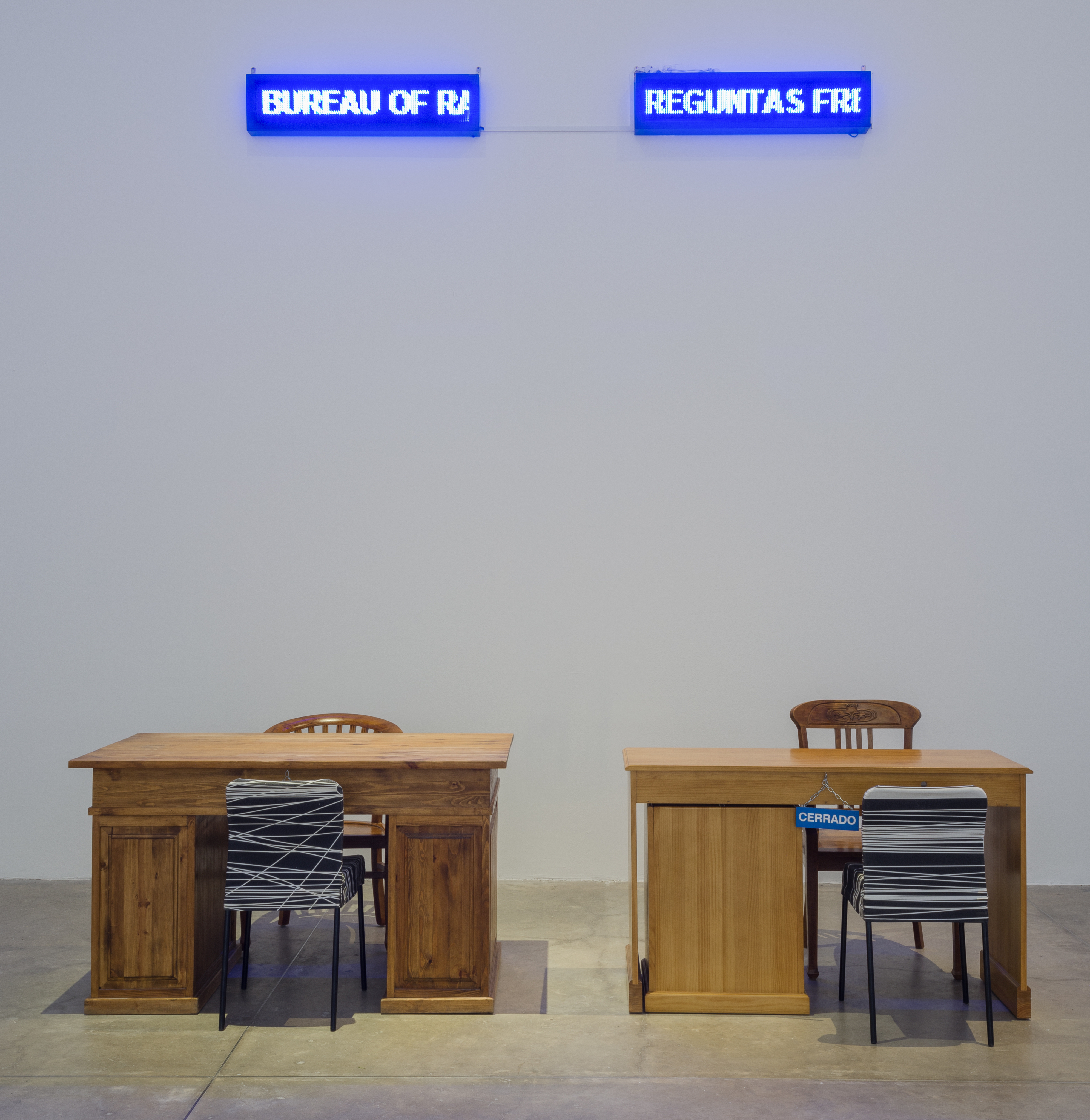
Raqs Media Collective, “Bureau of Raqs and Faqs”, 2015.
Found furniture, index cards, words, plaques, electronic word displays, text and a scenario.
Museo Universitario Arte Contemporaneo (MUAC), Mexico City (2015).
NT: Linking your work to a broader category of artists, or “artist/s” as I define this ‘breed’, it seems that through the act of creating such a name – and to Raqs we should also add “Media Collective” – you distance yourself from two main “pillars” of art making in relationship to authorship: the first one is about giving up the idea of the artist as a singularity, which has been an assumption since, roughly, the Renaissance; the second one sees a direct relationship between the practice of the artist/s and the signature of the artist/s, in which usually, although there are few historical examples like Valie Export, the signature always gives details about the identity of an artist and never about the practice of an artist. Was it a conscious decision? Can you share insights in this regard?
Raqs: Our early sense of collective self is tied to the formation we had in the milieu of documentary film practitioners in the early 1990s. That milieu, unlike art house cinema or the visual arts or literary formations, was not too concerned with signature and oeuvre. The discussion was about ethics, the nature of the flux that got termed “real,” an international traffic of themes, political contingencies and infrastructures refracting on to documentary practice, insurgent worlds and words and then the counter-insurgencies of domination that surrounded the making of the documentary image. For us, the documentary image was always contested and this shaped our thinking. To us, “practice” conjures a contentious field of how to be operative with an alertness to the present. Practice was a site of intense theoretical debate too, and friendships were put to the test through these questionings. In this sense, we argue about ourselves as containing multitudes. And, over time, with research and reflection on the histories of authorship and signature, we have understood how unstable and contentious the solitary genius phenomenon is and how, like many fictions, it emerged from a particular time and a specific cultural-ritual formation. Its rule across time is waning.
In our partnership deed (written in November 1992), a legal-financial requirement to exist as an economic entity, we had given ourselves a purpose, and a range: “documentaries, shorts and features of varying length on film and video, and other works…”; at that time, we did not have a clear idea of what these other works would, or even could, be. However, our understanding of the term media was capacious enough, even then, so as to leave room for “other works” and even how they would work, was in the realm of the unknown. In this sense, both “media” and “practice” are words in anticipation for the intermediaries that they become, as our thoughts and our conversations travel across, between, and through different media.
Raqs: Our early sense of collective self is tied to the formation we had in the milieu of documentary film practitioners in the early 1990s. That milieu, unlike art house cinema or the visual arts or literary formations, was not too concerned with signature and oeuvre. The discussion was about ethics, the nature of the flux that got termed “real,” an international traffic of themes, political contingencies and infrastructures refracting on to documentary practice, insurgent worlds and words and then the counter-insurgencies of domination that surrounded the making of the documentary image. For us, the documentary image was always contested and this shaped our thinking. To us, “practice” conjures a contentious field of how to be operative with an alertness to the present. Practice was a site of intense theoretical debate too, and friendships were put to the test through these questionings. In this sense, we argue about ourselves as containing multitudes. And, over time, with research and reflection on the histories of authorship and signature, we have understood how unstable and contentious the solitary genius phenomenon is and how, like many fictions, it emerged from a particular time and a specific cultural-ritual formation. Its rule across time is waning.
In our partnership deed (written in November 1992), a legal-financial requirement to exist as an economic entity, we had given ourselves a purpose, and a range: “documentaries, shorts and features of varying length on film and video, and other works…”; at that time, we did not have a clear idea of what these other works would, or even could, be. However, our understanding of the term media was capacious enough, even then, so as to leave room for “other works” and even how they would work, was in the realm of the unknown. In this sense, both “media” and “practice” are words in anticipation for the intermediaries that they become, as our thoughts and our conversations travel across, between, and through different media.

Raqs Media Collective, “Tears (are not only from weeping)”, 2021.
Video loop, LED Panel.
Laughter of Tears, Kunstverein Braunschweig, Germany (2021).
NT: Thinking about all these categories, terms and denominations, it would be interesting to hear how the context of India and its related art scene influenced all the aforementioned. It seems to me that what you do and the way you do it represents a unique case, at least in the field of art (not in the field of research, or science.) Would you agree with that? What was the reaction of the Indian artistic community when Raqs Media Collective emerged?
Raqs: At the time when we emerged as a practice, there were attempts by other documentary filmmakers to work as collectives. The notion was not entirely alien. But the idea of collective practice in contemporary art, when we entered that world in the early aughts, was decidedly alien. There had been “movements” – formations in which different individual artists shared common ground based on some understanding, ideology, or sense of being that they held in common and asserted in public life. A “movement” works through a high-intensity coming together of individuals, their works, their stances, their positions. Our sense of who we were, or are, was and still is, completely different. In our case, the work of art happens at the intersection of our wills and a graded intensity of living. Our first major art work in this sense was the making of Sarai, in collaboration with an urbanist and a film historian. Sarai was an adventure in how to think across practices and disciplines, and how to be in public life all the time. With and through Sarai we understood that work gets created through a process of collision and distillation of wills cathected to each other. Sarai hosted many fellowships and discussions, supported exhibitions and published artist writings. But we were not seen as artists. The collective entity of media practitioners that called itself Raqs, triggered hesitations in acknowledging whether its work legitimately fell within the rubric of art. People kept looking for a biography, a self-ethnography, a turn within art historical legibility, or, in short, a signature. There was also some hostility, as our trajectory was not from an art school but from film. Over the last two decades, though, much has changed. We are seen now as occasional transgressors or experimenters, and less as trespassers. The enthusiasm for many of the initiatives that we have since worked on lies hugely with younger artists, and they participate in and enjoy such moves. The last two decades have seen a seismic change in the terms of engagement within contemporary art here. And the biggest transformation from the early 2000s is that there are so many more artists today representing themselves as collectives. This is true for both here, as well as everywhere else. Something in the air has certainly shifted.
Raqs: At the time when we emerged as a practice, there were attempts by other documentary filmmakers to work as collectives. The notion was not entirely alien. But the idea of collective practice in contemporary art, when we entered that world in the early aughts, was decidedly alien. There had been “movements” – formations in which different individual artists shared common ground based on some understanding, ideology, or sense of being that they held in common and asserted in public life. A “movement” works through a high-intensity coming together of individuals, their works, their stances, their positions. Our sense of who we were, or are, was and still is, completely different. In our case, the work of art happens at the intersection of our wills and a graded intensity of living. Our first major art work in this sense was the making of Sarai, in collaboration with an urbanist and a film historian. Sarai was an adventure in how to think across practices and disciplines, and how to be in public life all the time. With and through Sarai we understood that work gets created through a process of collision and distillation of wills cathected to each other. Sarai hosted many fellowships and discussions, supported exhibitions and published artist writings. But we were not seen as artists. The collective entity of media practitioners that called itself Raqs, triggered hesitations in acknowledging whether its work legitimately fell within the rubric of art. People kept looking for a biography, a self-ethnography, a turn within art historical legibility, or, in short, a signature. There was also some hostility, as our trajectory was not from an art school but from film. Over the last two decades, though, much has changed. We are seen now as occasional transgressors or experimenters, and less as trespassers. The enthusiasm for many of the initiatives that we have since worked on lies hugely with younger artists, and they participate in and enjoy such moves. The last two decades have seen a seismic change in the terms of engagement within contemporary art here. And the biggest transformation from the early 2000s is that there are so many more artists today representing themselves as collectives. This is true for both here, as well as everywhere else. Something in the air has certainly shifted.
Raqs Media Collective, “Dohas for Doha”, 2019.
Five Videos, LED screens, variable dimensions.
Still More World, Mathaf Arab Museum of Modern Art, Doha (2019).
NT: Before we go into specific projects, I would like you to tell us how you came up with the following three categories: “practice,” “para-practice,” and “infra-practice.” What goes where? Can you name a project that would fit two of them or even all of them?
Raqs: Over the last two decades we have had incredibly dense associative engagements. We needed to bring this into conceptual focus. Associative engagements are relegated to the background of an event in the way artistic practices usually get narrated. We wanted to bring into view that a zone of extension of the very ground of our practice is driven by associative alignments and affinities. With the prefixes “para” and “infra” we are able to situate a positional movement. The word “para” gestures to a relationship to that which stands beside, or at a tangent to. “Para-practices” are the writings that we do and conversations that we enter into, alongside. It could be the making of a Sourcebook for staging public discursive moments for a plural-knowledge world, or a Curation encapsulating a processual duration along with so many others to re-apprehend the world, or a Studio with students to reimagine the power of margins or thresholds. “Infra” is often glossed as ‘below’ a threshold. In this aspect, we would say that we might be the ones in conversation with or we might have initiated or instigated a process, but we see the authorial impulse as being distributed; as a matter of fact, it may not even coalesce into an entity. Here our practice folds with and within other practices, develops a flow that is in dialogue, yet keeps moving with its own momentum. The associative density that these practices acquire over long periods is unscripted. A cursory glance at the Sarai Readers (01 to 09) over a decade will show how they attracted authors and artists from so many parts of the world, from inner cities to insulated laboratories, from hospital Intensive Care Units to the raging fields of protests. This sediment is what propels the world around us. Practice is the “daily work” (work as verb) of art. It represents the sum of all the moves – practical, conceptual, affective, cognitive, philosophical, analytical and aesthetic – that occupies/de-occupies the state of our collective triangulation at any given point of time. Being contingent, this practice is a shape-shifting thing, prone to surprising itself as much as it surprises others. Like a mycelial inhabitation, indeterminate and unbounded, it expands.
Raqs: Over the last two decades we have had incredibly dense associative engagements. We needed to bring this into conceptual focus. Associative engagements are relegated to the background of an event in the way artistic practices usually get narrated. We wanted to bring into view that a zone of extension of the very ground of our practice is driven by associative alignments and affinities. With the prefixes “para” and “infra” we are able to situate a positional movement. The word “para” gestures to a relationship to that which stands beside, or at a tangent to. “Para-practices” are the writings that we do and conversations that we enter into, alongside. It could be the making of a Sourcebook for staging public discursive moments for a plural-knowledge world, or a Curation encapsulating a processual duration along with so many others to re-apprehend the world, or a Studio with students to reimagine the power of margins or thresholds. “Infra” is often glossed as ‘below’ a threshold. In this aspect, we would say that we might be the ones in conversation with or we might have initiated or instigated a process, but we see the authorial impulse as being distributed; as a matter of fact, it may not even coalesce into an entity. Here our practice folds with and within other practices, develops a flow that is in dialogue, yet keeps moving with its own momentum. The associative density that these practices acquire over long periods is unscripted. A cursory glance at the Sarai Readers (01 to 09) over a decade will show how they attracted authors and artists from so many parts of the world, from inner cities to insulated laboratories, from hospital Intensive Care Units to the raging fields of protests. This sediment is what propels the world around us. Practice is the “daily work” (work as verb) of art. It represents the sum of all the moves – practical, conceptual, affective, cognitive, philosophical, analytical and aesthetic – that occupies/de-occupies the state of our collective triangulation at any given point of time. Being contingent, this practice is a shape-shifting thing, prone to surprising itself as much as it surprises others. Like a mycelial inhabitation, indeterminate and unbounded, it expands.

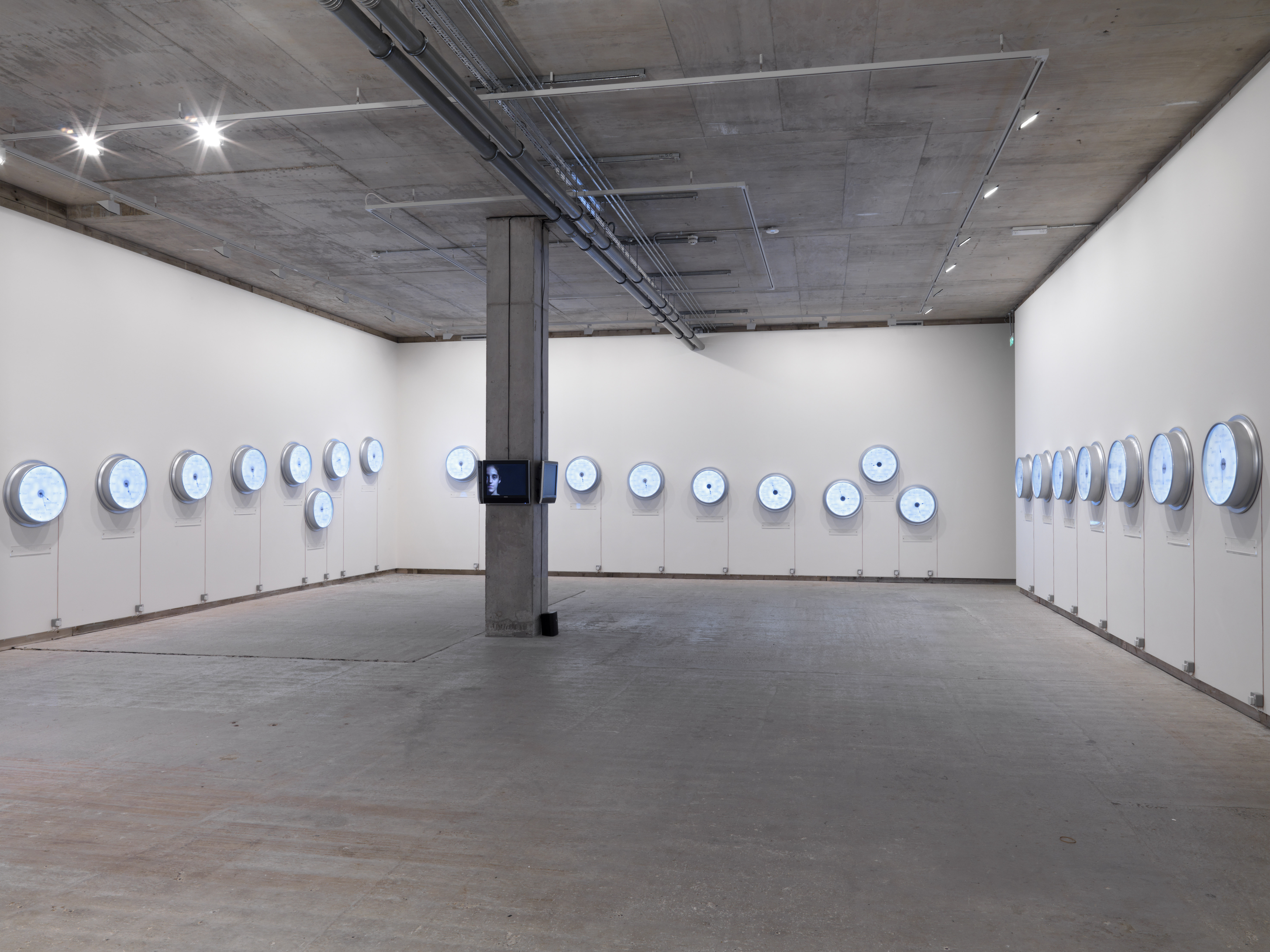
Raqs Media Collective, “Escapement”, 2009.
Installation with 27 clocks, high glass aluminium with LED lights, four flat screen monitors, video and audio looped, dimensions variable.
Frith Street Gallery, London (2009).
NT: Speaking of your practice, I would like to hear about two of your most iconic works: Marks (2011) and Escapement (2009); while the first playfully engages with the sign of communism – the hammer and sickle – and the author of Capital – Karl Marx –, the second brings together time and feelings; on one hand, time seems to be the most objective notion ever conceived by humankind; on the other hand, feelings are the most difficult to define; and yet your work ultimately argues that this is true and yet its opposite is also true. Can you tell us how these works came into being?
Raqs: Marks riffs off the hammer and sickle sign that we have seen scrawled and painted on the walls of our cities since childhood, and condenses a relationship to the signs that we have inherited in – literally – a burst of light and reflection. The reversed question mark, and the inverted exclamation, seem to us to suggest attitudes that require us to ask questions of questions, and register a pause to consider a moment of extraordinary awareness (the reason for exclamation) with a degree of affectionate irony. The intersection of these two attitudes, which marry affect to doubt, affection to questioning, are ways of approaching the legacies we have inherited. As for Escapement, it stems from our ongoing dialogue with the figure of time. Escapement invokes clockwork, emotions, geography, fantasy and time zones to ask what is contemporaneity – what does it mean to be living in these times, in these quickening hours, these accumulating minutes, these multiplying seconds, here, now? Escapement is a horological, or clockmaking term. It denotes the mechanism in mechanical watches and clocks that governs the regular motion of the hands through a “catch and release” device that both releases and restrains the levers that move the hands for hours, minutes and seconds. Like the catch and release of the valves of the heart, allowing for the flow of blood between the chambers of the heart, which sets up the basic rhythm of life, the escapement of a watch regulates our sense of the flow of time. The continued pulsation of our hearts, and the ticking of a clock, denote our liberty from an eternal present.
With each heartbeat, with each passing second, they mark the here and now, promise the future and remember the resonance of the heartbeat that just ended. It is our heart that tells us that we live in time.
Raqs: Marks riffs off the hammer and sickle sign that we have seen scrawled and painted on the walls of our cities since childhood, and condenses a relationship to the signs that we have inherited in – literally – a burst of light and reflection. The reversed question mark, and the inverted exclamation, seem to us to suggest attitudes that require us to ask questions of questions, and register a pause to consider a moment of extraordinary awareness (the reason for exclamation) with a degree of affectionate irony. The intersection of these two attitudes, which marry affect to doubt, affection to questioning, are ways of approaching the legacies we have inherited. As for Escapement, it stems from our ongoing dialogue with the figure of time. Escapement invokes clockwork, emotions, geography, fantasy and time zones to ask what is contemporaneity – what does it mean to be living in these times, in these quickening hours, these accumulating minutes, these multiplying seconds, here, now? Escapement is a horological, or clockmaking term. It denotes the mechanism in mechanical watches and clocks that governs the regular motion of the hands through a “catch and release” device that both releases and restrains the levers that move the hands for hours, minutes and seconds. Like the catch and release of the valves of the heart, allowing for the flow of blood between the chambers of the heart, which sets up the basic rhythm of life, the escapement of a watch regulates our sense of the flow of time. The continued pulsation of our hearts, and the ticking of a clock, denote our liberty from an eternal present.
With each heartbeat, with each passing second, they mark the here and now, promise the future and remember the resonance of the heartbeat that just ended. It is our heart that tells us that we live in time.

Raqs Media Collective, “Marks”, 2011.
Acrylic, MDF, red LEDs, electrical wires, gold mylar sheet.
Headquarters of French Communist Party, 2, Place du Colonel Fabien, Paris (2011); Madrid (2014); Mexico (2015); K21, Dusseldorf, Germany (2018).
NT: Another work I would like you to discuss is The Course of Love (2019), which seems to me the most interesting response to Kosuth’s seminal conceptual works; can you describe its elements and how context – the Setouchi Triennale in Honjima, Japan – influenced its creation?
Raqs: Rivers run dry if they cannot change. So it is with love. It has to irrigate a wider landscape than just what it had to run on when it began. We did not know much about Kosuth at the time when we made this work. But we did know about rivers and boats. Coming from a river valley civilization, we know something about rivers, about boats, and between our mother-tongues, Punjabi and Bengali, we think we have the best river songs and love songs. But for this work, which is sited in Japan, we found a thousand-year-old Japanese love poem that had us by the throat when we read it:
wataru funa-bito / the boatman lost the rudder.
kaji-wo tae / the boat is now adrift
yukue mo shiranu / not knowing where it goes.
koi no michi kana / is this the course of love?
– Sone-no Yoshitada (10th Century CE)
A real boat cradles an “ideal boat.” Just as a moment in life cradles a drifting idea. Love is held by the memory of love. An image is held by itself, afire. In this sculpture with found objects and lenticular fold, we play with light, the geometry of folds, and the optical properties of materials to offer a representation that is as pared down to essentials as a child’s idea of a boat. The Course of Love brings to mind everything from Yoshitada’s evocation of the course of love to the image of a boat on fire in the sea.
In some ways this work is a floating riddle. It reveals more than it conceals with its title. It evokes the childhood D-I-Y-ness of the paper boat that we have all set sail on little streams at one point or another – and by doing so, it points to both the fragility as well as the endurance of paper boats as semaphores to time. Every time you sail a paper boat, you are setting a message on an unknown course. It is more important for us that the message travels than it getting immediately deciphered. It can actually add meaning to itself as it moves, making for the possibility of denser interpretation. Becoming a floating figure of speech, a paper-boat is an instance of the invention of meaning.
Sometimes, like paper boats adrift, we talk to each other in riddles. Sometimes they are difficult, even for us to understand, until they makes sense in a flash. Like sandhya bhasha or Twilight Language, the playful, and sometimes scary language of riddles that is part of our shared cultural inheritance.
Raqs: Rivers run dry if they cannot change. So it is with love. It has to irrigate a wider landscape than just what it had to run on when it began. We did not know much about Kosuth at the time when we made this work. But we did know about rivers and boats. Coming from a river valley civilization, we know something about rivers, about boats, and between our mother-tongues, Punjabi and Bengali, we think we have the best river songs and love songs. But for this work, which is sited in Japan, we found a thousand-year-old Japanese love poem that had us by the throat when we read it:
wataru funa-bito / the boatman lost the rudder.
kaji-wo tae / the boat is now adrift
yukue mo shiranu / not knowing where it goes.
koi no michi kana / is this the course of love?
– Sone-no Yoshitada (10th Century CE)
In some ways this work is a floating riddle. It reveals more than it conceals with its title. It evokes the childhood D-I-Y-ness of the paper boat that we have all set sail on little streams at one point or another – and by doing so, it points to both the fragility as well as the endurance of paper boats as semaphores to time. Every time you sail a paper boat, you are setting a message on an unknown course. It is more important for us that the message travels than it getting immediately deciphered. It can actually add meaning to itself as it moves, making for the possibility of denser interpretation. Becoming a floating figure of speech, a paper-boat is an instance of the invention of meaning.
Sometimes, like paper boats adrift, we talk to each other in riddles. Sometimes they are difficult, even for us to understand, until they makes sense in a flash. Like sandhya bhasha or Twilight Language, the playful, and sometimes scary language of riddles that is part of our shared cultural inheritance.


Raqs Media Collective, “The Course of Love”, 2019.
Sculpture using faceted lenticular panels, with Found Boat.
Setouchi Triennale, Honjima, 2019.
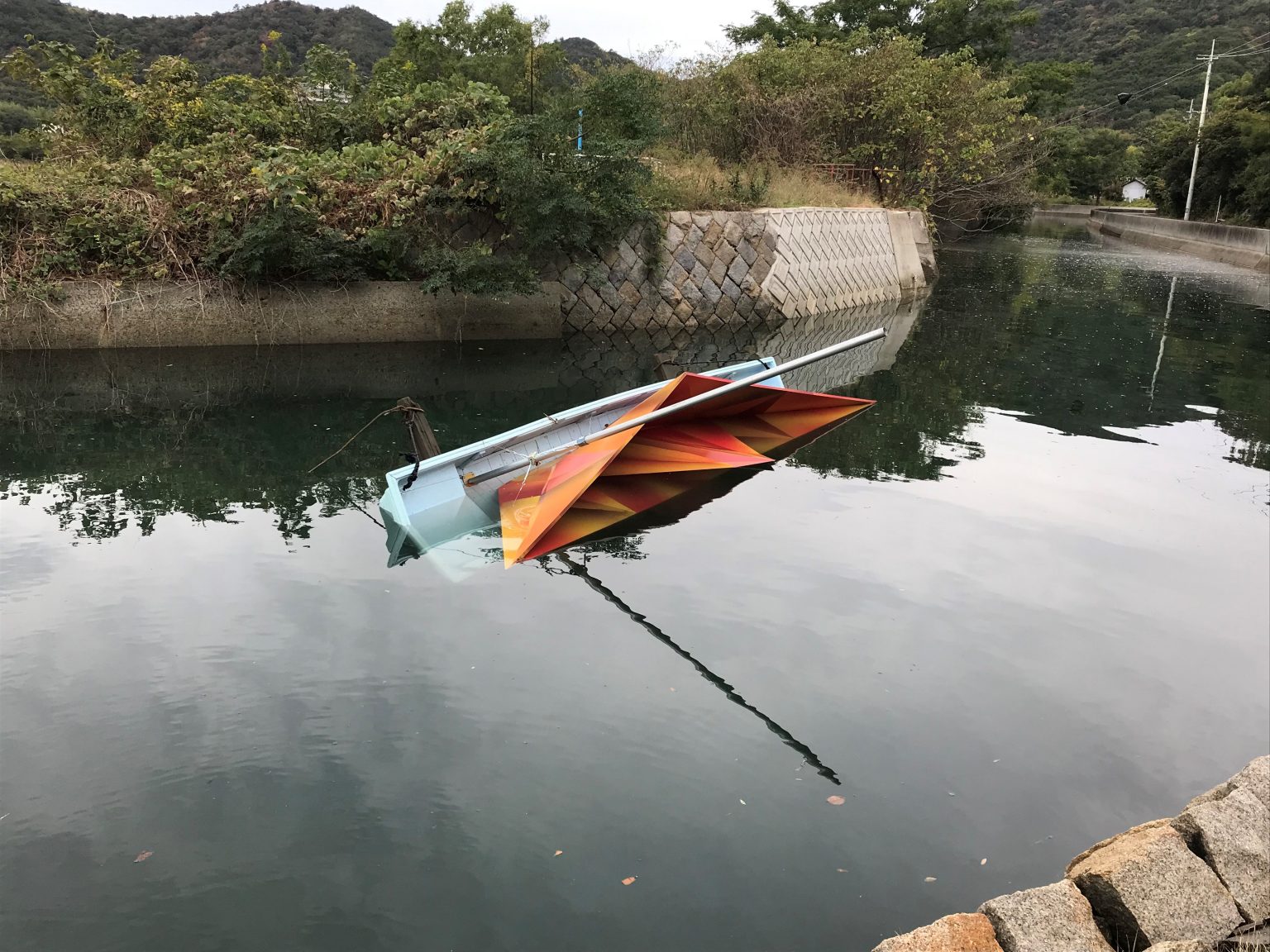
NT: Speaking about your para-practice, I would like you to give us, if possible, the ‘exegesis’ of “Fact, Facticity and the Imagination,” which, if I may say, seems to me the closest to a manifesto of what you do, believe and ultimately are as artist/s. How did you draft this text, how did you present it, what was the reaction, again in India, due to some of its content, and outside of India?
Raqs: We have never made ourselves beholden to a manifesto. Maybe that’s how we survived, because we never ‘betrayed’ our own manifesto. We never had the opportunity to do so. The absence of a manifest ensured that. Fact, Facticity and the Imagination condenses a state of our thinking, holding within it both the desire to engage in forensics and its exactitude, as well as the urge not to be contained or exhausted by it. One of our perennial concerns has been the relationship of qualities and quantities. We understand the propensity to turn every quality, everything intangible and ineffable, like a human life, into a number, as part of the arithmetic of fatality. Art admits to the uncountable, and this essay is a result of the lessons we have learnt from art while trying to understand the urge, particularly of state and state-driven systems, to count and classify everything.
The history of this text takes us back to some of our earliest concerns - the measurement of bodies, and the imperative to harvest usable facts from the measurement of bodies. The text is a meditation on the problems that arise from this endeavor. It is an argument for the worth of the immeasurable. Citizenship itself has become a function of the counting of heads, and creation of different kinds of numbers. This is a legacy of colonialism, but it has been robustly taken forward by the post-colonial state.
Raqs: We have never made ourselves beholden to a manifesto. Maybe that’s how we survived, because we never ‘betrayed’ our own manifesto. We never had the opportunity to do so. The absence of a manifest ensured that. Fact, Facticity and the Imagination condenses a state of our thinking, holding within it both the desire to engage in forensics and its exactitude, as well as the urge not to be contained or exhausted by it. One of our perennial concerns has been the relationship of qualities and quantities. We understand the propensity to turn every quality, everything intangible and ineffable, like a human life, into a number, as part of the arithmetic of fatality. Art admits to the uncountable, and this essay is a result of the lessons we have learnt from art while trying to understand the urge, particularly of state and state-driven systems, to count and classify everything.
The history of this text takes us back to some of our earliest concerns - the measurement of bodies, and the imperative to harvest usable facts from the measurement of bodies. The text is a meditation on the problems that arise from this endeavor. It is an argument for the worth of the immeasurable. Citizenship itself has become a function of the counting of heads, and creation of different kinds of numbers. This is a legacy of colonialism, but it has been robustly taken forward by the post-colonial state.

Raqs Media Collective, “Utsushimi”, 2017.
Double Image / Token / Emanation Materialized Architectural Drawing in Illuminated Wireframe.
Oku-Noto Triennale, Suzu City, Japan (2017 - ongoing).
The essay did not find much resonance in India when it was first published in the Documents of Contemporary Art series (published by Whitechapel) in the book Archive (published in) and in one of the volumes of the Sarai Reader. We think we were a little ahead of the public discourse on identification technologies, surveillance and the anti-democratic turn in India at the time. We were thought of as ‘techno-fetishists’ for a while, even by our liberal, not-so-liberal, and leftist friends. Things are different now: the technology of counting and surveillance is at the heart of politics in India today, as we always said it would be. That says an interesting thing about the relationship between art and politics. Sometimes artists sniff the wind quicker than others can. Now students that we encounter (and not just art students) and young people involved in dissident political currents in India keep coming up with this text as being important to their understanding of the current moment. And they have read it because they could download it, for free, from the Sarai Reader, where it had also been published. Many years after it was written and published, the text continues to have vitality today.
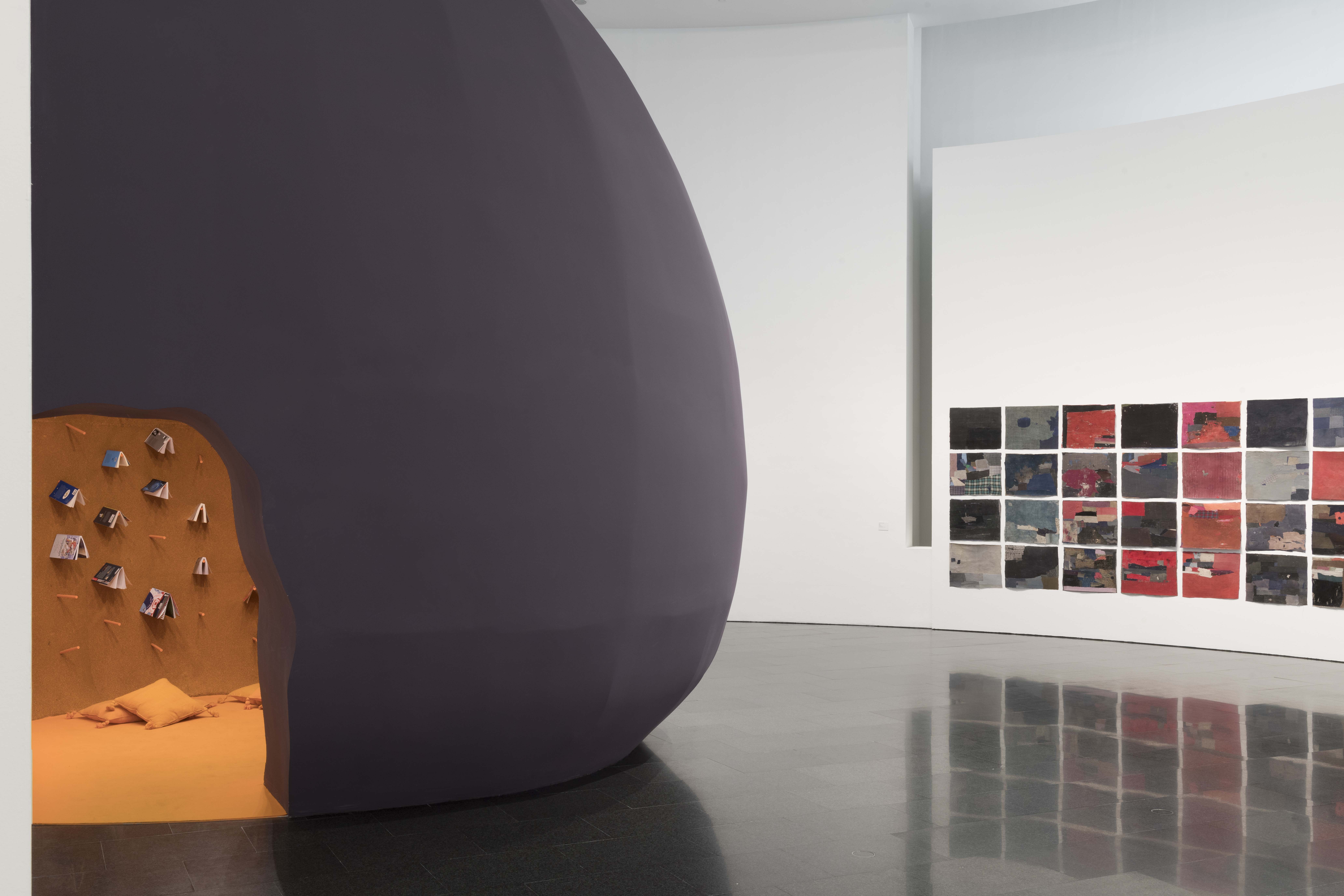
“In the Open or in Stealth”, 2018.
Exhibition curated by Raqs Media Collective,
MACBA Museu d’Art Contemporani de Barcelona (2018-2019).
NT: Can you describe the process behind Seepage, an anthology of your texts published by Sternberg Press in 2010? Are you planning a new anthology after more than 10 years? Would you edit it or give it to someone else to edit and select?
Raqs: The essays in Seepage are about pirates and squatters, hackers and de-occupiers of factories, border-crossers and shape-shifters, about insistent pursuits that crack hard held borders and produce images, spectral or premonitory, of possible other times, another place, in anticipation of a communing for a common world. It is interspersed by 1001 invocations of the granular and ‘metastizing’ power of capital. It has texts as ideas, texts as annotations, and texts as performances. The diligent reader will discover that although printed on paper, the book is a kind of hyper-text, with different parts linking together. You can read the book backwards, forwards, or in a zig zag fashion - switching texts, switching fragments, or even opening random pages at a time and reading against or with the pagination. Seepage is at rest now. Lots of new ideas have taken new forms in new texts. We always try to make them available on our website – branching off of the ‘para-practices’ page.
![]()
Raqs Media Collective, “Seepage”, 2010.
Cover page: Stenberg Press (2010).
NT: Speaking of your infra-practice, I would like you to focus on Sarai, which you established in 2000 with faculty members of the Centre for the Study of Developing Societies (CSDS) in Delhi. This is where you channel your work as researchers. Can you speak about it?
Raqs: Sarai was a capacious urban jungle! It sprang from a simple need that we (and our friends, Ravi Sundaram and Ravi Vasudevan, both theorists, one of new media in the city, and the other, of the history of cinema) felt for a platform where, practitioners, artists, technicians, urbanists, writers, poets, activists and theorists could meet and allow themselves to be transformed by the encounters they had. In retrospect, it is difficult to find a single way of defining what we did at Sarai, except to say that we welcomed the unexpected. It enabled a new way of speaking of the urban and the media condition. Sarai’s critical intervention was to think through the question of intellectual production, its infrastructure, and the politics of threshold. The engagement was to take the authorial as a claim and not as an entitlement. Many people from varied locations articulated and argued how to create, disseminate, translate, transform, and dissent. Through a combination of online and offline modes Sarai innovated on a range of intermedial forms and enunciatory practices. Okwui Enwezor loved Sarai for its persistent practice of producing knowledge-producers, and making knowledge a site of combat. With Sarai we published nine volumes of the Sarai Reader, ran a fellowship program that brought in more than 600 practitioners, artists and researchers to initiate projects, created self-regulated media labs in working class neighborhoods in Delhi, held conferences that would found entire areas of research into the politics of technology, surveillance, intellectual property and its discontents, and actively pursued open possibilities of cultural creativity. It seems like a bit of a dream right now, but we can say that there are many energetic figures in culture, politics and media in India today who have crossed paths with Sarai. Such an initiative would be impossible to replicate in today’s context. But, hopefully, it will inspire future practitioners to shape other kinds of experiments with collectivity and publicness.
Raqs: The essays in Seepage are about pirates and squatters, hackers and de-occupiers of factories, border-crossers and shape-shifters, about insistent pursuits that crack hard held borders and produce images, spectral or premonitory, of possible other times, another place, in anticipation of a communing for a common world. It is interspersed by 1001 invocations of the granular and ‘metastizing’ power of capital. It has texts as ideas, texts as annotations, and texts as performances. The diligent reader will discover that although printed on paper, the book is a kind of hyper-text, with different parts linking together. You can read the book backwards, forwards, or in a zig zag fashion - switching texts, switching fragments, or even opening random pages at a time and reading against or with the pagination. Seepage is at rest now. Lots of new ideas have taken new forms in new texts. We always try to make them available on our website – branching off of the ‘para-practices’ page.

Raqs Media Collective, “Seepage”, 2010.
Cover page: Stenberg Press (2010).
NT: Speaking of your infra-practice, I would like you to focus on Sarai, which you established in 2000 with faculty members of the Centre for the Study of Developing Societies (CSDS) in Delhi. This is where you channel your work as researchers. Can you speak about it?
Raqs: Sarai was a capacious urban jungle! It sprang from a simple need that we (and our friends, Ravi Sundaram and Ravi Vasudevan, both theorists, one of new media in the city, and the other, of the history of cinema) felt for a platform where, practitioners, artists, technicians, urbanists, writers, poets, activists and theorists could meet and allow themselves to be transformed by the encounters they had. In retrospect, it is difficult to find a single way of defining what we did at Sarai, except to say that we welcomed the unexpected. It enabled a new way of speaking of the urban and the media condition. Sarai’s critical intervention was to think through the question of intellectual production, its infrastructure, and the politics of threshold. The engagement was to take the authorial as a claim and not as an entitlement. Many people from varied locations articulated and argued how to create, disseminate, translate, transform, and dissent. Through a combination of online and offline modes Sarai innovated on a range of intermedial forms and enunciatory practices. Okwui Enwezor loved Sarai for its persistent practice of producing knowledge-producers, and making knowledge a site of combat. With Sarai we published nine volumes of the Sarai Reader, ran a fellowship program that brought in more than 600 practitioners, artists and researchers to initiate projects, created self-regulated media labs in working class neighborhoods in Delhi, held conferences that would found entire areas of research into the politics of technology, surveillance, intellectual property and its discontents, and actively pursued open possibilities of cultural creativity. It seems like a bit of a dream right now, but we can say that there are many energetic figures in culture, politics and media in India today who have crossed paths with Sarai. Such an initiative would be impossible to replicate in today’s context. But, hopefully, it will inspire future practitioners to shape other kinds of experiments with collectivity and publicness.

Yokohama Triennale 2020, Artistic Directors: Raqs Media Collective.
Artwork by Nick Cave, “Kinetic Spinner”, 2016.
Photo by Otsuka Keita.
NT: Until now we discussed artmaking, writing and researching and now I would like you to hear how you engage with exhibition making (a term I prefer over “curating”); can you speak about how you exhibit the work of other artists? What is your approach, considering that you are most of the time “on the other side” (being invited to exhibit)? Would you organize an exhibition for one single artist? Who would this artist be? Within the context of group exhibitions: Do you prefer to commission new works or select existing works? Can you say a few words about your project for Manifesta?
Raqs: On the occasion of “Manifesta,” we were given an abandoned aluminum factory to work in. And this prompted us to think about the ‘residue’ of industrial production – what gets left behind. This is the ‘rest’, the ‘remainder’, the ‘dregs’ of capital. But the word ‘rest’ can also mean a moment of pause, and recuperation of that which is left behind. We played with both senses of the word to come up with the idea of “the rest of now,” which also became the title of the exhibition. When making exhibitions, it could be said that we work like detectives, building a ‘case’ from the clues and traces we find. Our invitation to the artists we want to work with is a proposal to join us in this process. To make discoveries, parallel to ours. The exhibition is a diagram that holds the image of these processes in play. We want exhibitions, especially recurring exhibitions, to be moments of generation. For so many artists, including ourselves, commissions support the practice, and we think exhibition-making is a possibility towards ensuring that new works can be made. But there is also a pleasure in rediscovery, and in the re-playing of works in entirely new contexts. Recently, for a group exhibition we curated at MACBA in Barcelona, entitled “In the Open or in Stealth: The Unruly Presence of an Intimate Future” we exhibited the medical and scientific drawings of Santiago Ramon y Cajal, the pioneering and visionary Spanish neuroscientist who drew the most exquisite renditions of neural pathways. There were many contemporary artists in that show, some of them were making new work that was going to be shown for the first time, but then there was also this long-dead scientist, whose work was very alive. It was in this show that we started working with an awareness of “sources” as part of our curatorial methodology. By this we mean a toolkit of prompts that we shared with the artists we invited. This was a method to start a conversation that would take us in different directions. The navigation of this path reveals us to ourselves, to our colleagues, and to the world. We would like to answer the rest of your question by borrowing an answer we gave in another interview (as yet unpublished) to the art journalist Heniz Norbert Jocks. In it, we say:
“Our curatorial practice does not concern itself with the elaboration of a set theme or topic through the arrangement of works that ‘illustrate’ it. Nor do we create exhibitions with the intention to make people aware of that which they did not know. These can be worthy motives for exhibition making, it is just that they are not ours.
Our practice works its way out through a constant interplay between what we call ‘sources’ and their flux. Think of this as the course of a river. A river can have a ‘source’, or more than one set of ‘sources’. In its journey to the sea, it divides into tributaries, and is joined by the streams of rivers that begin in other ‘sources’. There are riverine islands. The river changes course, ebbs and flows. Finally it meets the sea, often creating a complex deltaic form.
We think of exhibition making somewhat along these lines. We identify ‘sources’ that interest us, these often lie at the intersection of the space we are working in, and ideas, concepts, images or states of feeling that seems to us to be pertinent to that space. This constellation is arrived at, partly by diligent research into the history, fables, topography, economy of a particular space, or a network, and partly by instinct, and partly by the constant churning within our practice of the things we are thinking and feeling.
Then, we elaborate the sources, enter into conversations with the artists and practitioners that we want to engage with, and this process leads to the formation of multiple streams and tributaries. Material – in the form of ideas, images, correspondence – ‘flows’ between us, the ‘source’ and our interlocutors. And this leads to a layering of the organic curatorial intelligence of the process. (Think of the way in which a river carries soil and silt, depositing it on flood plains, making it possible for them to be fecund, etc.)
In this way, the continued interaction between the ‘source’ and the streams creates a landscape, a terrain, of the exhibition. This terrain takes shape in our mind, and then is translated, as a process that can actually inhabit the space and time of the exhibition”.
Raqs: On the occasion of “Manifesta,” we were given an abandoned aluminum factory to work in. And this prompted us to think about the ‘residue’ of industrial production – what gets left behind. This is the ‘rest’, the ‘remainder’, the ‘dregs’ of capital. But the word ‘rest’ can also mean a moment of pause, and recuperation of that which is left behind. We played with both senses of the word to come up with the idea of “the rest of now,” which also became the title of the exhibition. When making exhibitions, it could be said that we work like detectives, building a ‘case’ from the clues and traces we find. Our invitation to the artists we want to work with is a proposal to join us in this process. To make discoveries, parallel to ours. The exhibition is a diagram that holds the image of these processes in play. We want exhibitions, especially recurring exhibitions, to be moments of generation. For so many artists, including ourselves, commissions support the practice, and we think exhibition-making is a possibility towards ensuring that new works can be made. But there is also a pleasure in rediscovery, and in the re-playing of works in entirely new contexts. Recently, for a group exhibition we curated at MACBA in Barcelona, entitled “In the Open or in Stealth: The Unruly Presence of an Intimate Future” we exhibited the medical and scientific drawings of Santiago Ramon y Cajal, the pioneering and visionary Spanish neuroscientist who drew the most exquisite renditions of neural pathways. There were many contemporary artists in that show, some of them were making new work that was going to be shown for the first time, but then there was also this long-dead scientist, whose work was very alive. It was in this show that we started working with an awareness of “sources” as part of our curatorial methodology. By this we mean a toolkit of prompts that we shared with the artists we invited. This was a method to start a conversation that would take us in different directions. The navigation of this path reveals us to ourselves, to our colleagues, and to the world. We would like to answer the rest of your question by borrowing an answer we gave in another interview (as yet unpublished) to the art journalist Heniz Norbert Jocks. In it, we say:
“Our curatorial practice does not concern itself with the elaboration of a set theme or topic through the arrangement of works that ‘illustrate’ it. Nor do we create exhibitions with the intention to make people aware of that which they did not know. These can be worthy motives for exhibition making, it is just that they are not ours.
Our practice works its way out through a constant interplay between what we call ‘sources’ and their flux. Think of this as the course of a river. A river can have a ‘source’, or more than one set of ‘sources’. In its journey to the sea, it divides into tributaries, and is joined by the streams of rivers that begin in other ‘sources’. There are riverine islands. The river changes course, ebbs and flows. Finally it meets the sea, often creating a complex deltaic form.
We think of exhibition making somewhat along these lines. We identify ‘sources’ that interest us, these often lie at the intersection of the space we are working in, and ideas, concepts, images or states of feeling that seems to us to be pertinent to that space. This constellation is arrived at, partly by diligent research into the history, fables, topography, economy of a particular space, or a network, and partly by instinct, and partly by the constant churning within our practice of the things we are thinking and feeling.
Then, we elaborate the sources, enter into conversations with the artists and practitioners that we want to engage with, and this process leads to the formation of multiple streams and tributaries. Material – in the form of ideas, images, correspondence – ‘flows’ between us, the ‘source’ and our interlocutors. And this leads to a layering of the organic curatorial intelligence of the process. (Think of the way in which a river carries soil and silt, depositing it on flood plains, making it possible for them to be fecund, etc.)
In this way, the continued interaction between the ‘source’ and the streams creates a landscape, a terrain, of the exhibition. This terrain takes shape in our mind, and then is translated, as a process that can actually inhabit the space and time of the exhibition”.
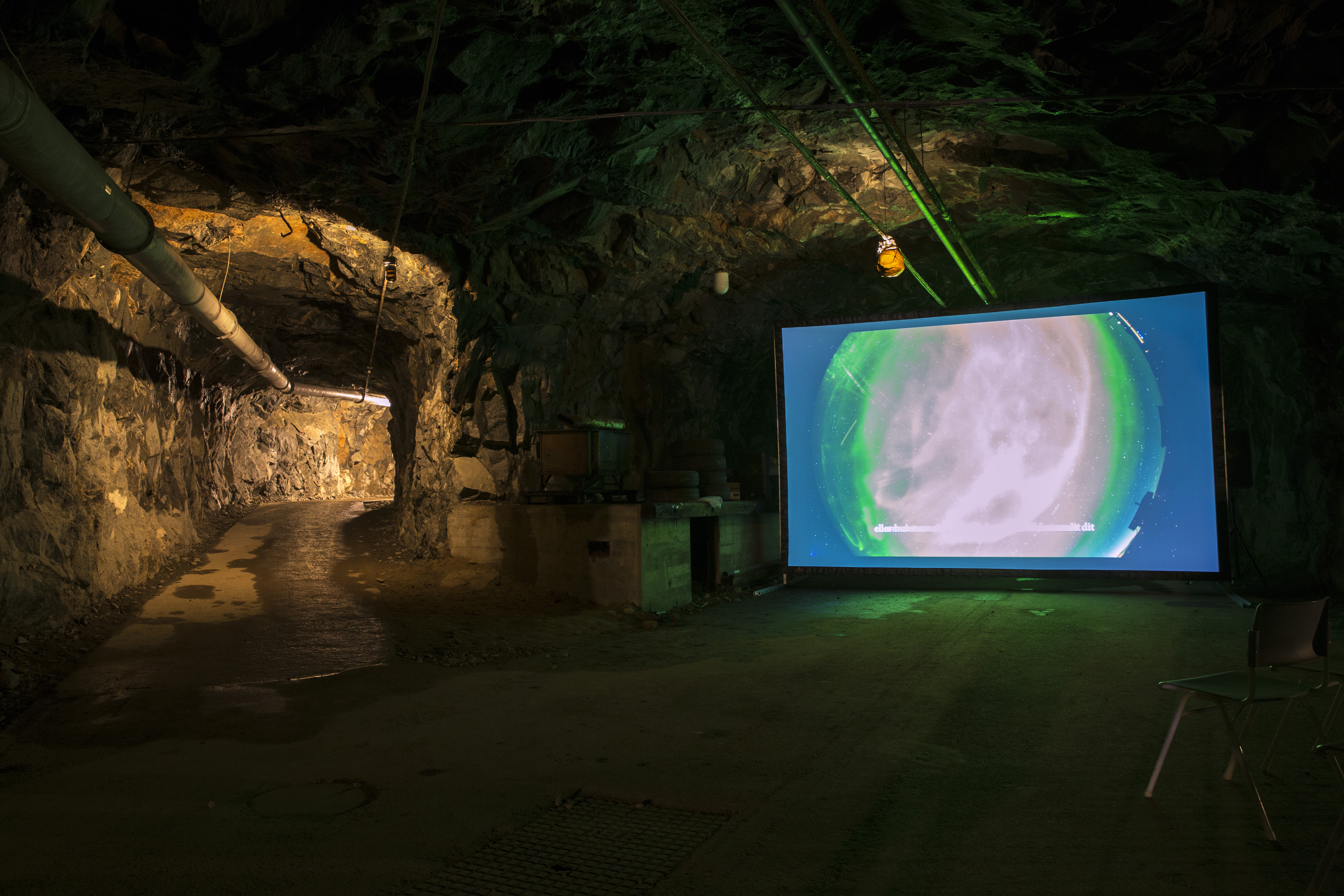
Raqs Media Collective, “Blood of Stars: A walk in ten scenes”, 2013.
Single screen, video.
Extracts from a Future History, Lulea (2013).
NT: My last question is: What is the future of Raqs Media Collective? Do you see yourself emphasizing one aspect of your practices over the others? Do you imagine Raqs Media Collective continuing in perpetuity, carried by other individuals?
Raqs: When we began, as Raqs, in 1992, we had no idea of what the future would be. The future came to us a year, a month, a day, an hour at a time. It still does. Raqs Media Collective is the continuing contingency that arose from three individuals, and persists, in that fashion. It makes no claim on immortality. However, barring the unlikely event of an airplane that all three of us are on, which somehow drops from the sky and crashes into a mountain or falls into the sea, it is unlikely that all three of us will exit the game at exactly the same time. In our partnership deed of 1992, we had written, as point 14 of the charter: “14. The firm shall not stand dissolved upon death, retirement or insolvency of any partner but upon dissolution.” That means, that even if one or the other of us dies, before the other two, Raqs will continue with whosoever is left. That is also the case if one of us decides to leave. Those who remain will constitute Raqs. But Raqs can dissolve only if the three of us decide to dissolve it, not otherwise. Raqs will cease, when we cease. Raqs is what comes out of the three of us, now and in the past and, as long as our bodies and minds can take it, in the future. Now, unlike when we formed as Raqs, there is also a history to the practice. So the future sometimes emerges from the things that we had ourselves forgotten. Recently, while doing a bit of spring cleaning in our studio, we opened an old suitcase and found stacks of papers, notes and photographs from the earliest days. Some of these pointed to a sea voyage we took in our first year to an archipelago in the Bay of Bengal. The curiosities that were born on that voyage are still with us. They beckon to us both from the past, as well as from the future. The question “how do we deal with the urge to fix an identity as well as the impulse to change over time?,” which we began asking while thinking about the practice of anthropological photography in the Andaman Islands (we were trying to make a film on that subject, which is still not yet made) can now be asked about our practice as well.
We are changing, growing, our minds are traveling in lateral directions, sometimes in tandem with each other, sometimes getting derailed and then catching up. In these diversions and detournements, there are many futures lurking. Our work is changing. We see new concerns, an active engagement with questions of energy and vitality, the reconstitution of the commons (not just in a material sense, but also more intangibly, as in a commons of what is “between us in the air”). We think a lot nowadays about toxins and toxicity, about the disappearance and appearance of forms of life, and organic connections between life forms. We are listening more to the planet and what we think it whispers. We are beginning to be more frank with each other about many things we were silent about. All this will change us. It will make our futures grow wilder, like a forest.
Raqs: When we began, as Raqs, in 1992, we had no idea of what the future would be. The future came to us a year, a month, a day, an hour at a time. It still does. Raqs Media Collective is the continuing contingency that arose from three individuals, and persists, in that fashion. It makes no claim on immortality. However, barring the unlikely event of an airplane that all three of us are on, which somehow drops from the sky and crashes into a mountain or falls into the sea, it is unlikely that all three of us will exit the game at exactly the same time. In our partnership deed of 1992, we had written, as point 14 of the charter: “14. The firm shall not stand dissolved upon death, retirement or insolvency of any partner but upon dissolution.” That means, that even if one or the other of us dies, before the other two, Raqs will continue with whosoever is left. That is also the case if one of us decides to leave. Those who remain will constitute Raqs. But Raqs can dissolve only if the three of us decide to dissolve it, not otherwise. Raqs will cease, when we cease. Raqs is what comes out of the three of us, now and in the past and, as long as our bodies and minds can take it, in the future. Now, unlike when we formed as Raqs, there is also a history to the practice. So the future sometimes emerges from the things that we had ourselves forgotten. Recently, while doing a bit of spring cleaning in our studio, we opened an old suitcase and found stacks of papers, notes and photographs from the earliest days. Some of these pointed to a sea voyage we took in our first year to an archipelago in the Bay of Bengal. The curiosities that were born on that voyage are still with us. They beckon to us both from the past, as well as from the future. The question “how do we deal with the urge to fix an identity as well as the impulse to change over time?,” which we began asking while thinking about the practice of anthropological photography in the Andaman Islands (we were trying to make a film on that subject, which is still not yet made) can now be asked about our practice as well.
We are changing, growing, our minds are traveling in lateral directions, sometimes in tandem with each other, sometimes getting derailed and then catching up. In these diversions and detournements, there are many futures lurking. Our work is changing. We see new concerns, an active engagement with questions of energy and vitality, the reconstitution of the commons (not just in a material sense, but also more intangibly, as in a commons of what is “between us in the air”). We think a lot nowadays about toxins and toxicity, about the disappearance and appearance of forms of life, and organic connections between life forms. We are listening more to the planet and what we think it whispers. We are beginning to be more frank with each other about many things we were silent about. All this will change us. It will make our futures grow wilder, like a forest.
A Kassen, Ponds, 2017.
Copenhagen Contemporary,
Copenhagen, Denmark, 2017.
Copenhagen Contemporary,
Copenhagen, Denmark, 2017.
The members of A Kassen met while studying together at the Royal Danish Academy of Fine Arts in Copenhagen and have been working together ever since. “Togetherness” is a key aspect of their practice, and as they say, every decision is taken collectively while “no one has a certain specific role”. Spanning from monumental outdoor interventions to almost imperceptible gestures in various exhibition spaces, the work of A Kassen brings art, architecture, and design into a new realm in which a conceptual, playful approach is paired with a subtle critique of various kinds of display systems. Publishing is another key channel of their practice, and they have experimented with various book formats. They are currently finalizing their first comprehensive monograph, while also working on a book focused on their site-specific works. Nicola Trezzi interviewed the collective about their versatile practice.
Nicola Trezzi: Can you tell us about the meaning of your name and why you chose it?
A Kassen: The Danish meaning of A Kassen is a concept that we adopted very early on, even before we were a group and needed a name. It occurred very organically and intuitively, just like almost everything else in our collaboration. Another thing that is common for our group is that we have four different views on the same matter, and therefore the meaning of and the reason why we chose the name A Kassen could be answered in multiple ways. One would be that it starts with an A, which comes in quite handy sometimes. Another is that, for people outside of Denmark, it is not understood, but you could try to imagine what it is — for instance, the initials of a person’s first name. Furthermore, although the concept of A Kassen is originally positive, it is a thing you don’t want to be associated with. For all these reasons, we thought that it was the right name for the group. Additionally, the meaning of A Kassen — which defines the unemployment benefit system in Denmark — is not the most important thing about our name. Very similar to our artworks, such a choice reflects the desire to apply new meaning, social meaning, to things we are familiar with, that have a context and a function.
A Kassen: The Danish meaning of A Kassen is a concept that we adopted very early on, even before we were a group and needed a name. It occurred very organically and intuitively, just like almost everything else in our collaboration. Another thing that is common for our group is that we have four different views on the same matter, and therefore the meaning of and the reason why we chose the name A Kassen could be answered in multiple ways. One would be that it starts with an A, which comes in quite handy sometimes. Another is that, for people outside of Denmark, it is not understood, but you could try to imagine what it is — for instance, the initials of a person’s first name. Furthermore, although the concept of A Kassen is originally positive, it is a thing you don’t want to be associated with. For all these reasons, we thought that it was the right name for the group. Additionally, the meaning of A Kassen — which defines the unemployment benefit system in Denmark — is not the most important thing about our name. Very similar to our artworks, such a choice reflects the desire to apply new meaning, social meaning, to things we are familiar with, that have a context and a function.

A Kassen, Bronze Pour, 2020.
Liquid bronze poured into water.
The instant solidified material is subsequently
enlarged and made as bronze sculptures.
Bronze, 138 x 126 x 136 cm.
Courtesy of the artists and Galleri Nicolai Wallner, Copenhagen.

A Kassen, Bronze Pour, 2020.
Liquid bronze poured into water.
The instant solidified material is subsequently
enlarged and made as bronze sculptures.
Bronze, 72 x 122 x 45 cm.
Courtesy of the artists and Galleri Nicolai Wallner, Copenhagen.
NT: Do you think the Danish context and its social fabric have influenced your way of working?
AK: It probably has, since working together and togetherness is very present in the Danish school system. Our government is mostly a minority government. We are a small country, and we learn early on that we should work together.
NT: Your work is very playful, and the notion of scale often plays a pivotal role in the way you create your work. Do you see any connection between these two elements?
AK: We are not so sure if scale plays a central role in our work, but then again, our upcoming book, which we are currently finalizing with Mousse Publishing, is named Dimensions Variable. So of course, size, either small or large, is something that needs to be considered when developing new projects. But since we often work with objects from the ‘real world’, size is already a given — unless the idea is based on skewing the perception of the object.
AK: It probably has, since working together and togetherness is very present in the Danish school system. Our government is mostly a minority government. We are a small country, and we learn early on that we should work together.
NT: Your work is very playful, and the notion of scale often plays a pivotal role in the way you create your work. Do you see any connection between these two elements?
AK: We are not so sure if scale plays a central role in our work, but then again, our upcoming book, which we are currently finalizing with Mousse Publishing, is named Dimensions Variable. So of course, size, either small or large, is something that needs to be considered when developing new projects. But since we often work with objects from the ‘real world’, size is already a given — unless the idea is based on skewing the perception of the object.

A Kassen, Ponds, 2017.
Coffee is spilled on the floor plan of the exhibition space.
The stains are subsequently made as coffee
ponds in the exhibition space at the same location,
size and shape as the floor plan dictates.
Copenhagen Contemporary,
Copenhagen, Denmark, 2017.

NT: Can you give an example? What would be a work by A Kassen that is “skewing the perception of the object”?
AK: For our graduate exhibition, we added a plaster rosette to the ceiling of the exhibition space of GL STRAND — located in an old historic building from the 1700s in Copenhagen. We had chosen a chocolate biscuit to constitute the shape, and then enlarged it in white plaster so it would blend in with the rest of the stucco decorating the building. Two so very different things — a rosette and a chocolate biscuit — intertwined in the same object and yet with an obvious overlap of forms.
AK: For our graduate exhibition, we added a plaster rosette to the ceiling of the exhibition space of GL STRAND — located in an old historic building from the 1700s in Copenhagen. We had chosen a chocolate biscuit to constitute the shape, and then enlarged it in white plaster so it would blend in with the rest of the stucco decorating the building. Two so very different things — a rosette and a chocolate biscuit — intertwined in the same object and yet with an obvious overlap of forms.
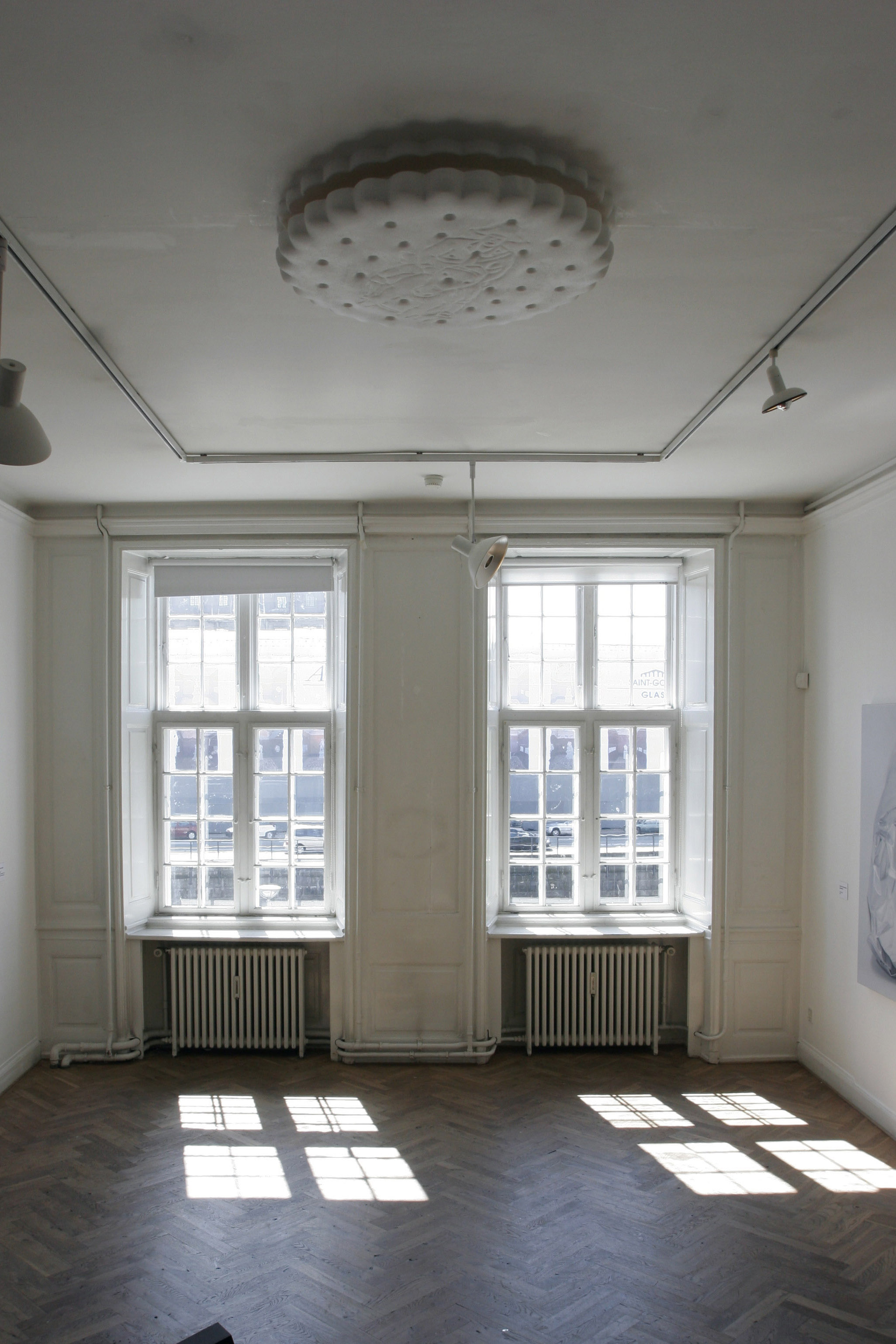
A Kassen, Rosette, 2007.
Stucco, installation view at GL STRAND, Copenhagen.
Courtesy of the artists.
NT: What is the most extreme project you have done and why?
AK: That is a funny question. “Extreme” is normally not a notion we define with any of our projects. On the other hand, it is understandable to be asked this. Extreme could probably be seen in the same way as being playful… and it could go in two directions… Here, scale or size could be the question, again. For the work Drip, we hired an 80-year-old stand to catch drips from a ‘wine leakage’ coming from the ceiling. Could we define this act as extreme? We also copied 200 works of art by 17 artists who were supposed to participate in the exhibition for the Carnegie Art Award, which was cancelled. We presented them in some of the venues where the exhibition was supposed to take place; by doing that, we confused guests and critics.
AK: That is a funny question. “Extreme” is normally not a notion we define with any of our projects. On the other hand, it is understandable to be asked this. Extreme could probably be seen in the same way as being playful… and it could go in two directions… Here, scale or size could be the question, again. For the work Drip, we hired an 80-year-old stand to catch drips from a ‘wine leakage’ coming from the ceiling. Could we define this act as extreme? We also copied 200 works of art by 17 artists who were supposed to participate in the exhibition for the Carnegie Art Award, which was cancelled. We presented them in some of the venues where the exhibition was supposed to take place; by doing that, we confused guests and critics.
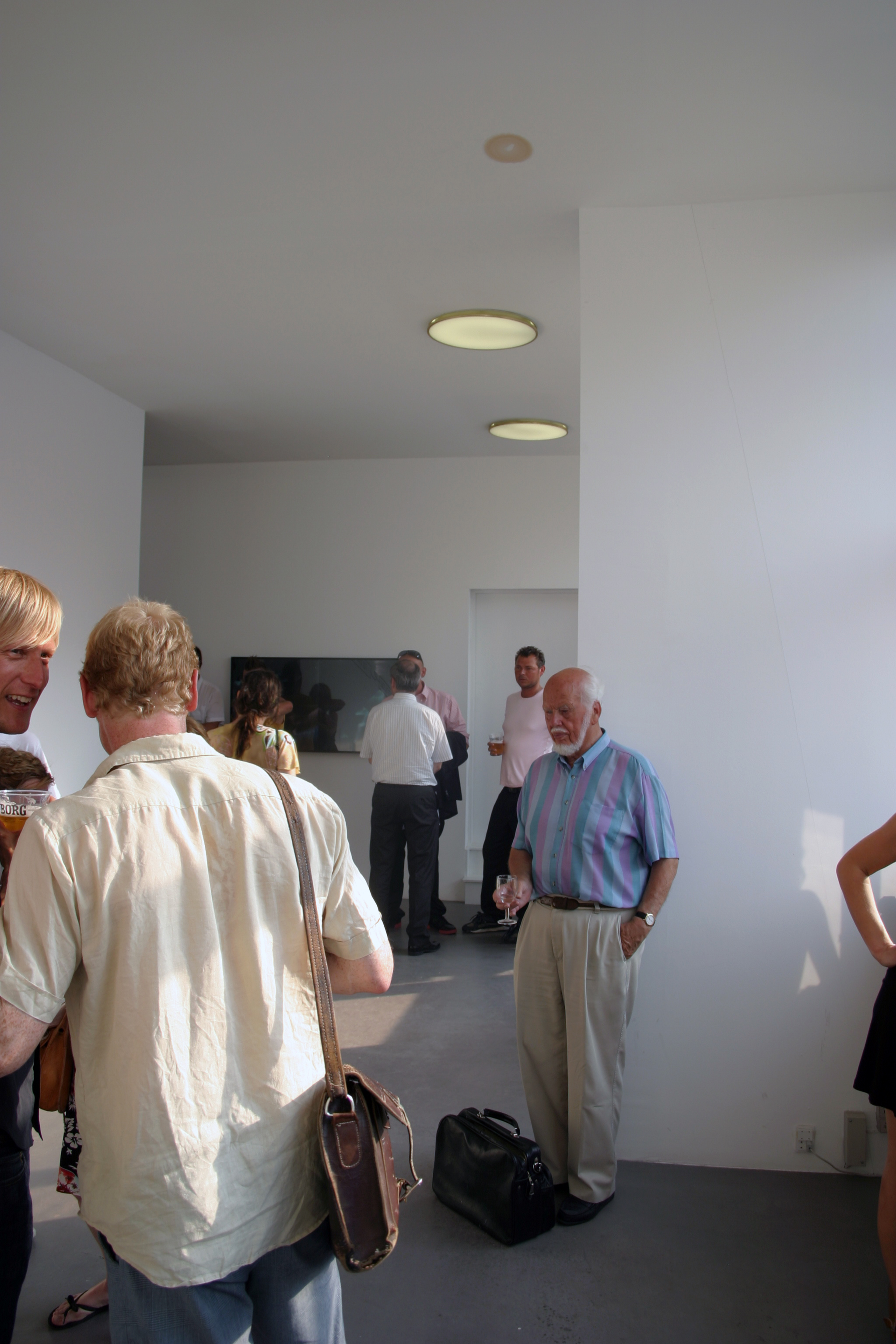
A Kassen, Drip, 2006.
White wine drips from the ceiling in the gallery.
A stand-in with a wine glass catches the drops.
Mixed media, installation and performance view at Galleri Nicolai Wallner, Copenhagen.
Nicola Trezzi: NT: How many are you? What is the division of labor? Do you decide everything collectively or split projects between yourselves?
AK: We are four guys who met each other at the Royal Danish Academy of Fine Arts in Copenhagen and have been working together for about 17 years. We decide everything collectively, so no one has a certain specific role except Tommy, who makes the salad for lunch.
NT: Site-specificity often comes with your work, and yet it comes in a new way that is less connected to the history of art, land art, and more as a new understanding of institutional critique. Would you agree with such an association, and if so, what would be the artwork that encapsulates such association the best?
AK: Window to the World, which we did in MUSAC, might be such a type of work. Here, we took out six large window panes from the facade of the museum and replaced them with plywood boards. Inside the museum, the window panes were installed as three sets of automatic sliding doors connected at their center. The sculpture was activated by the movement of the audience and itself. We have never associated ourselves with institutional critique, but as you say, it might be a new understanding of institutional critique, because it has been so integrated in the works of the artists we have been looking at and inspired by since our studies.
AK: We are four guys who met each other at the Royal Danish Academy of Fine Arts in Copenhagen and have been working together for about 17 years. We decide everything collectively, so no one has a certain specific role except Tommy, who makes the salad for lunch.
NT: Site-specificity often comes with your work, and yet it comes in a new way that is less connected to the history of art, land art, and more as a new understanding of institutional critique. Would you agree with such an association, and if so, what would be the artwork that encapsulates such association the best?
AK: Window to the World, which we did in MUSAC, might be such a type of work. Here, we took out six large window panes from the facade of the museum and replaced them with plywood boards. Inside the museum, the window panes were installed as three sets of automatic sliding doors connected at their center. The sculpture was activated by the movement of the audience and itself. We have never associated ourselves with institutional critique, but as you say, it might be a new understanding of institutional critique, because it has been so integrated in the works of the artists we have been looking at and inspired by since our studies.

A Kassen, Window to the World, 2009.
Six window panes are taken out of the facade of the museum and replaced by plywood boards.
The window panes are installed into three sets of automatic sliding doors connected at their centre.
The sculpture is activated by the movement of the audience and itself.
Mixed media, installation view [outside] at MUSAC, León (Spain).
Courtesy of the artists, Galleri Nicolai Wallner,
Copenhagen, and Maisterravalbuena, Madrid.
NT: It would be interesting to hear who the artists are whose works inspired you back then and if those works still inspire you today.
AK: Elmgreen & Dragset and Superflex have been sources of inspiration for us since they started as emerging artists in Denmark, and also because they showed us that it would be possible to work together, either as a duo or a group. We could also mention, randomly, Olafur Eliasson, Roman Signer, Pipilotti Rist, Kishio Suga, Roman Ondak, Michael Asher, Chris Burden, and Sofie Calle… But we could probably come up with another 20 artists; this is what comes to mind right now. Being four individuals working together leads to openness and generates interest going in many directions. Almost all the time we have a common intuition or idea of what is interesting, and yet each of us react and contribute to this same idea in very different ways, coming to it from different perspectives. The result is always idiosyncratic, even when it doesn’t seem to be!
AK: Elmgreen & Dragset and Superflex have been sources of inspiration for us since they started as emerging artists in Denmark, and also because they showed us that it would be possible to work together, either as a duo or a group. We could also mention, randomly, Olafur Eliasson, Roman Signer, Pipilotti Rist, Kishio Suga, Roman Ondak, Michael Asher, Chris Burden, and Sofie Calle… But we could probably come up with another 20 artists; this is what comes to mind right now. Being four individuals working together leads to openness and generates interest going in many directions. Almost all the time we have a common intuition or idea of what is interesting, and yet each of us react and contribute to this same idea in very different ways, coming to it from different perspectives. The result is always idiosyncratic, even when it doesn’t seem to be!

A Kassen, Atlas, 2016.
A statue of Atlas is cut up into units corresponding with the dimensions of cobblestones.
Foundation CAB, Brussels, Belgium, 2016.
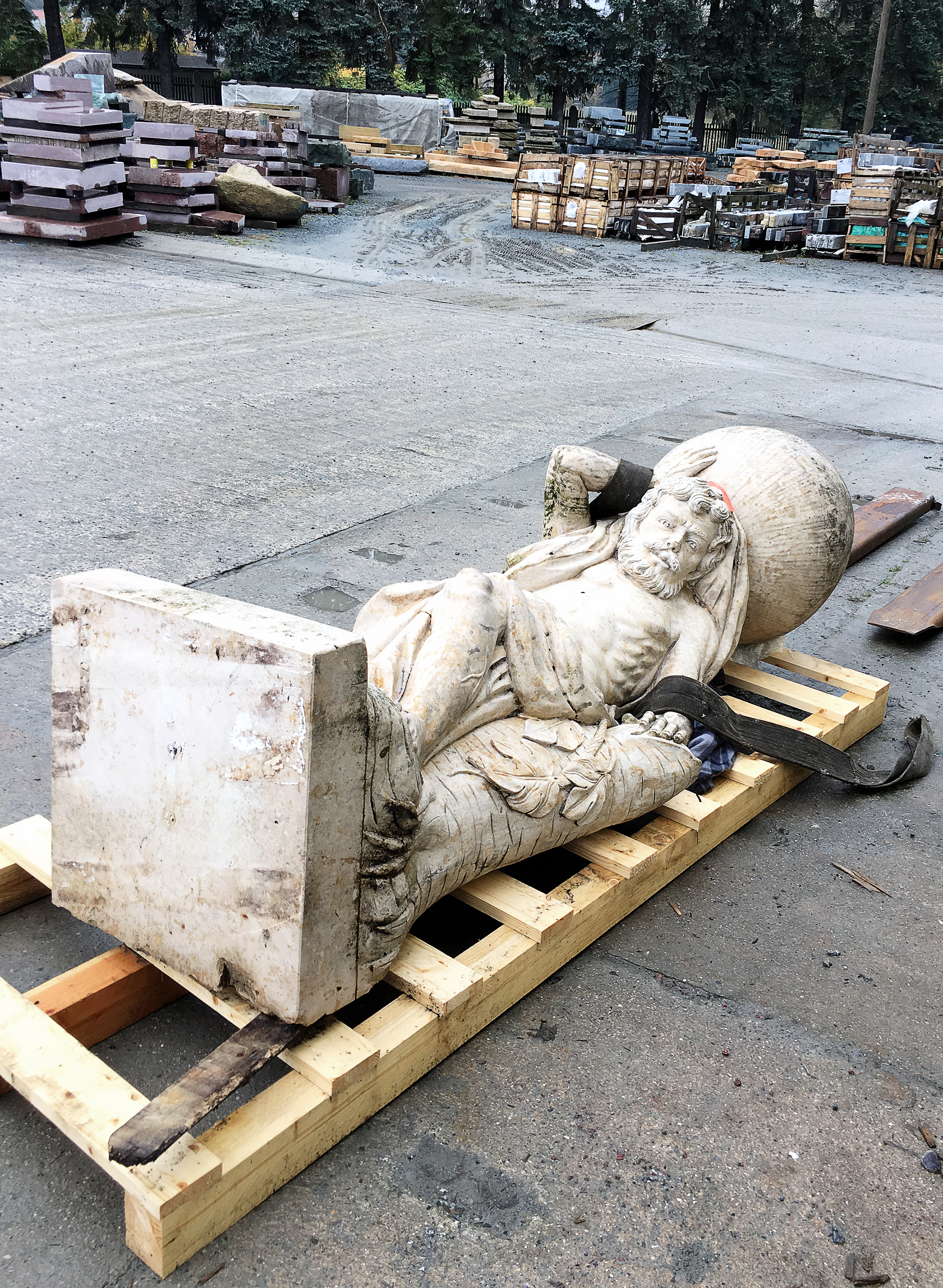
NT: Although your works always have a degree of aesthetic power, the process is often what really matters. At the same time, that process is not always disclosed. Does this bother you?
AK We believe that even though artworks don’t always disclose what led to their existence, they often radiate the underlying process or energy that has been put into them. Such understanding can be seen as another aspect to the work in which an important role is given to storytelling. When we ‘dig in’ and explore the full range of a project — taking time to understand all the different aspects related to it and the thoughts behind its making — the appreciation is often greater.
AK We believe that even though artworks don’t always disclose what led to their existence, they often radiate the underlying process or energy that has been put into them. Such understanding can be seen as another aspect to the work in which an important role is given to storytelling. When we ‘dig in’ and explore the full range of a project — taking time to understand all the different aspects related to it and the thoughts behind its making — the appreciation is often greater.

A Kassen, Mirrors, 2013.
Scans of antique mirrors
up for auction are taken from
the Sotheby’s catalogue, they are then printed at actual size,
framed and put for auction again at Sotheby’s.
Sotheby’s New York, US, 2013.
Nicola Trezzi: This last thought makes me think of some of your books that clearly reveal a mechanism behind your work, which could be seen, at times, as a rumination on the metalinguistic nature of art making. In other words, making art is, ultimately and simply, about making art. Would you agree?
AK: Not totally. Making art is about inspiring the ones experiencing it. It serves several goals. We see it as a personal way of expressing what we have on our minds and at the same time empowering the viewer, who has the possibility of getting new input, new ideas, new perspectives. It makes you start thinking about things you hadn’t given a thought. There are so many unexplored ‘poetic holes’ in society and in life in general, and artists are good at shedding light on these holes. Revealing a mechanism behind a work is to set focus on a given system.
NT: I have two questions regarding the aforementioned monograph you are currently finalizing: What have you understood through this process? Any surprising threads going from work to work, any leitmotiv you did not consider?
AK: We didn’t learn a thing! [laughs] We are privileged to have done and still be doing lots of projects. Everyday things are fascinating and yet they can be easily overlooked. So this publication will emphasize things we know but sort of forgot. For instance: How do puddles look? They are really beautiful, no matter which shape they take. No big new meaning surfaced during the process — although after finalizing the selection of works to be included, we all feel like making another monograph with works that didn’t make the final cut. Another book that might give new insights would probably be one focused on site-specific works and works integrated with architecture, published by Arkitektens Forlag. For this book, we are working with an architect who is making technical drawings for each work, and such decisions will probably generate new understandings of this side of our practice. Translating our work into the language of architectural drawing will undoubtedly unfold different perspectives.
AK: Not totally. Making art is about inspiring the ones experiencing it. It serves several goals. We see it as a personal way of expressing what we have on our minds and at the same time empowering the viewer, who has the possibility of getting new input, new ideas, new perspectives. It makes you start thinking about things you hadn’t given a thought. There are so many unexplored ‘poetic holes’ in society and in life in general, and artists are good at shedding light on these holes. Revealing a mechanism behind a work is to set focus on a given system.
NT: I have two questions regarding the aforementioned monograph you are currently finalizing: What have you understood through this process? Any surprising threads going from work to work, any leitmotiv you did not consider?
AK: We didn’t learn a thing! [laughs] We are privileged to have done and still be doing lots of projects. Everyday things are fascinating and yet they can be easily overlooked. So this publication will emphasize things we know but sort of forgot. For instance: How do puddles look? They are really beautiful, no matter which shape they take. No big new meaning surfaced during the process — although after finalizing the selection of works to be included, we all feel like making another monograph with works that didn’t make the final cut. Another book that might give new insights would probably be one focused on site-specific works and works integrated with architecture, published by Arkitektens Forlag. For this book, we are working with an architect who is making technical drawings for each work, and such decisions will probably generate new understandings of this side of our practice. Translating our work into the language of architectural drawing will undoubtedly unfold different perspectives.
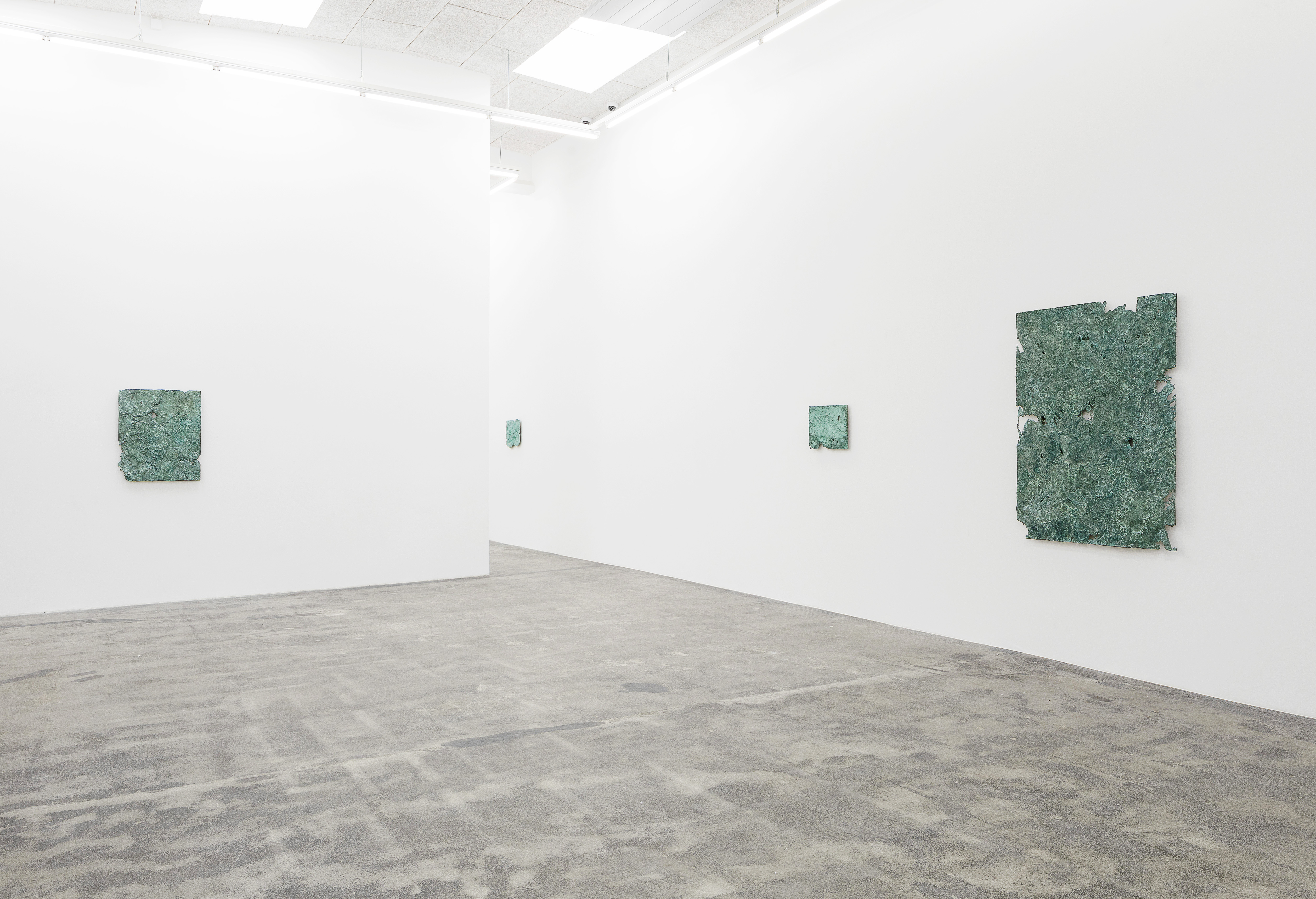
A Kassen, Bronze Pour, 2020.
Liquid bronze poured into water. The instant solidified material is subsequently enlarged and made as bronze sculptures.
Bronze, 138 x 126 x 136 cm.
Courtesy of the artists and Galleri Nicolai Wallner, Copenhagen.

A Kassen, Bronze Pour, 2020.
Liquid bronze poured into water.
The instant solidified material is subsequently
enlarged and made as bronze sculptures.
Bronze, 72 x 122 x 45 cm.
Courtesy of the artists and Galleri Nicolai Wallner, Copenhagen.
NT: In my view, your practice goes against the two most important parameters associated with the creation of art since The Lives of Giorgio Vasari: There is no ‘real’ signature — in fact, the signature can be considered a work of art in itself. And there is no individual — you say “We are four guys”, but you could be 400. While this is what brought me to your work in the first place, it does not fit the contemporary art market, which still heavily relies on romanticized clichés such as uniqueness, originality… art as the creation of a demiurge. At the same time, you have a continuous relationship with private galleries such as Galleri Nicolai Wallner in Copenhagen. Can you share some thoughts about this side of your work?
AK: Apropos, we are currently working on a solo exhibition for Maisterravalbuena, the gallery in Madrid we have been working with since 2009. They are moving to a new location and asked us to present their final exhibition in the space they have had for the last ten years. Considering the fact that our work often asks to physically alter the exhibition space, they probably thought since they are giving up the space, which will most probably be ripped apart and renovated, that this is a good opportunity to let us do whatever we like.
![]()
A Kassen, Permanent Reflection, 2013.
Two photographs depicting the
reflections of their own framing glass.
Inkjet print, 185 × 145 cm (each);
installation view at Lund Konsthall (Sweden)
[in the foreground: work by Rolf Nowotny].
Courtesy of the artists, Galleri Nicolai Wallner, Copenhagen,
and Maisterravalbuena, Madrid.
Photo: Terje Östling.
Lund Konsthall, Lund, Sweden, 2015
AK: Apropos, we are currently working on a solo exhibition for Maisterravalbuena, the gallery in Madrid we have been working with since 2009. They are moving to a new location and asked us to present their final exhibition in the space they have had for the last ten years. Considering the fact that our work often asks to physically alter the exhibition space, they probably thought since they are giving up the space, which will most probably be ripped apart and renovated, that this is a good opportunity to let us do whatever we like.
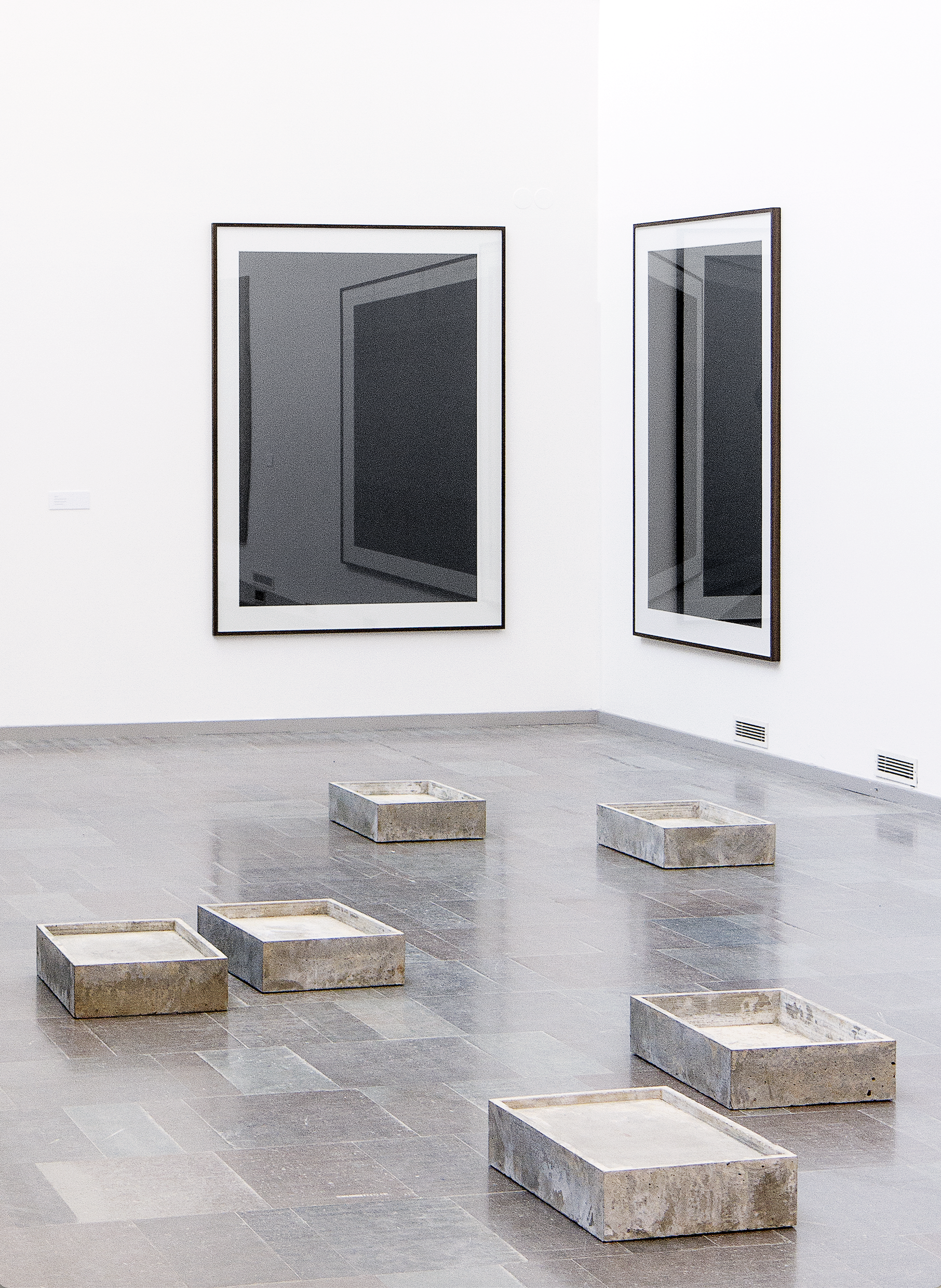
A Kassen, Permanent Reflection, 2013.
Two photographs depicting the
reflections of their own framing glass.
Inkjet print, 185 × 145 cm (each);
installation view at Lund Konsthall (Sweden)
[in the foreground: work by Rolf Nowotny].
Courtesy of the artists, Galleri Nicolai Wallner, Copenhagen,
and Maisterravalbuena, Madrid.
Photo: Terje Östling.
Lund Konsthall, Lund, Sweden, 2015
NT: You also do a lot a of commissions… Would you like to mention one or two you are particularly excited by?
AK: Yes! Making art for a city or a bank is super interesting. How can you make people relate to an artwork presented in an unusual context? How do you make sure the artwork won’t become invisible due to the context in which it is presented? These are good challenges. We just finished a commission for the Danish Police at their new academy in Vejle, Denmark. It took four years to complete, but it has been a positive process. Indeed, over the last several years, we have put a lot of energy into doing public commissions. As talked about earlier, our works often deal with site-specificity, so public commissions have been a natural development of our practice. It gives us the opportunity to react to a certain setting, whether that be the architecture, social constructions, or anything else that captures our interest in that specific place. Endless Lamppost is a project like that. It is a public commission for a train station in Denmark where we are going to exchange an existing lamppost with a 30-meter-high lamppost… OK, you got us there! Scale and playfulness are, sometimes, pivotal aspects of our works.
AK: Yes! Making art for a city or a bank is super interesting. How can you make people relate to an artwork presented in an unusual context? How do you make sure the artwork won’t become invisible due to the context in which it is presented? These are good challenges. We just finished a commission for the Danish Police at their new academy in Vejle, Denmark. It took four years to complete, but it has been a positive process. Indeed, over the last several years, we have put a lot of energy into doing public commissions. As talked about earlier, our works often deal with site-specificity, so public commissions have been a natural development of our practice. It gives us the opportunity to react to a certain setting, whether that be the architecture, social constructions, or anything else that captures our interest in that specific place. Endless Lamppost is a project like that. It is a public commission for a train station in Denmark where we are going to exchange an existing lamppost with a 30-meter-high lamppost… OK, you got us there! Scale and playfulness are, sometimes, pivotal aspects of our works.
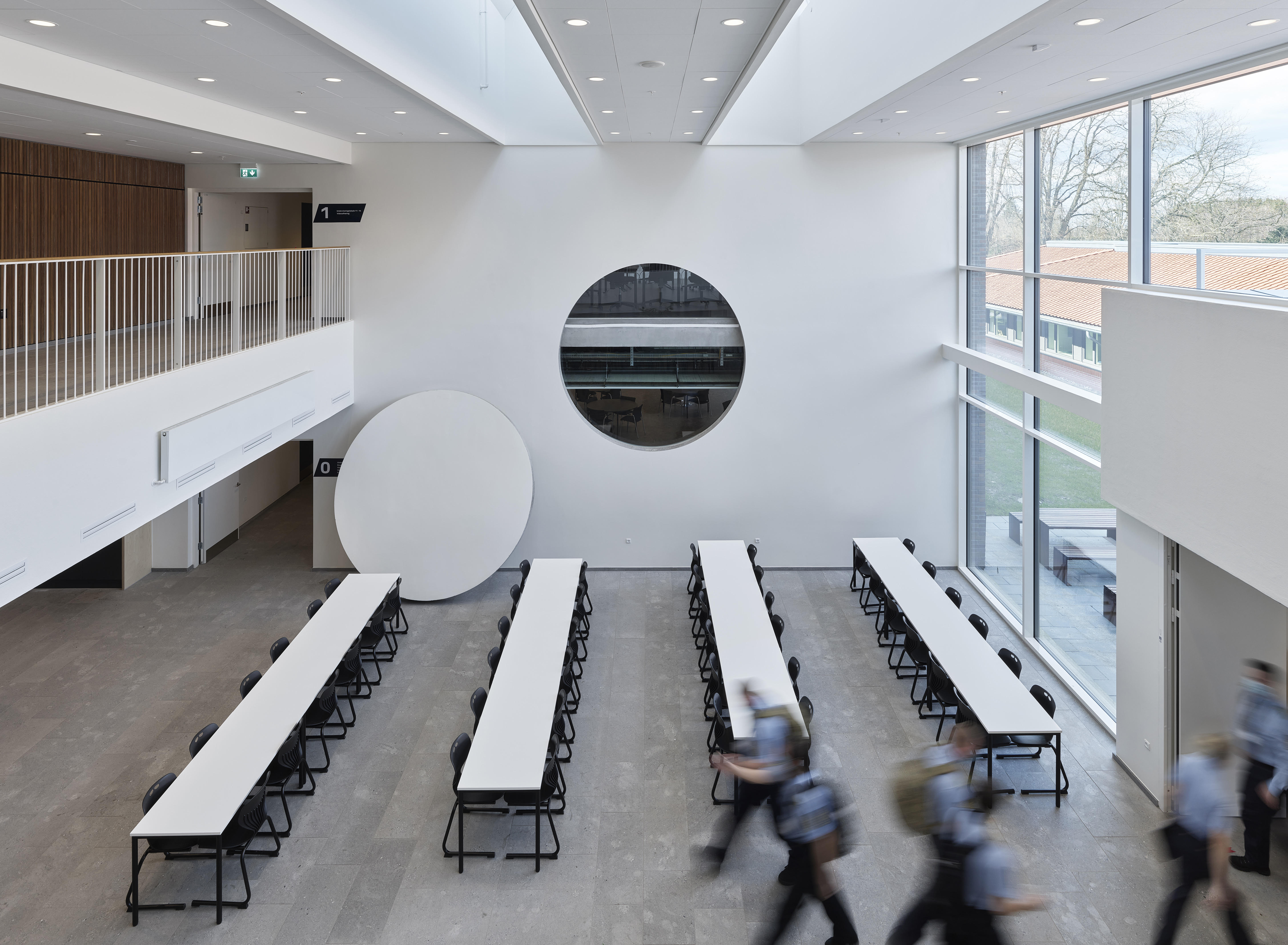
A Kassen, Foundation, 2021.
In the double height canteen a circle is cut out of the wall,
revealing the first floor structure of the building and creating
connections between the different spaces and floors.
The circular cut-out is placed leaning against the wall in the canteen.
Mixed media, installation view at the
Police Academy in West Denmark for the Danish National Police (UVC).
Police academy, Vejle, Denmark, 2021
Courtesy of the artists.

